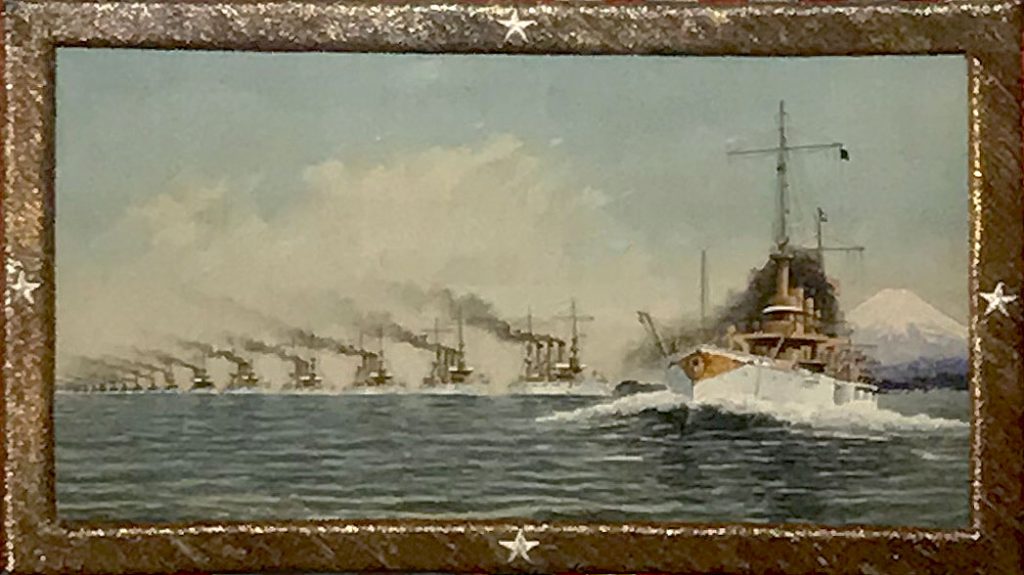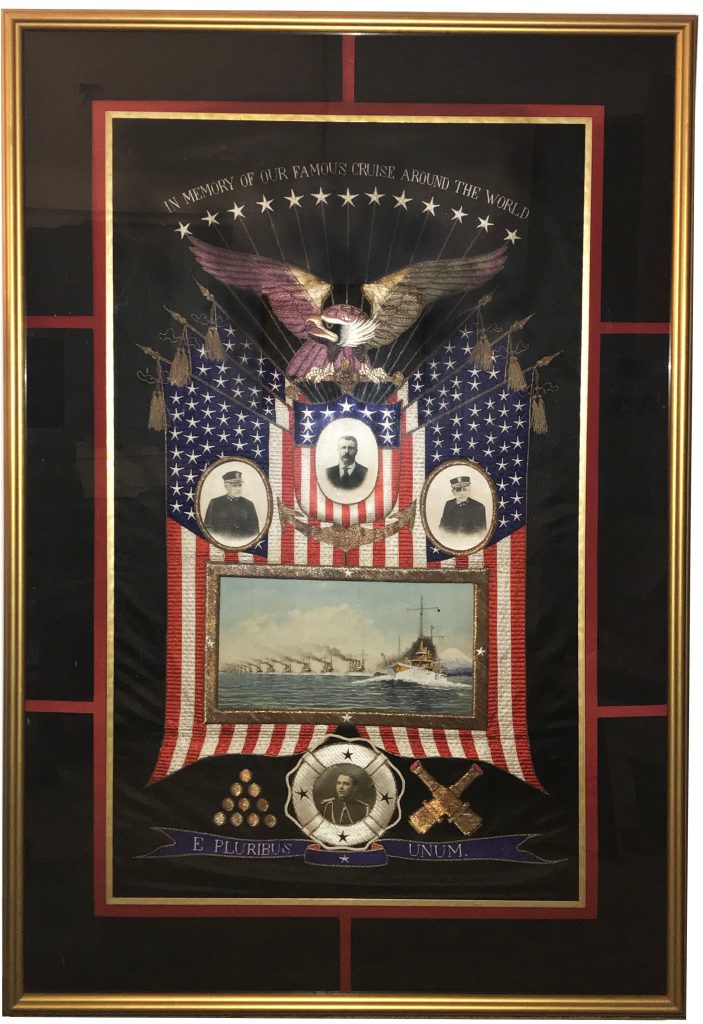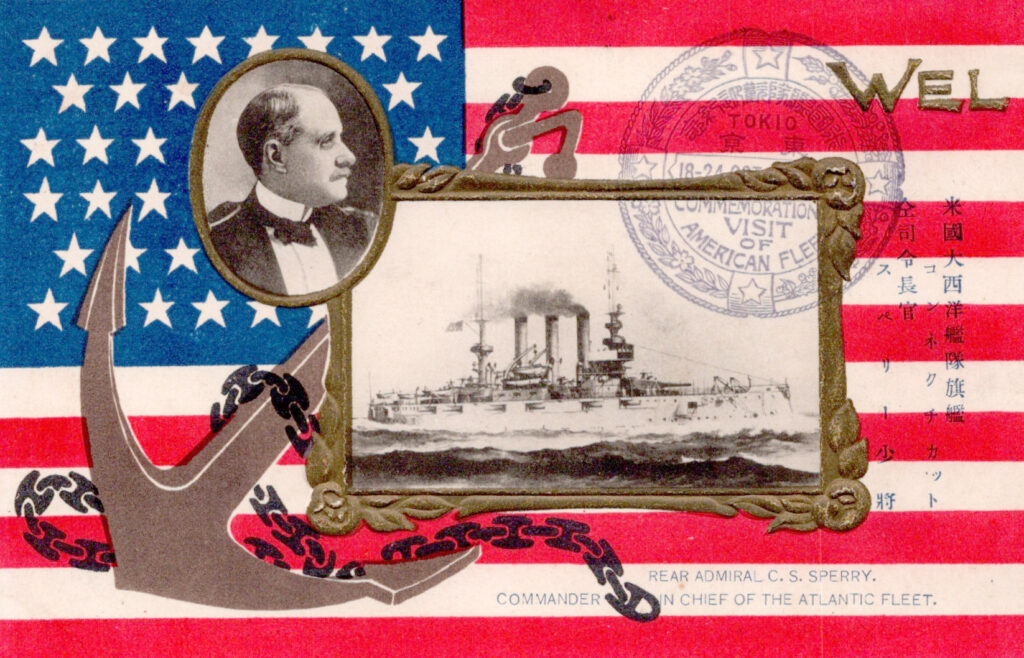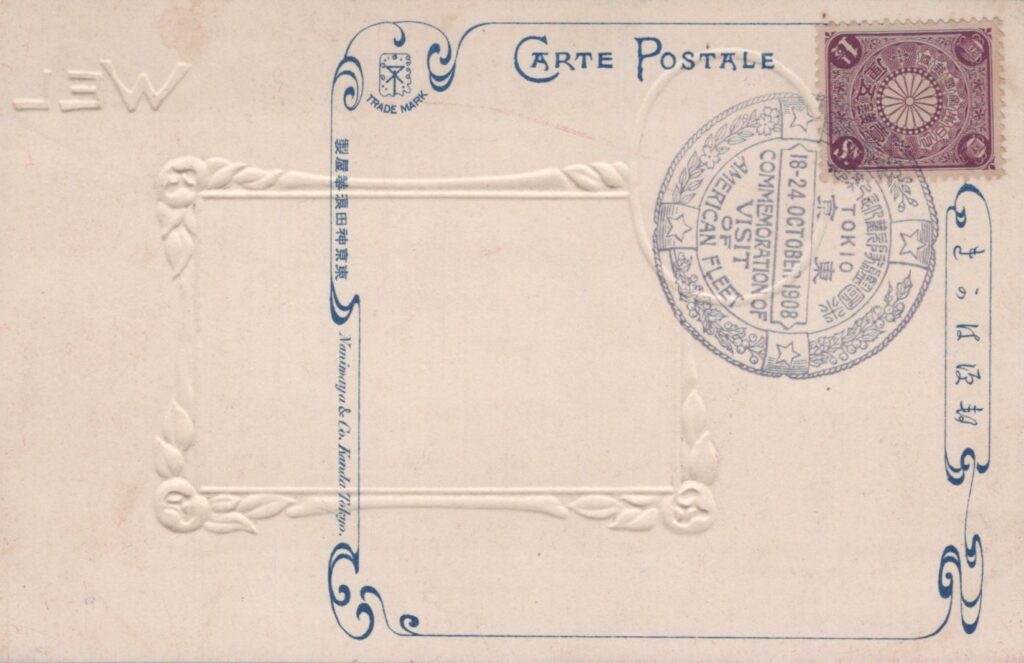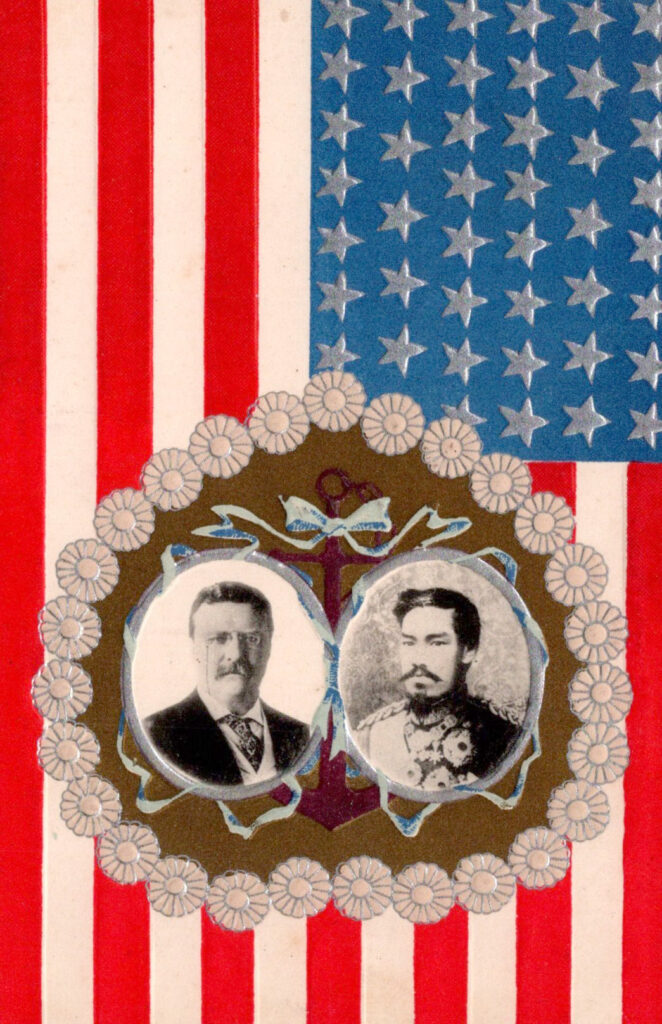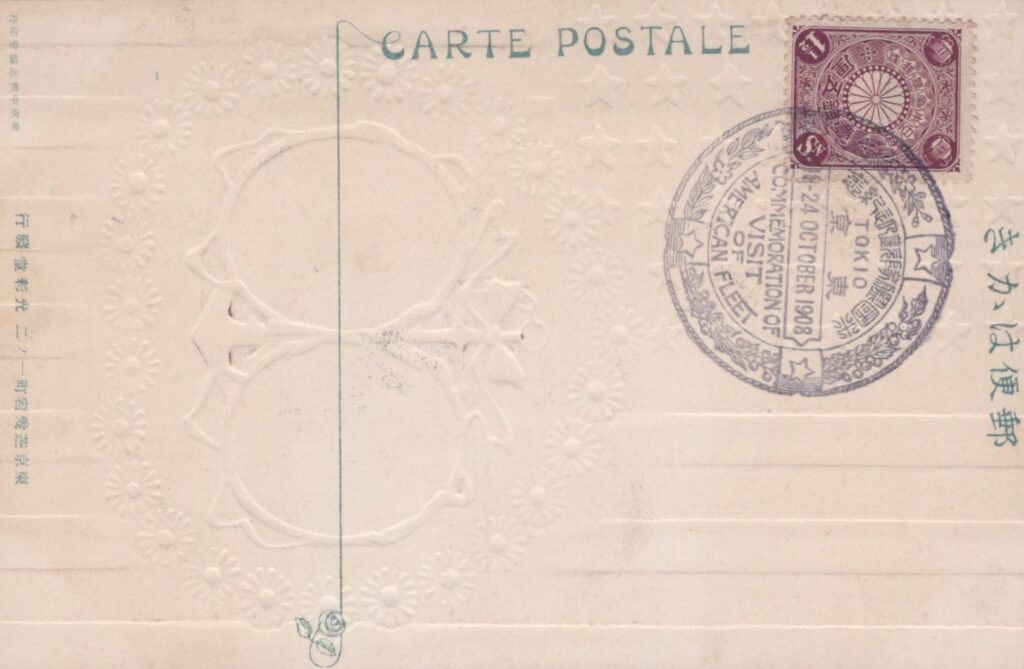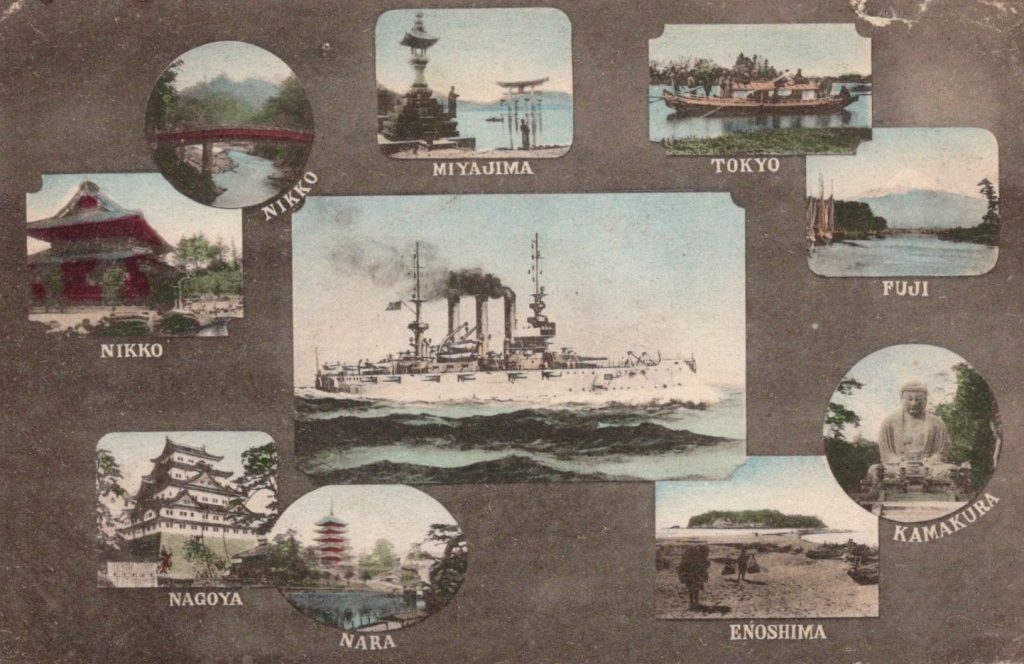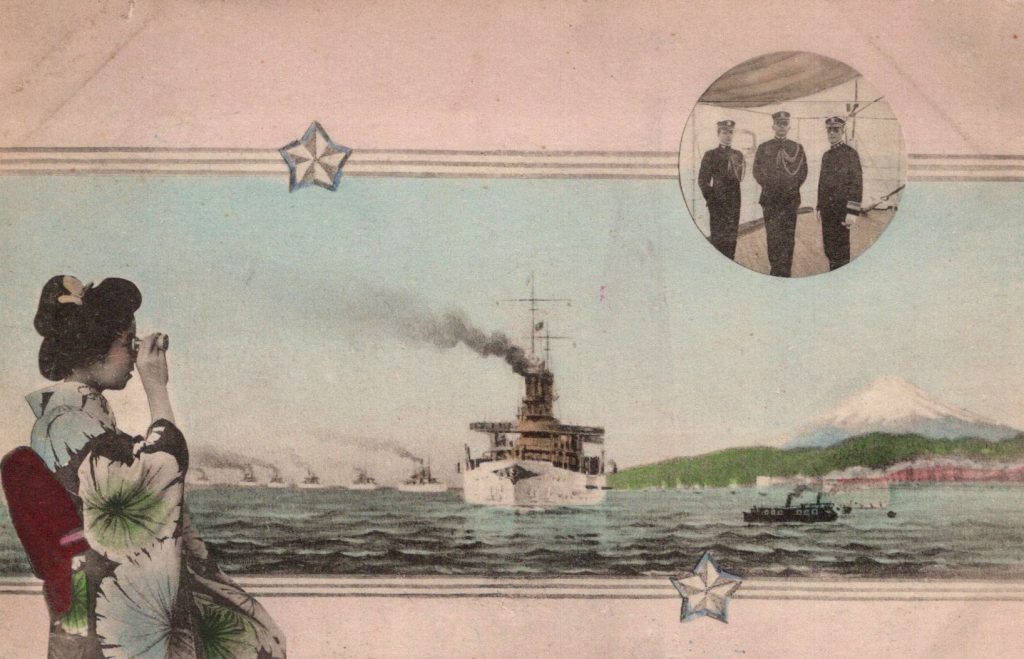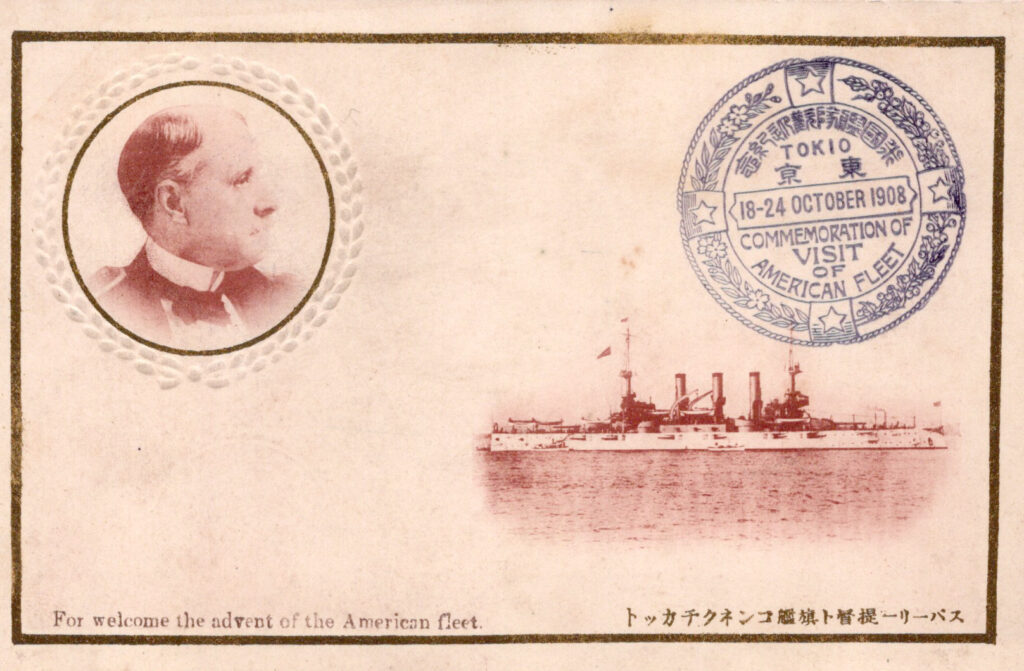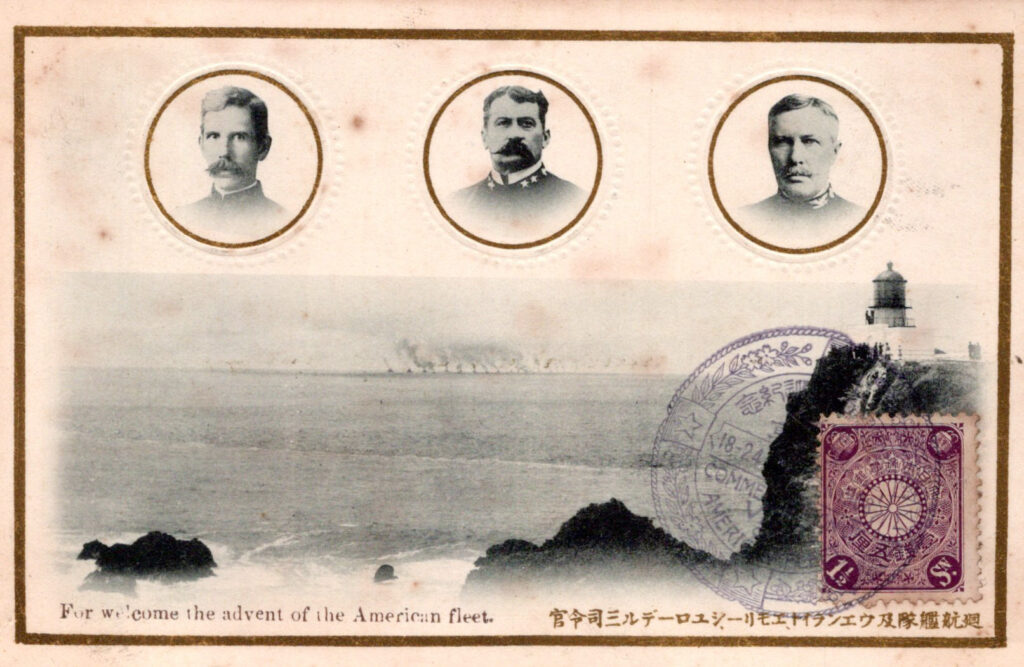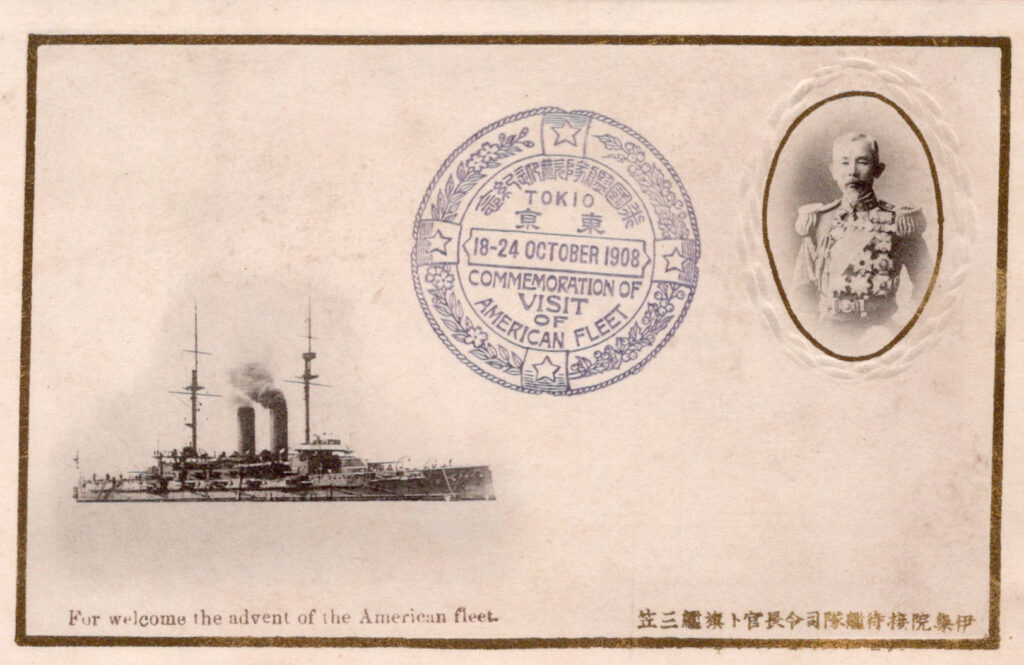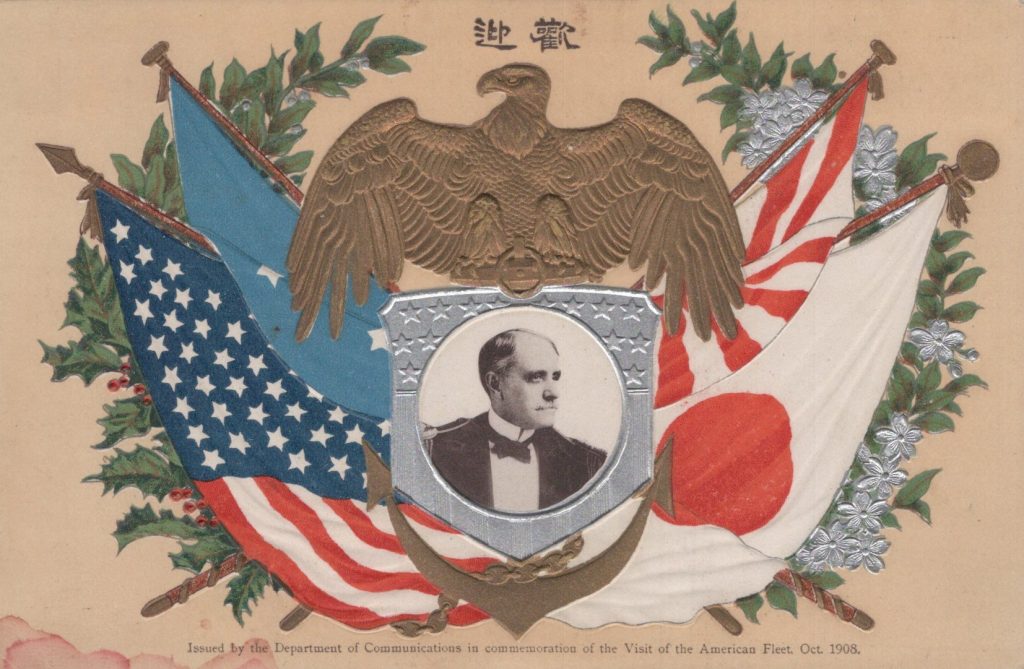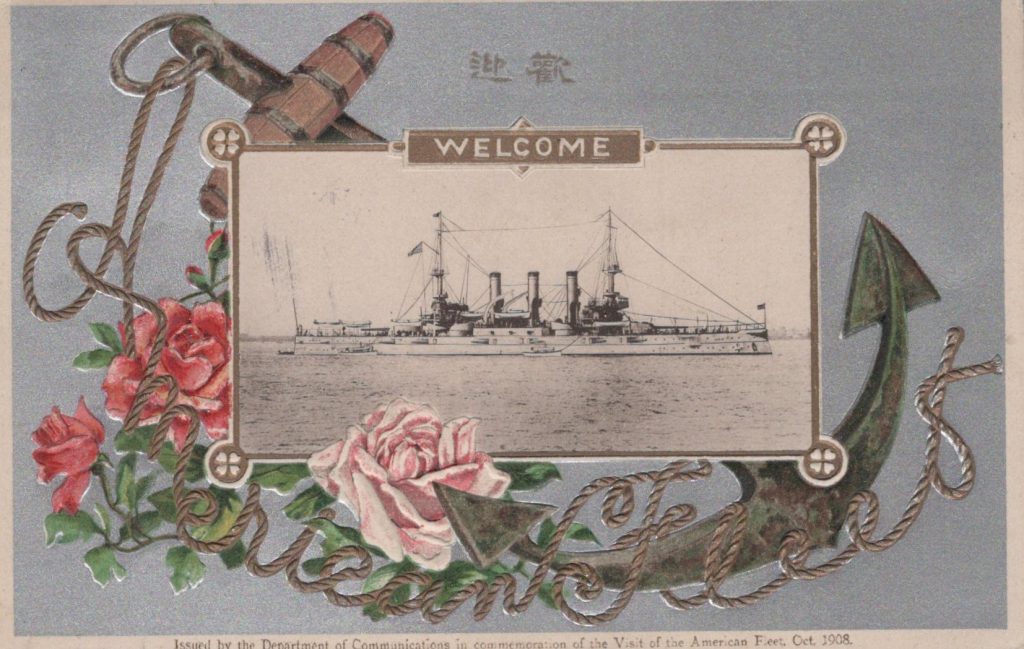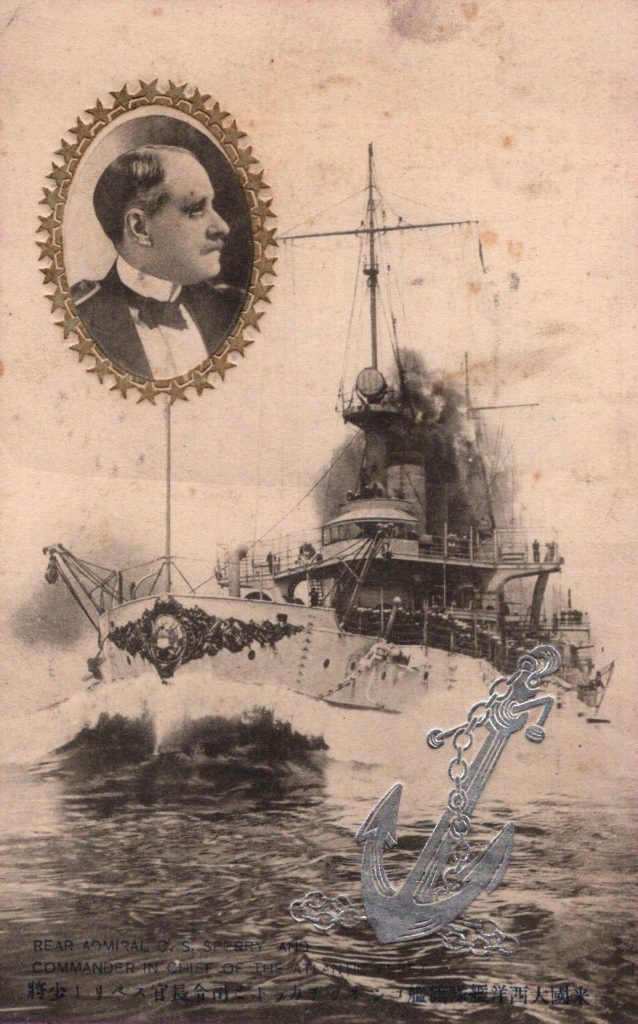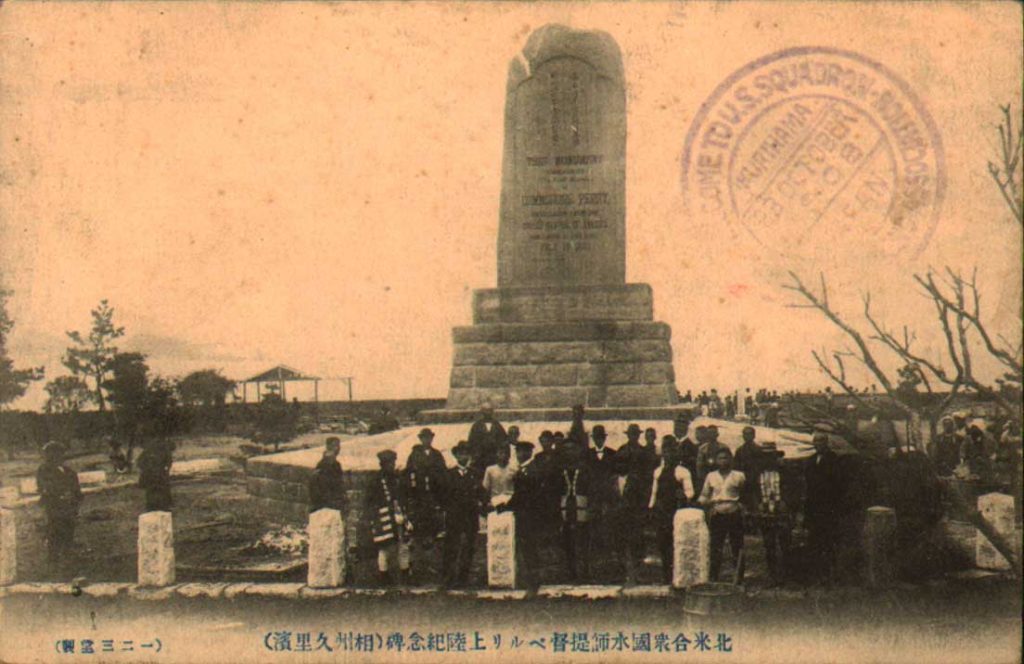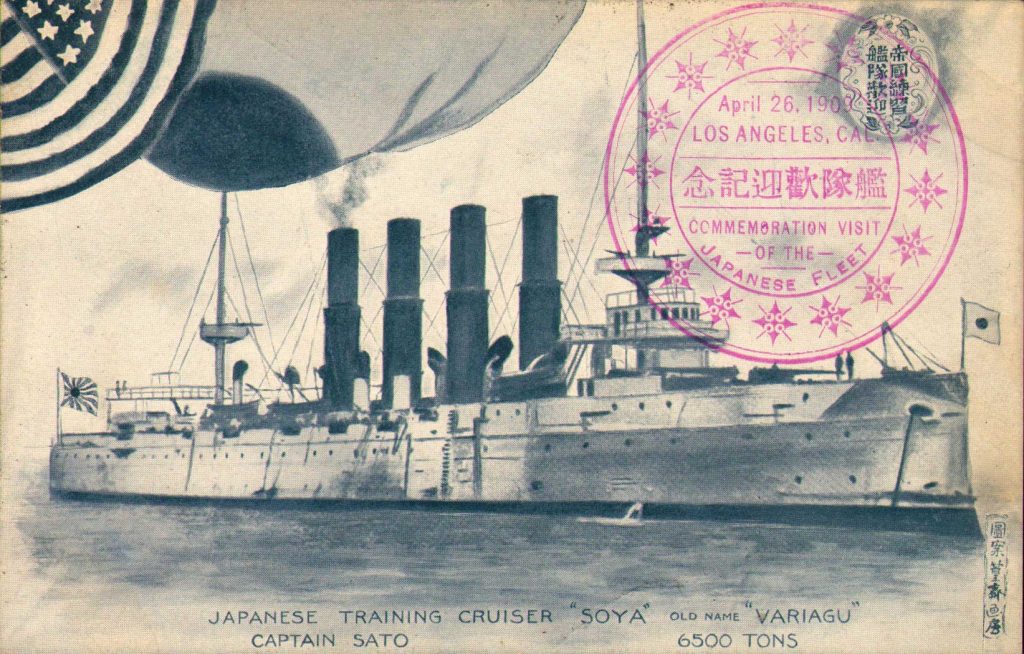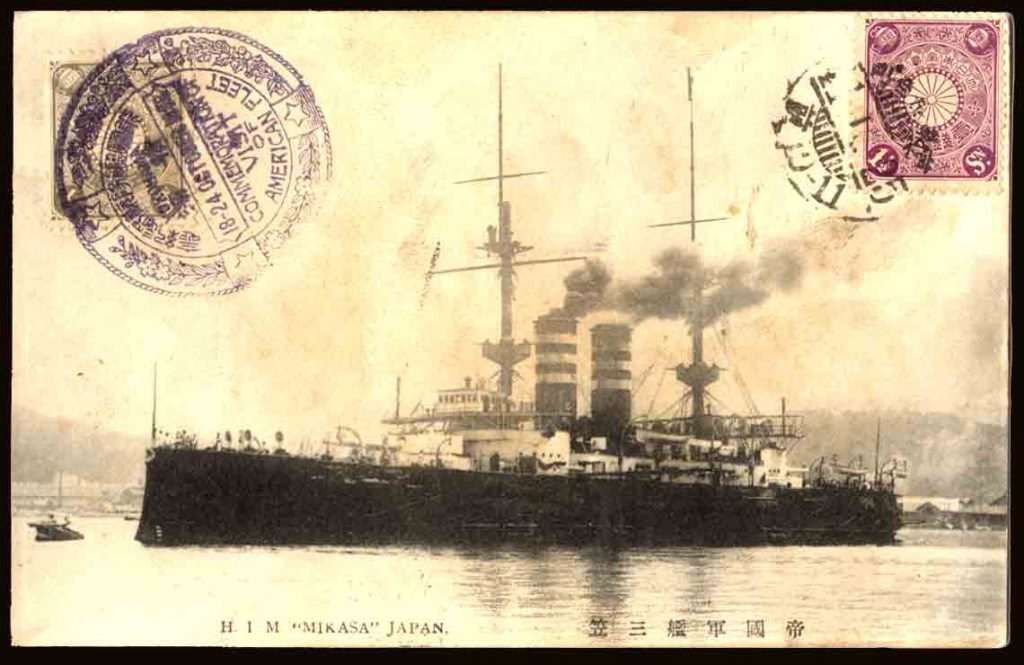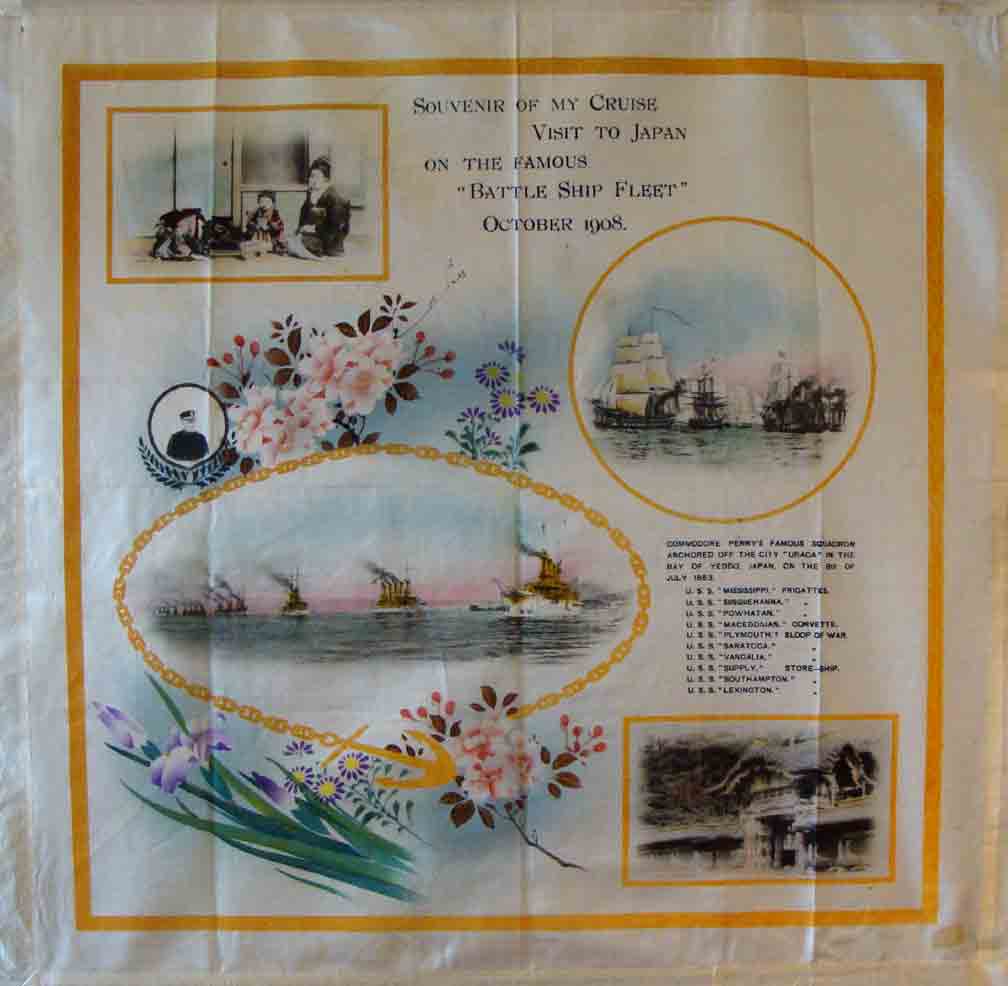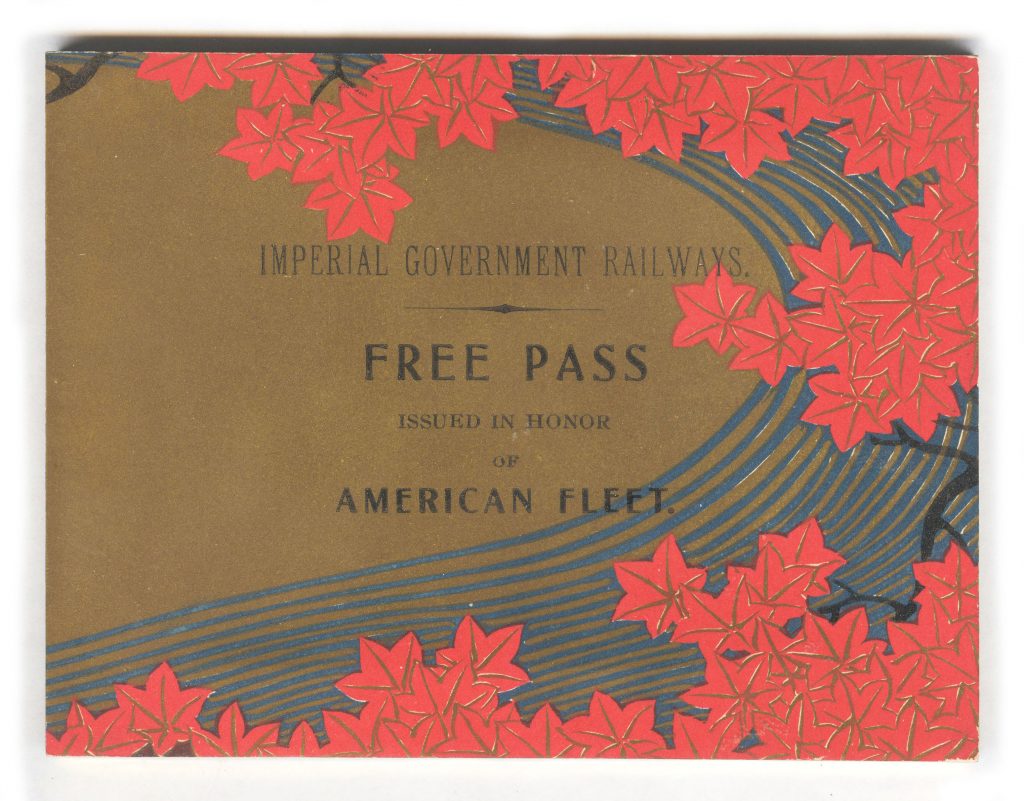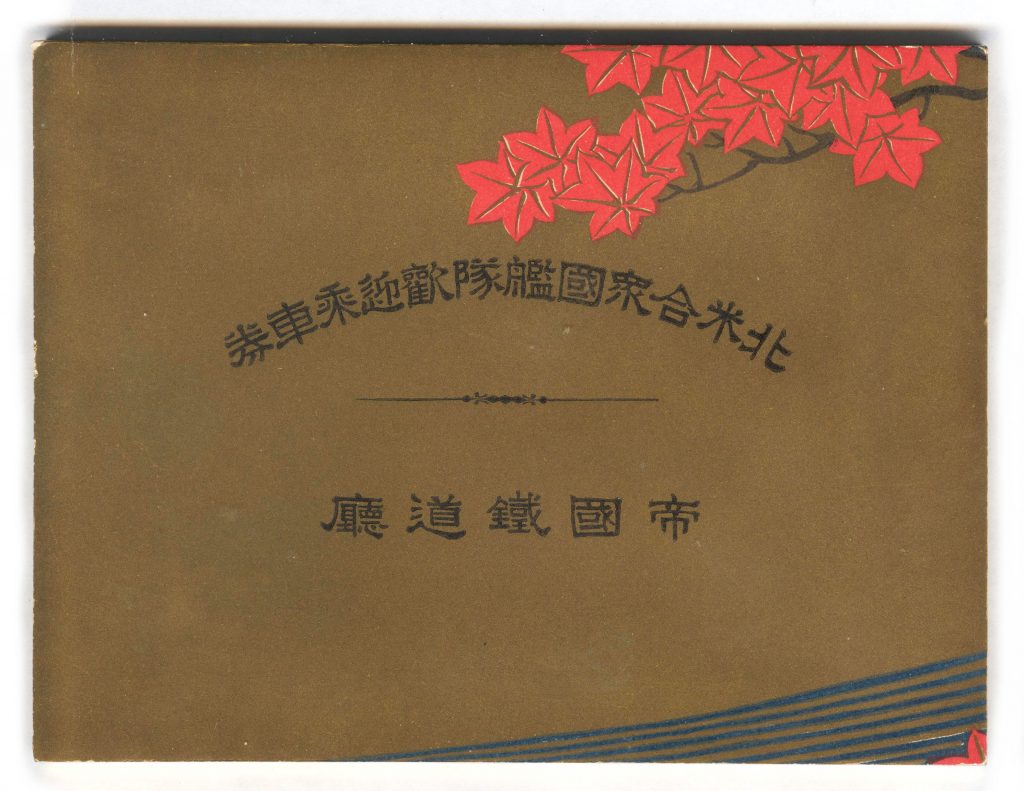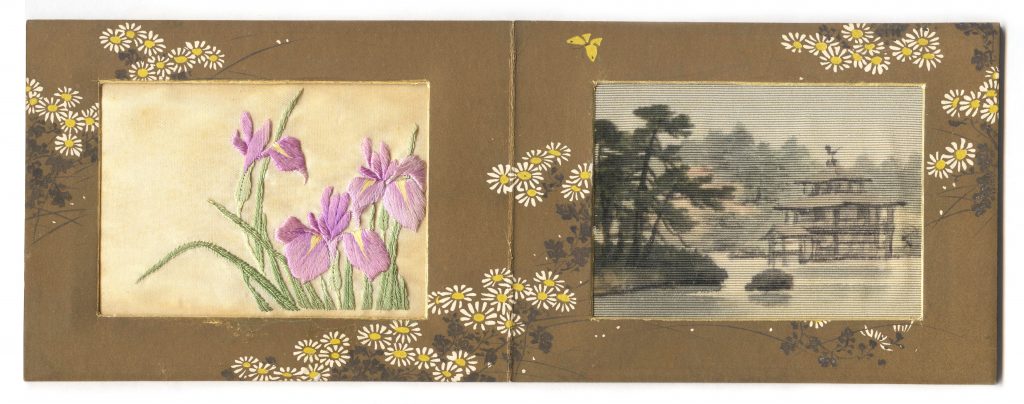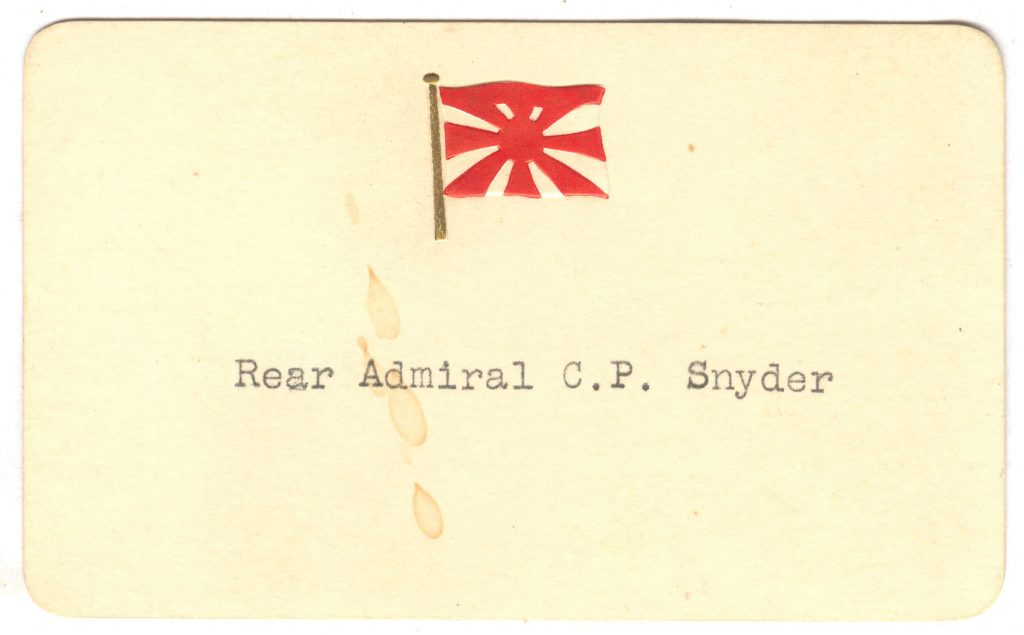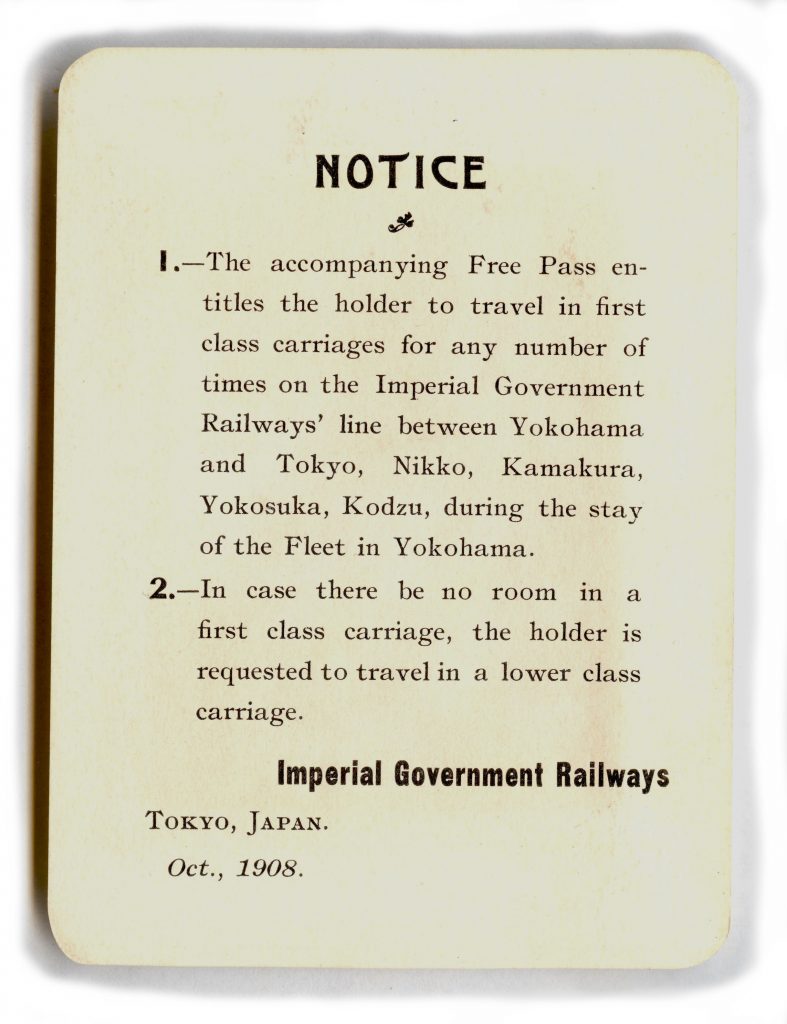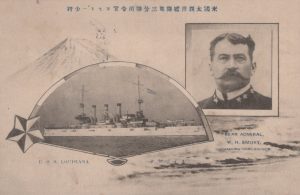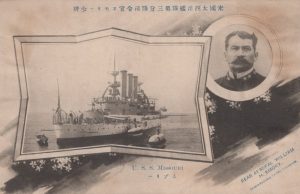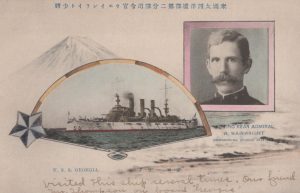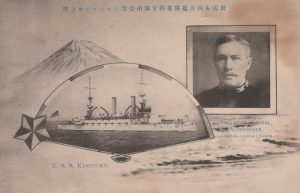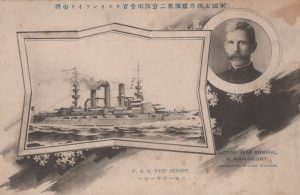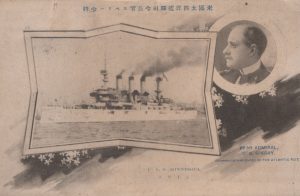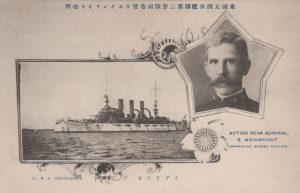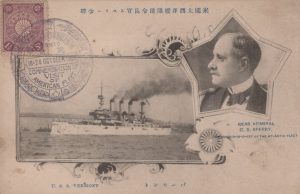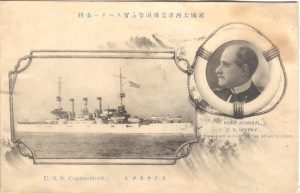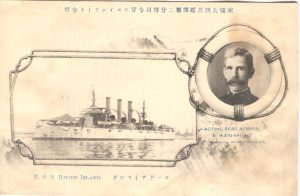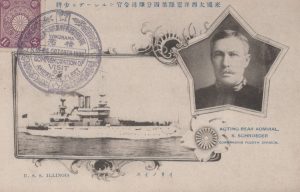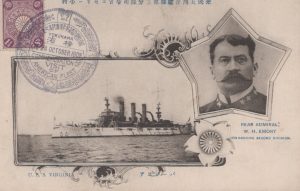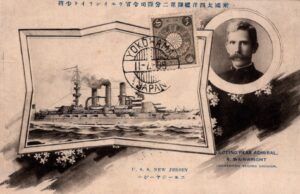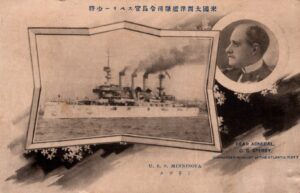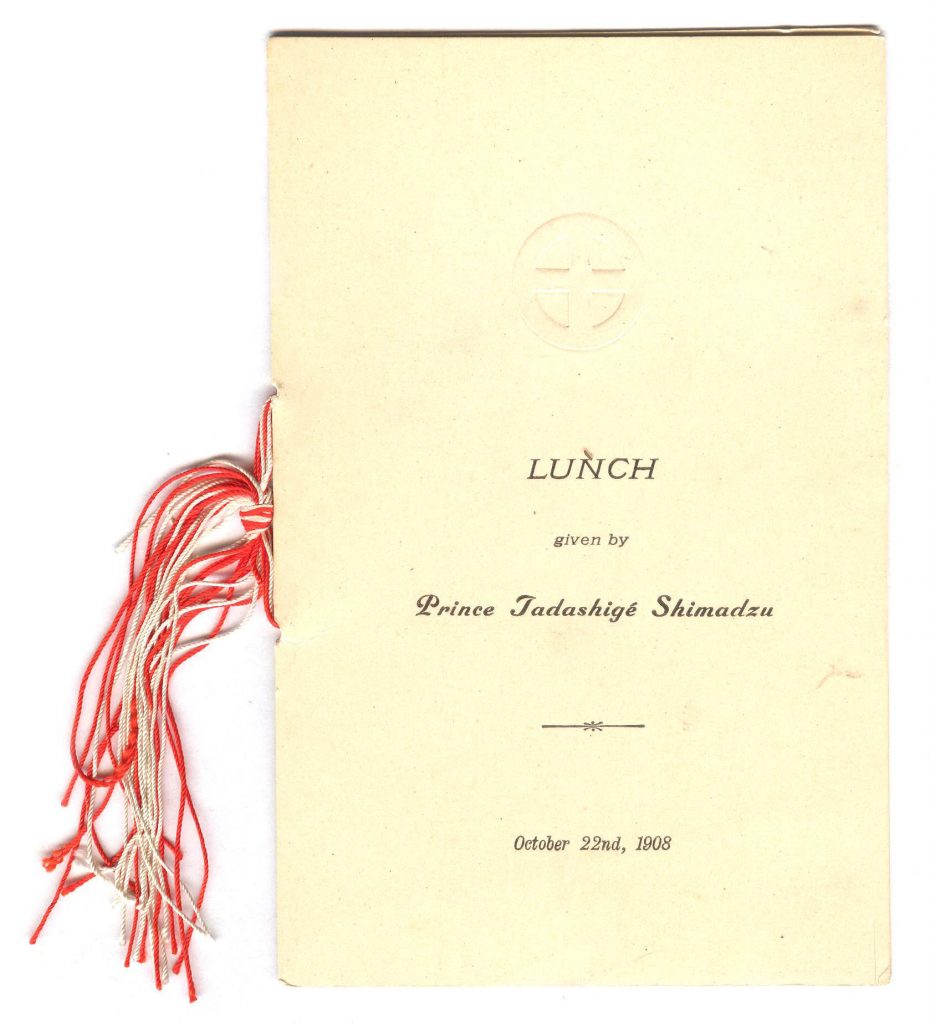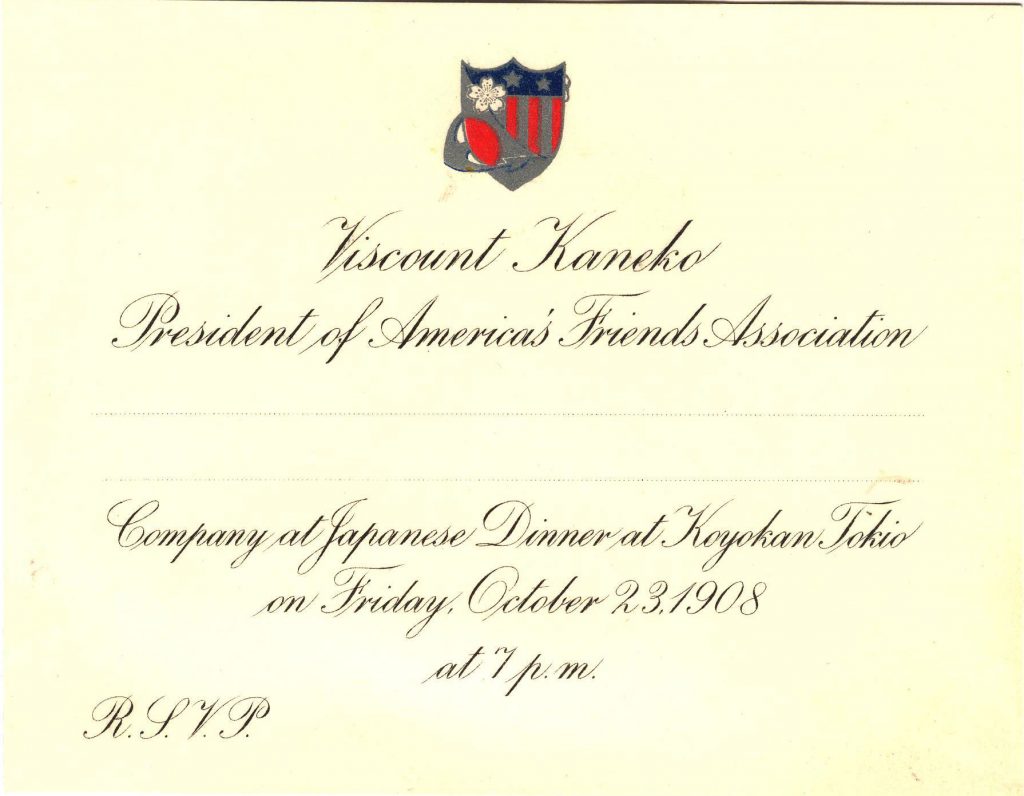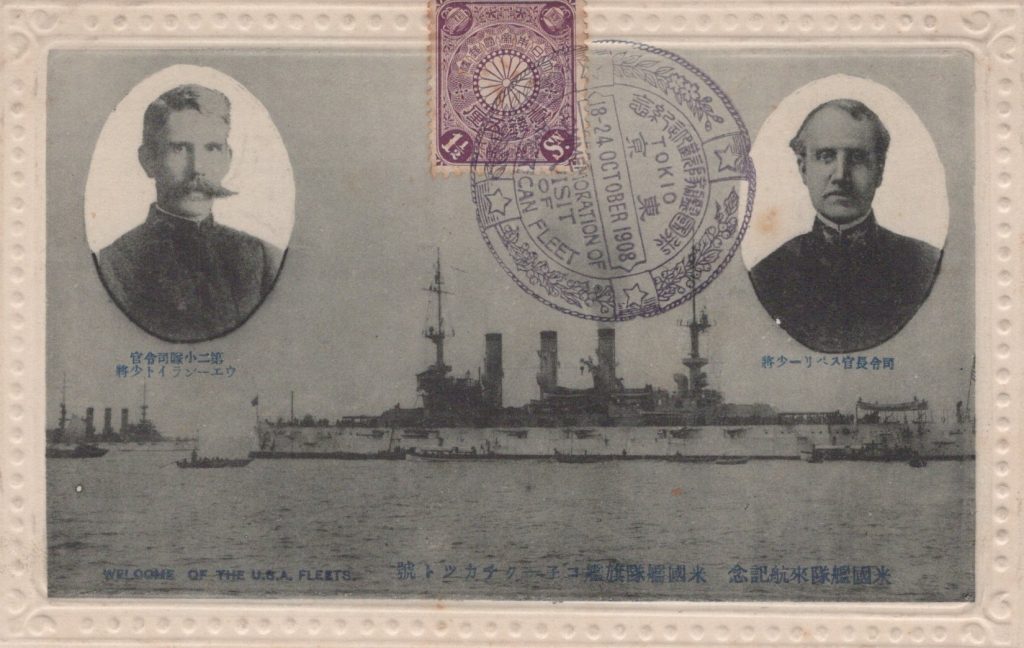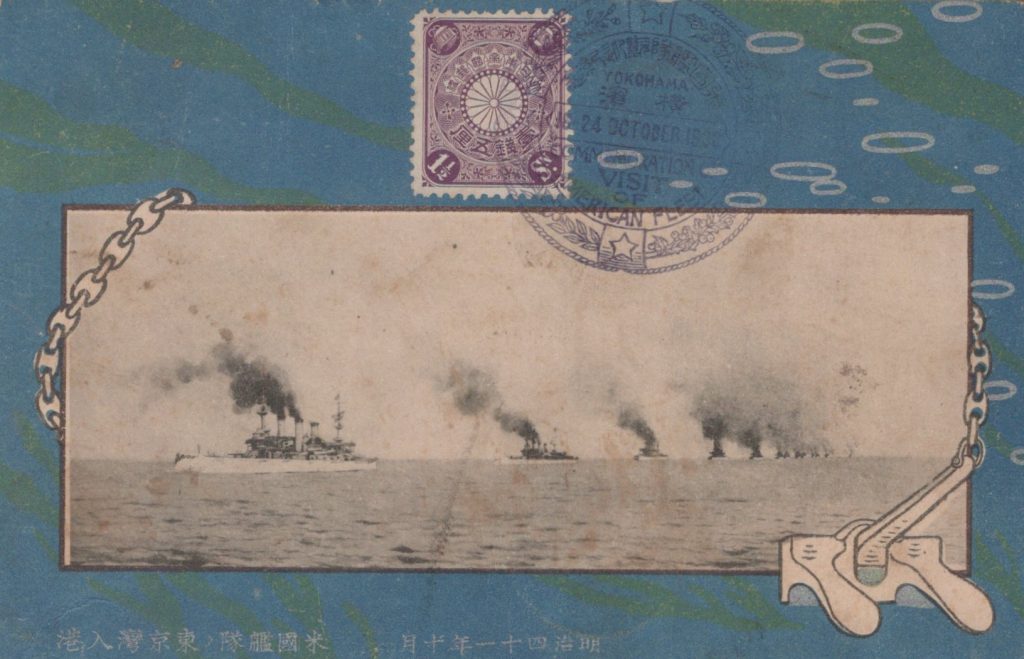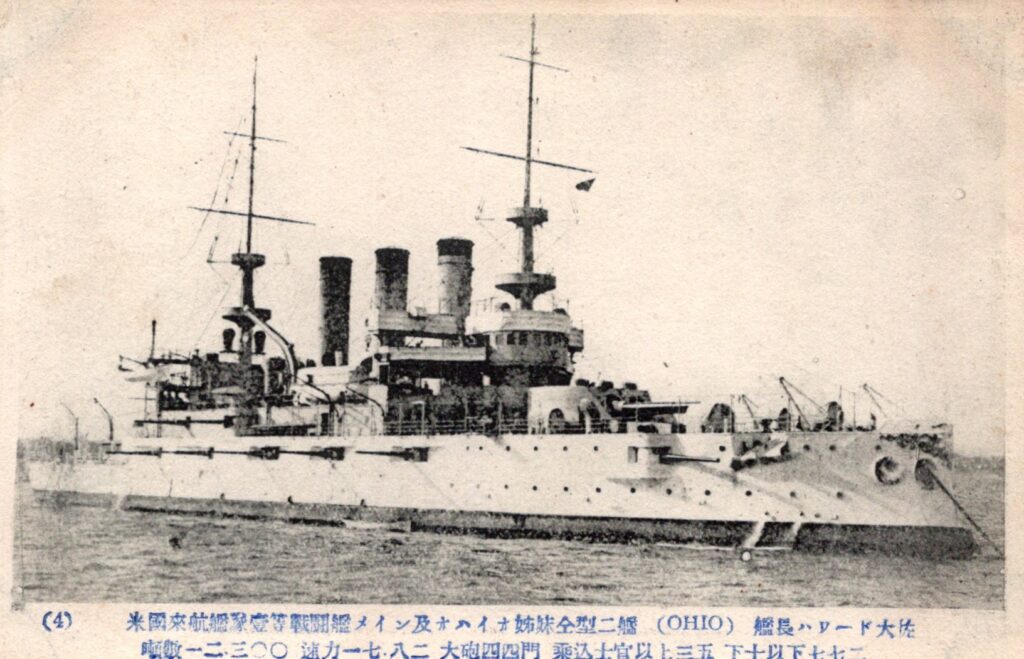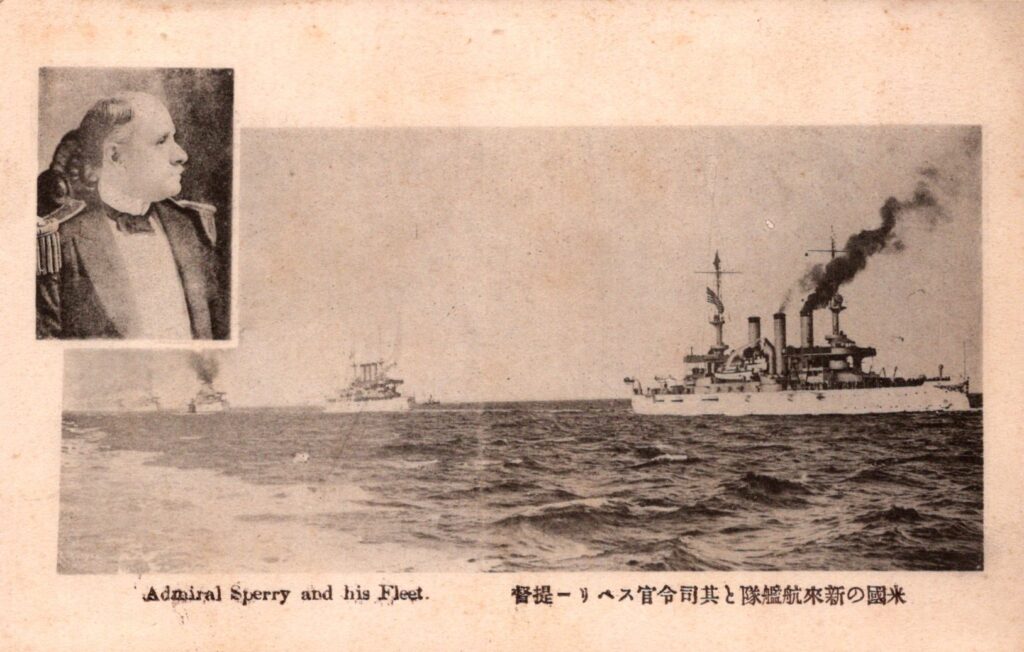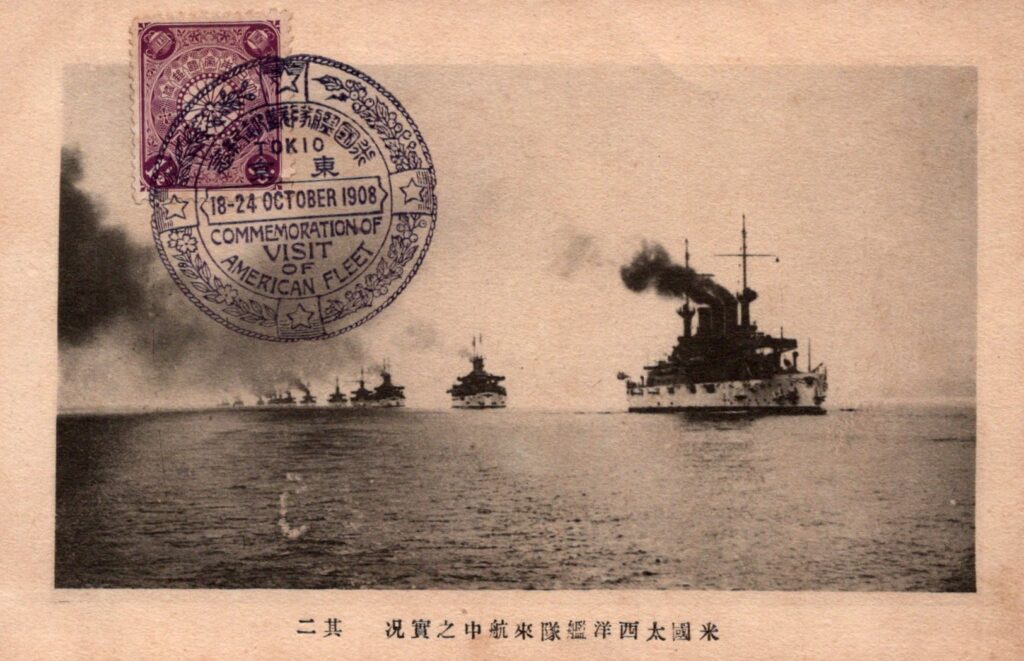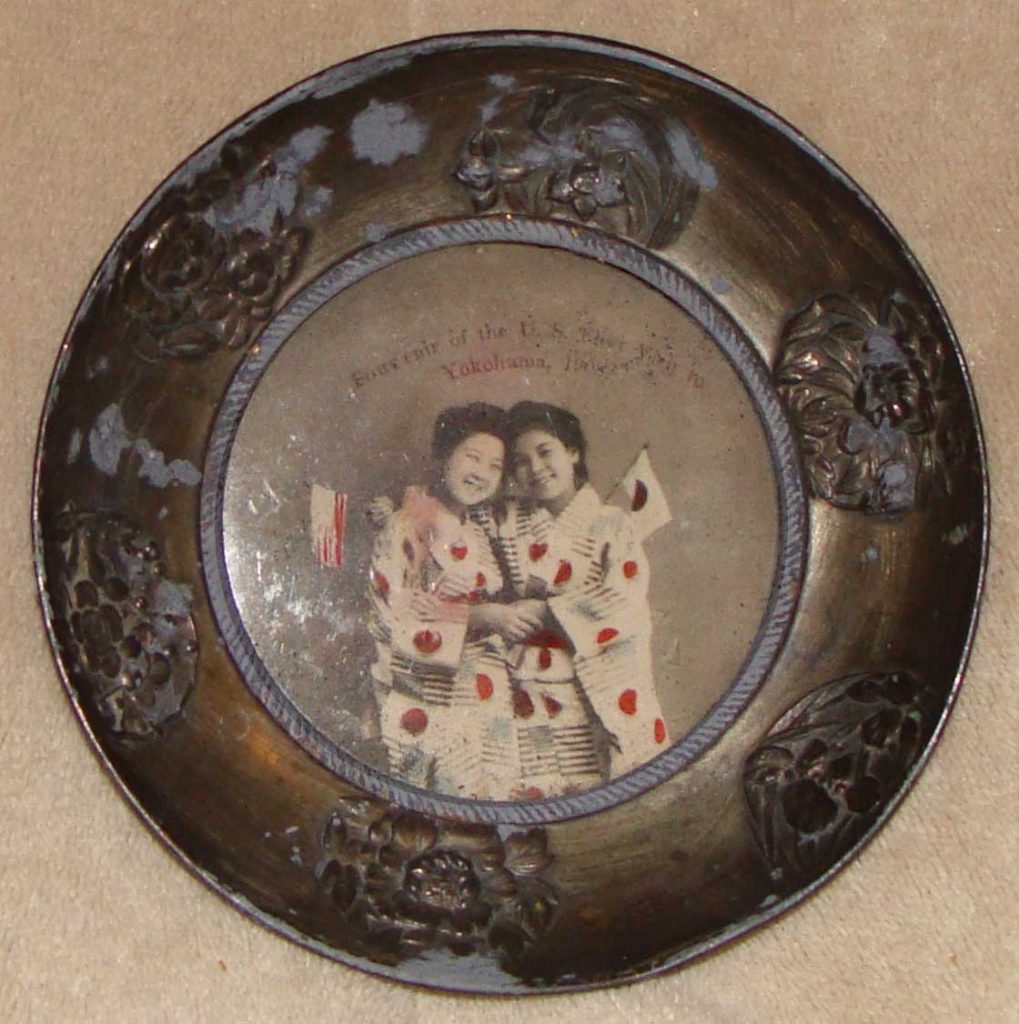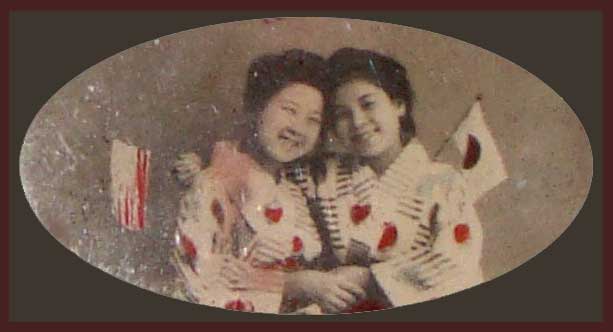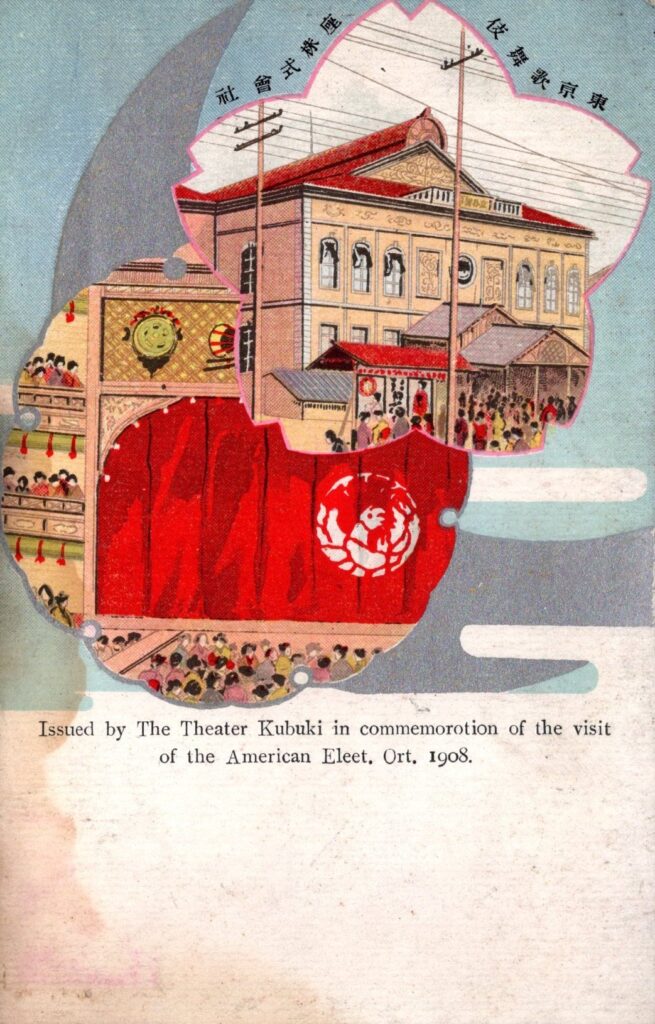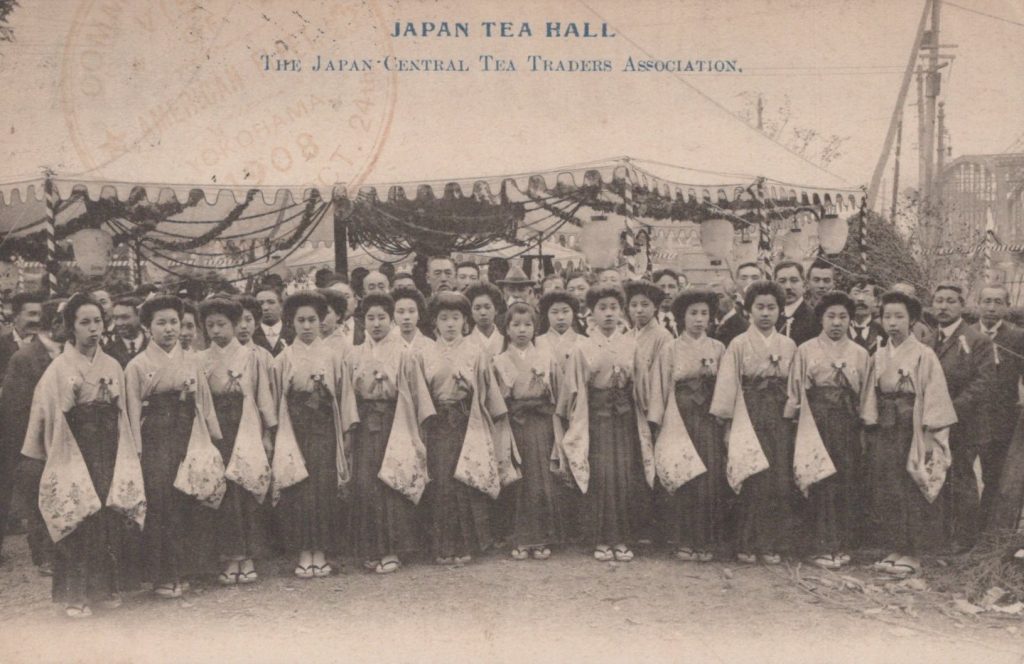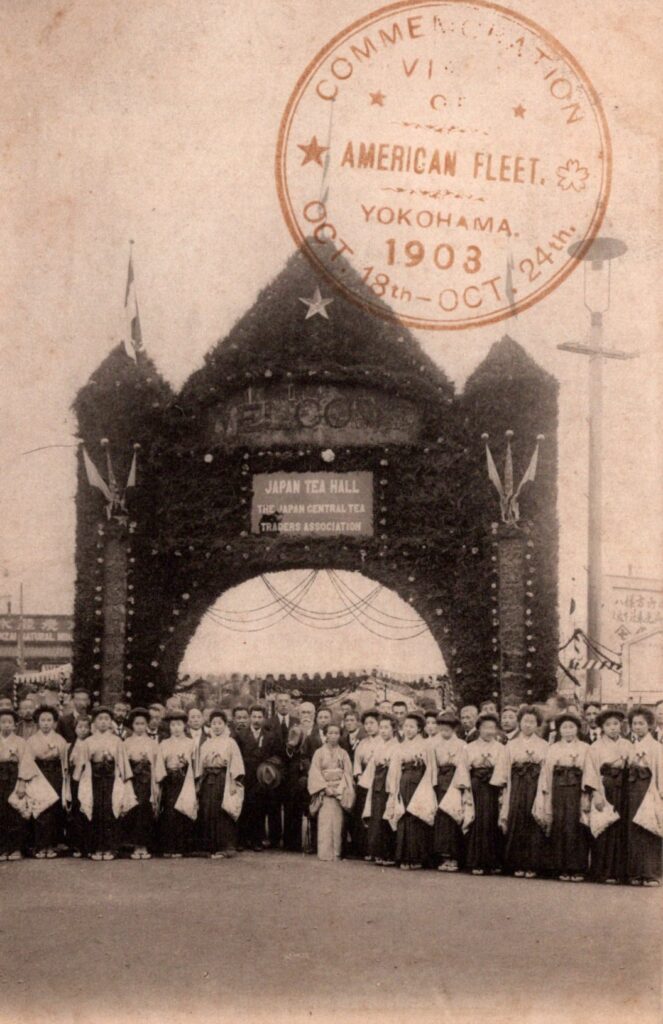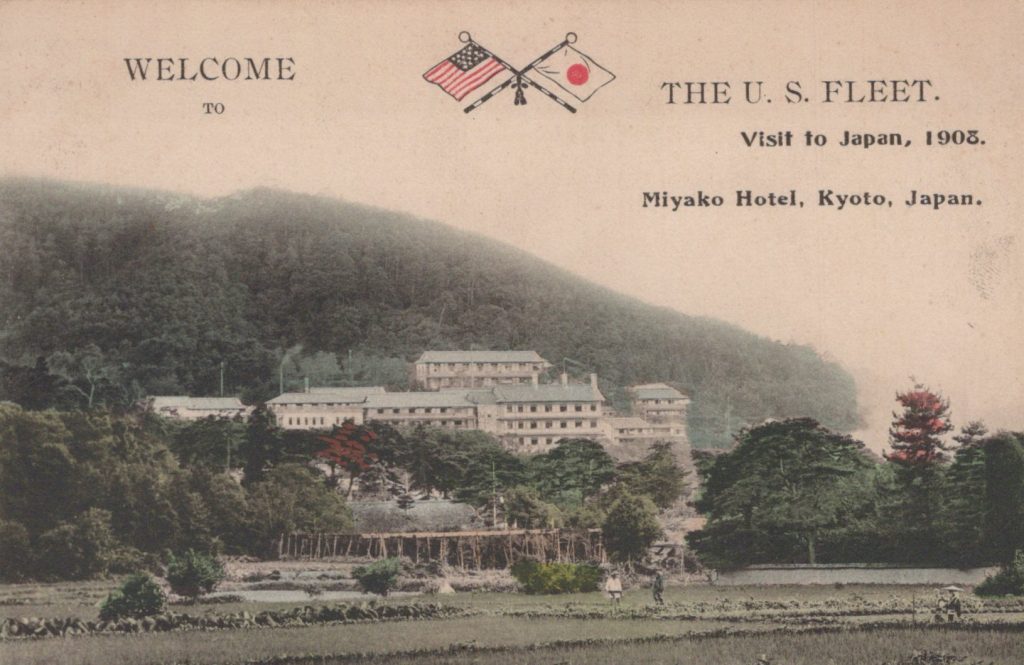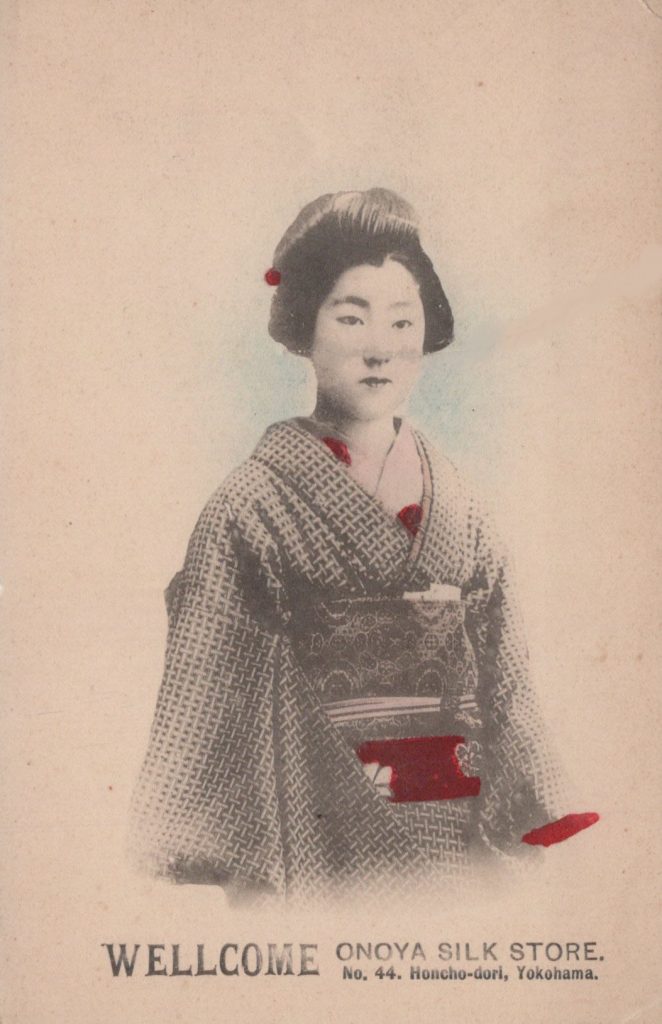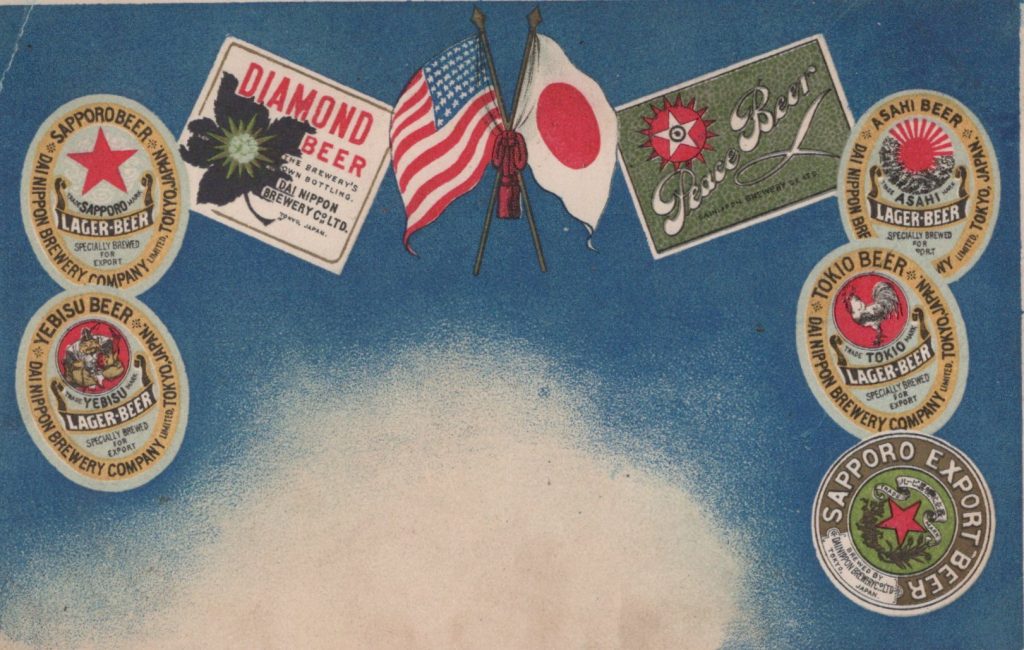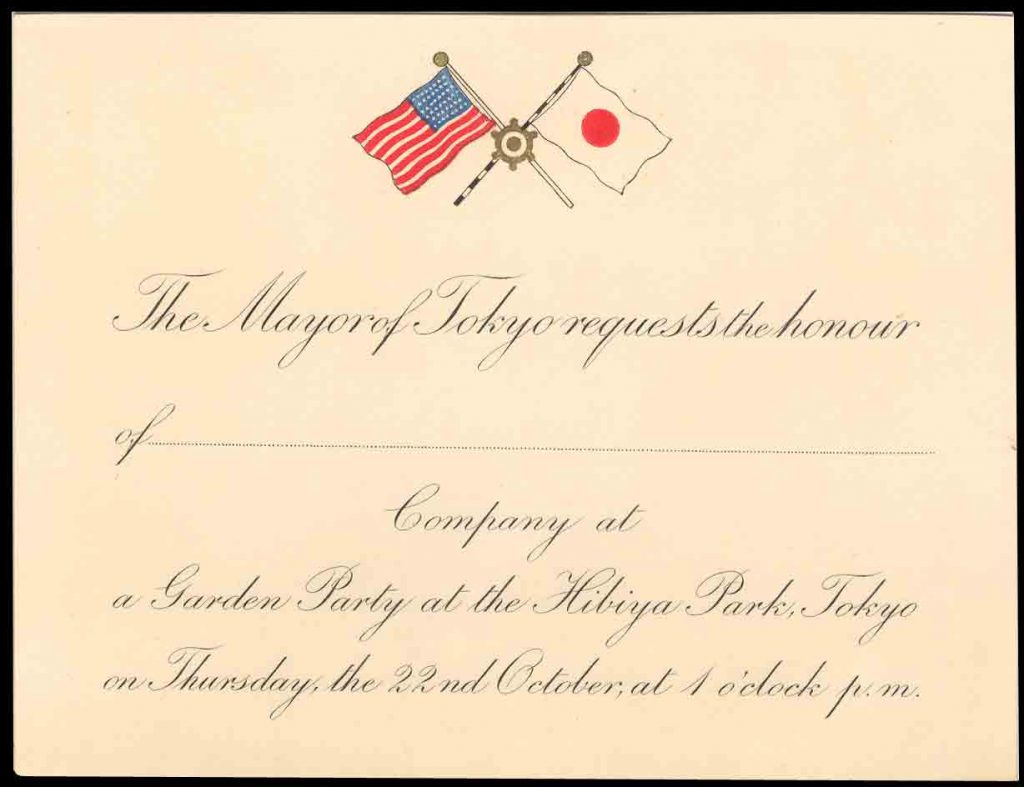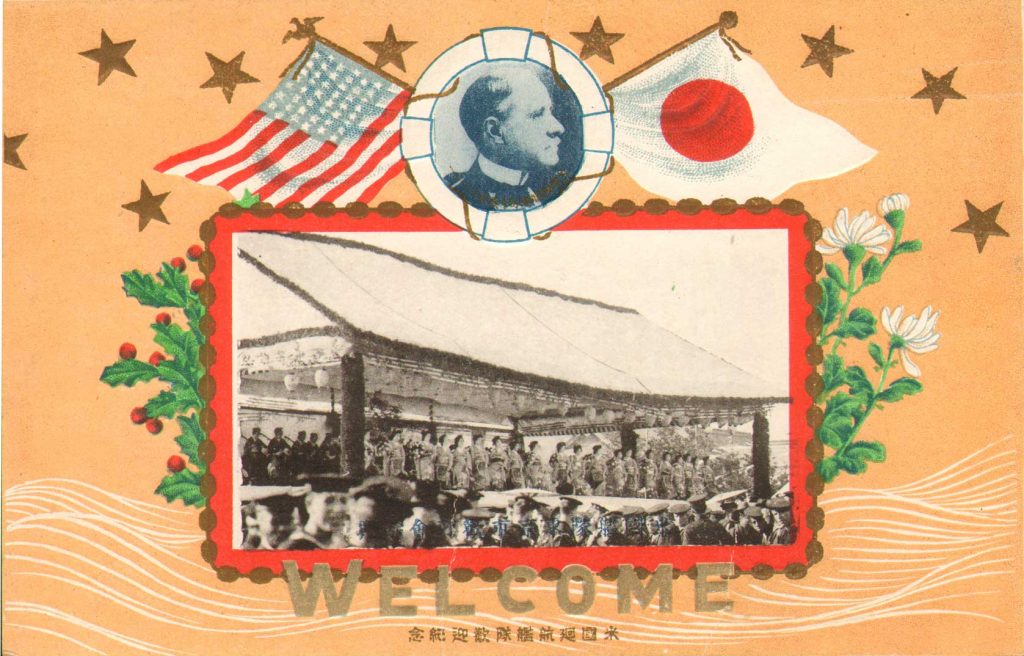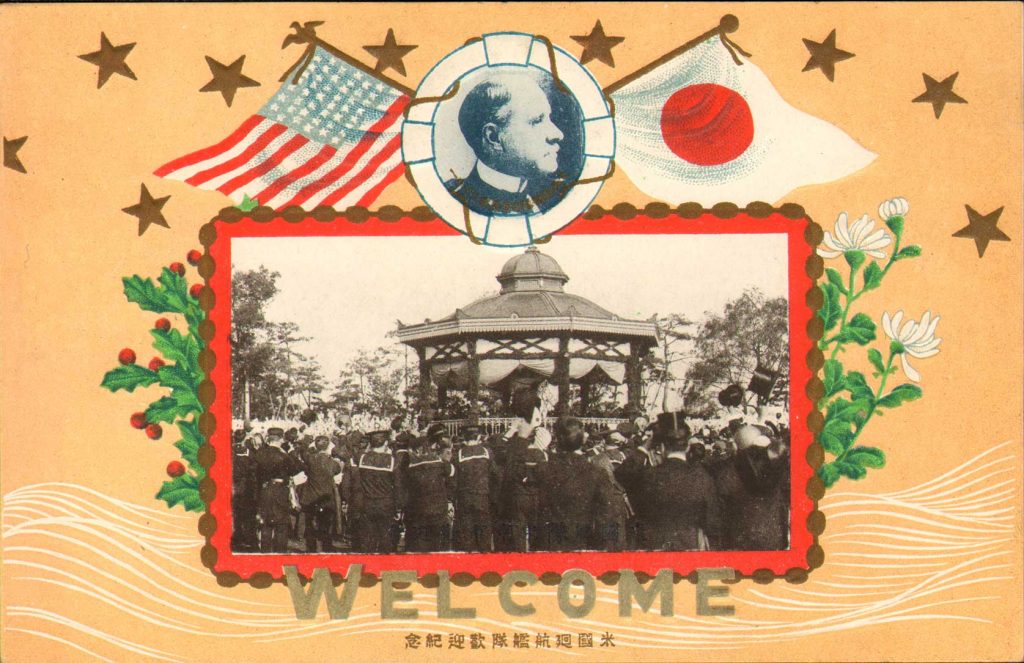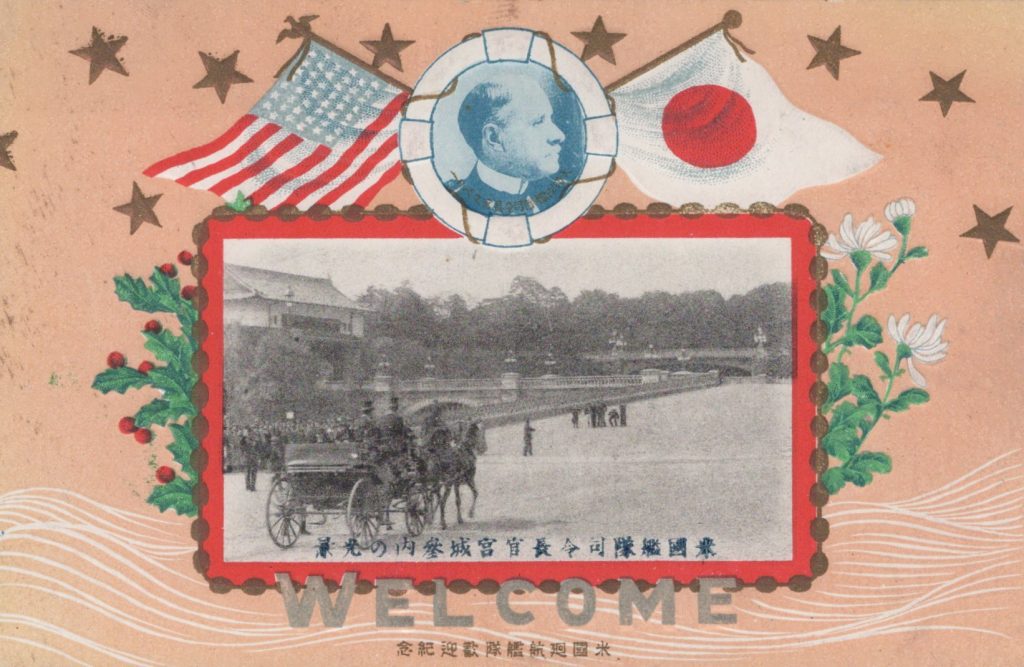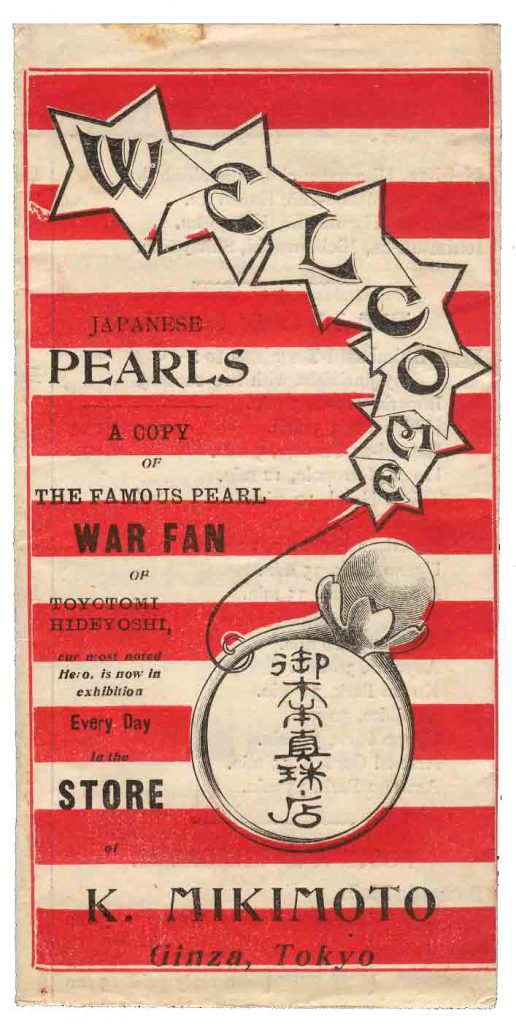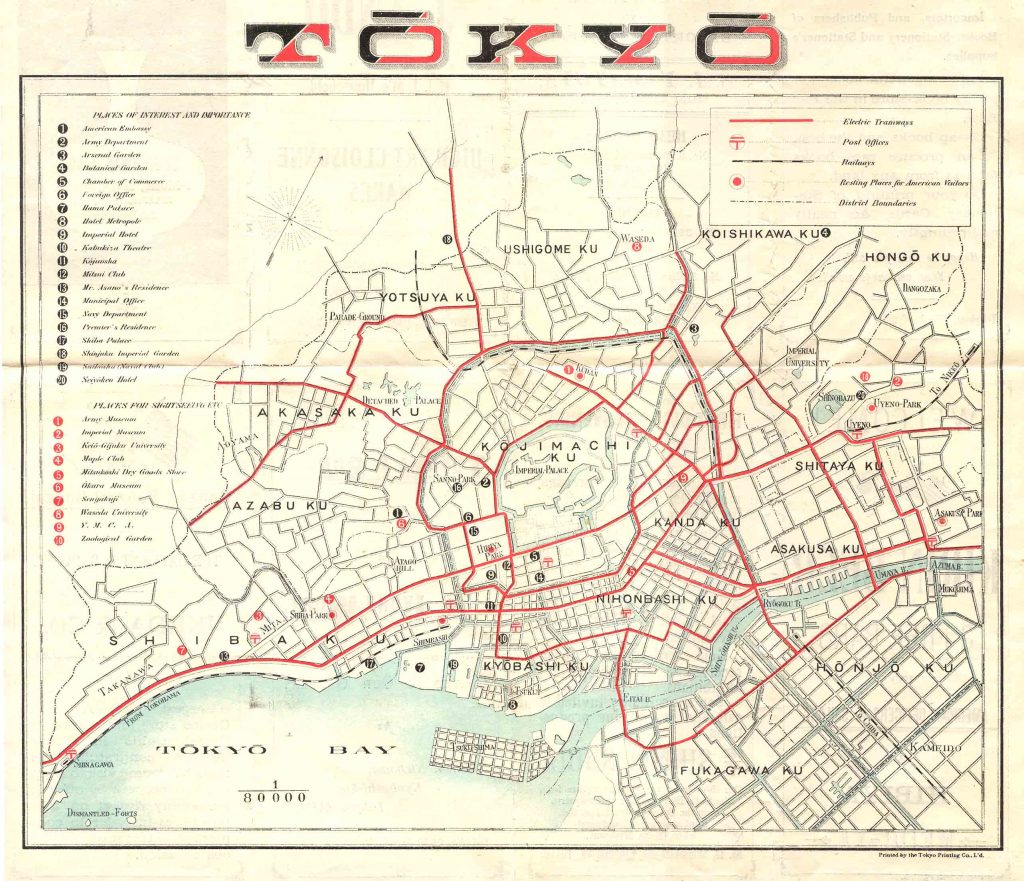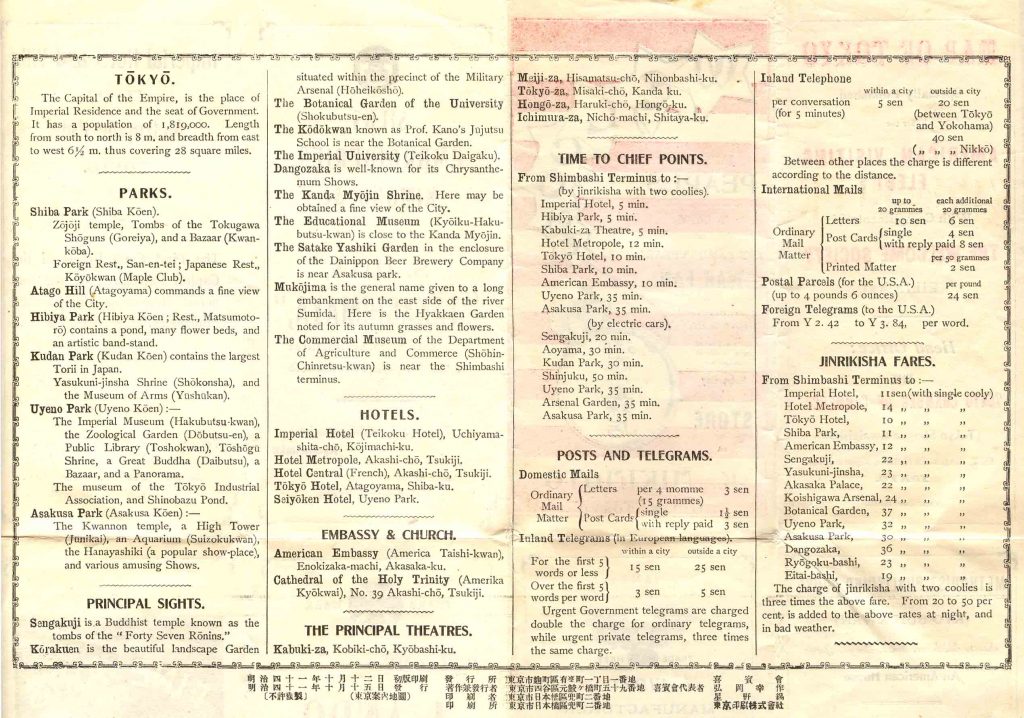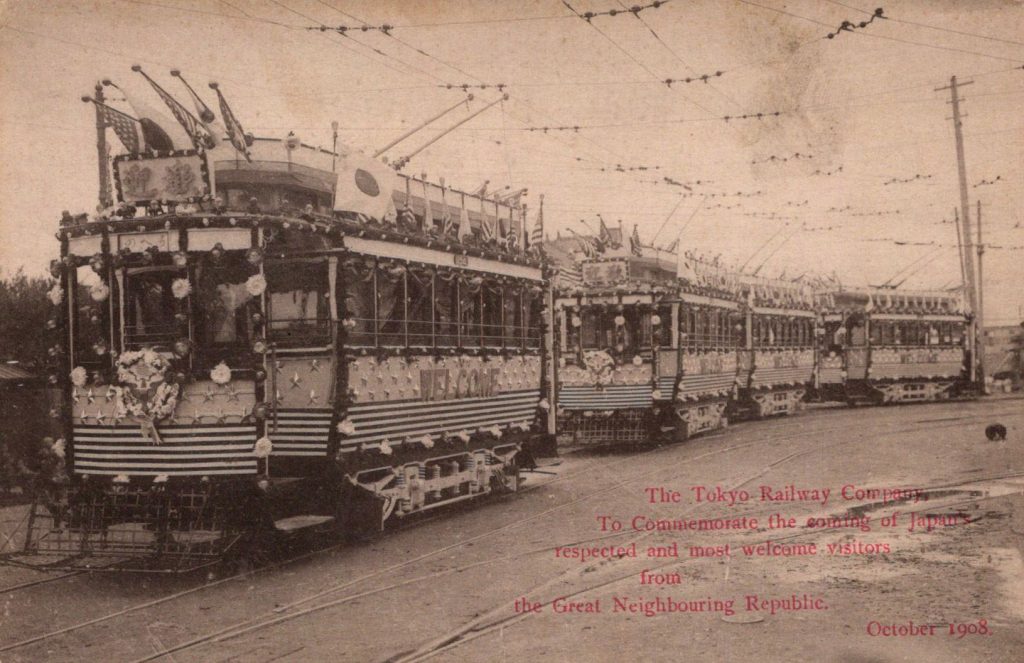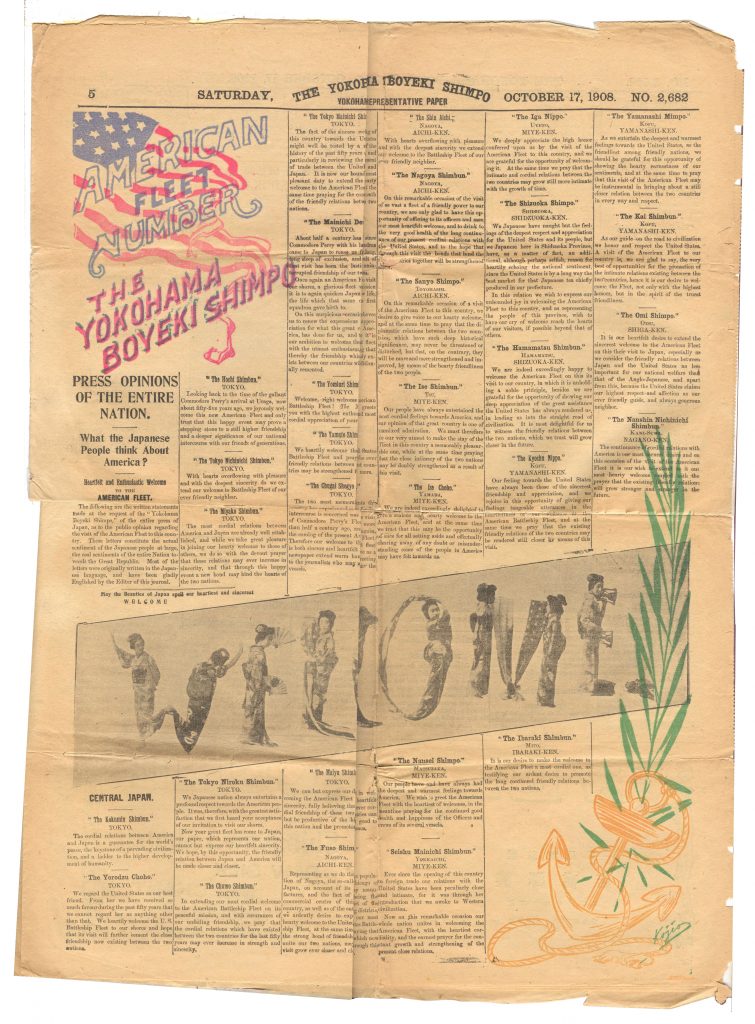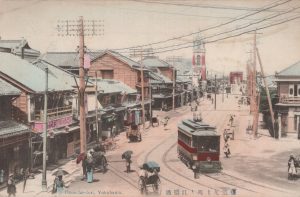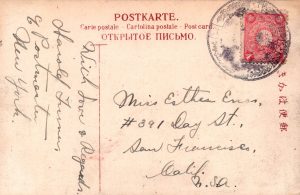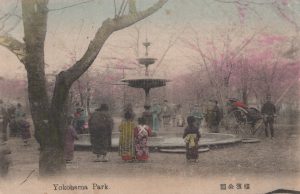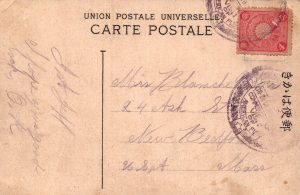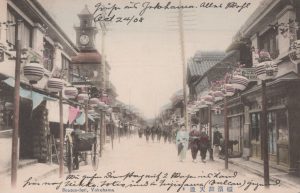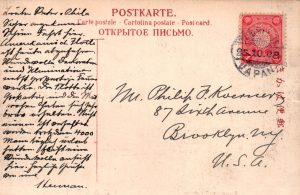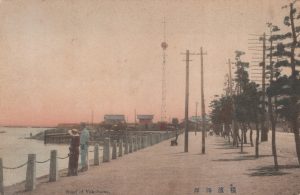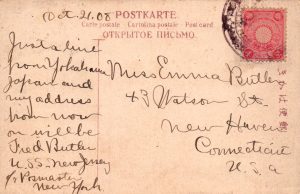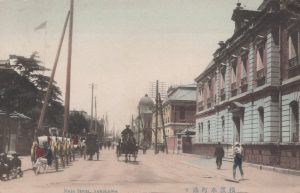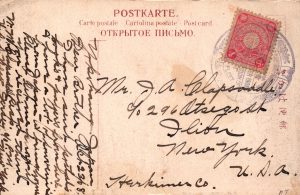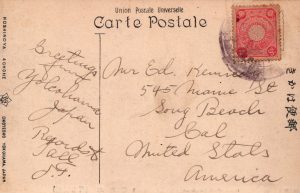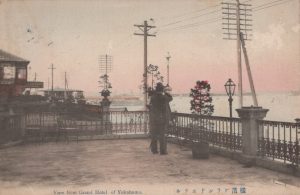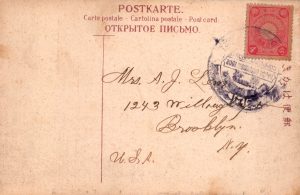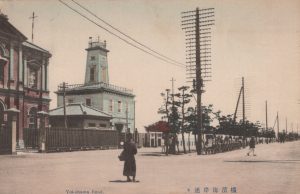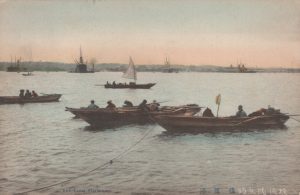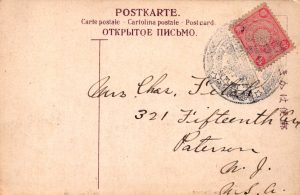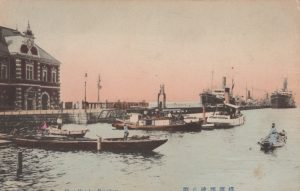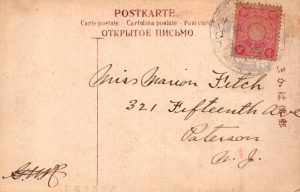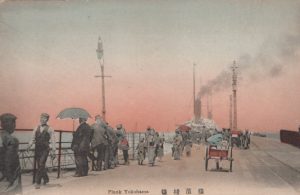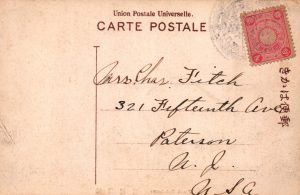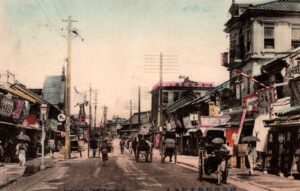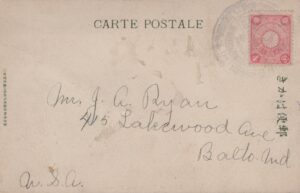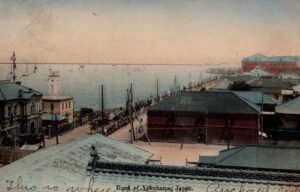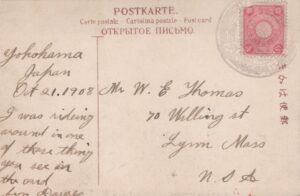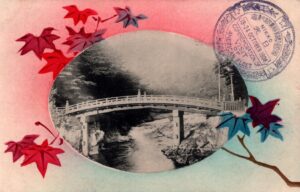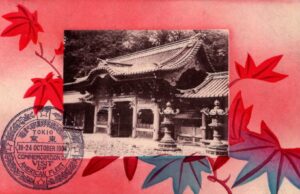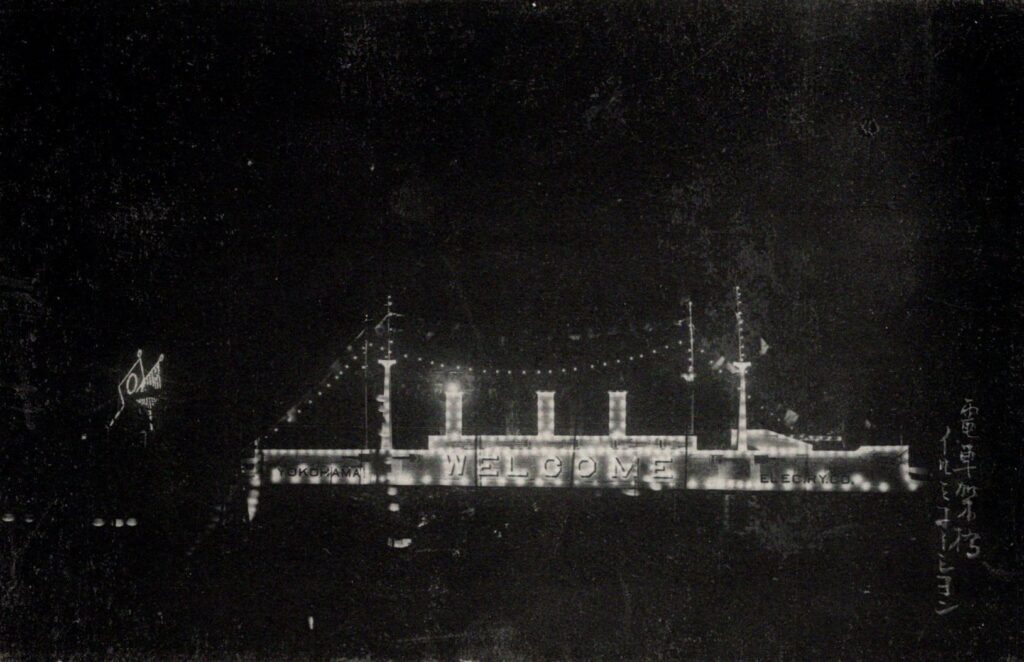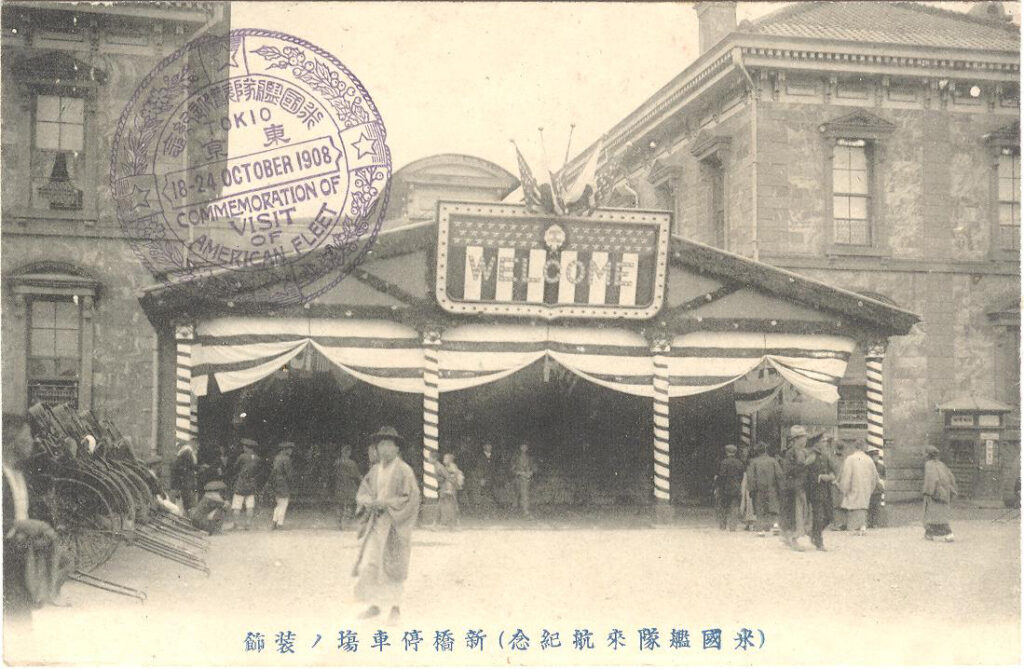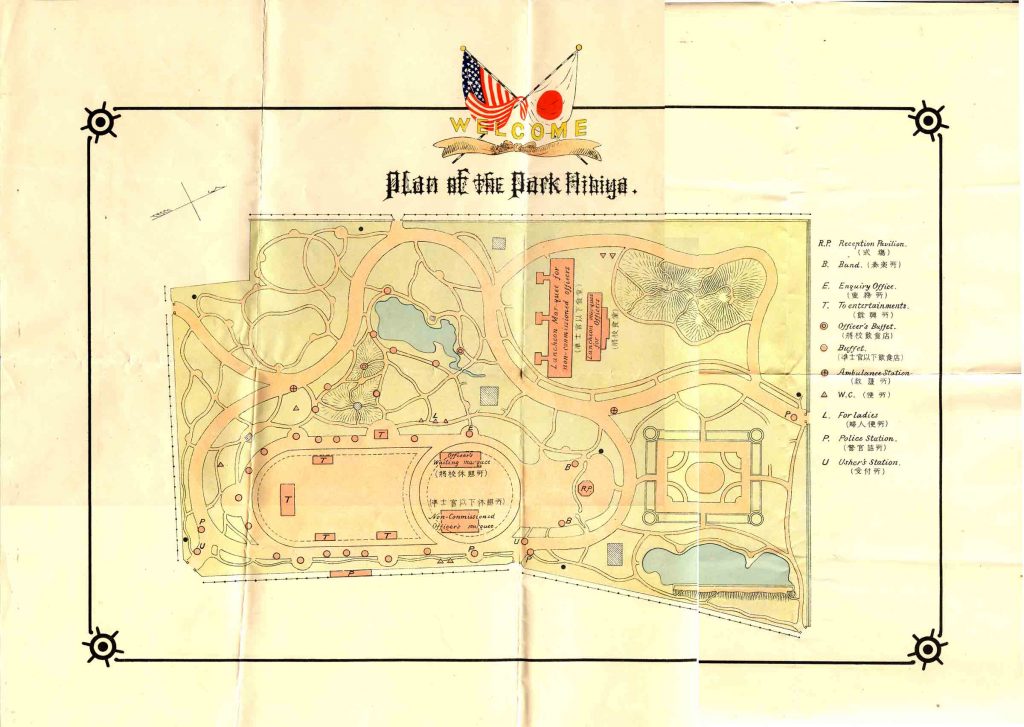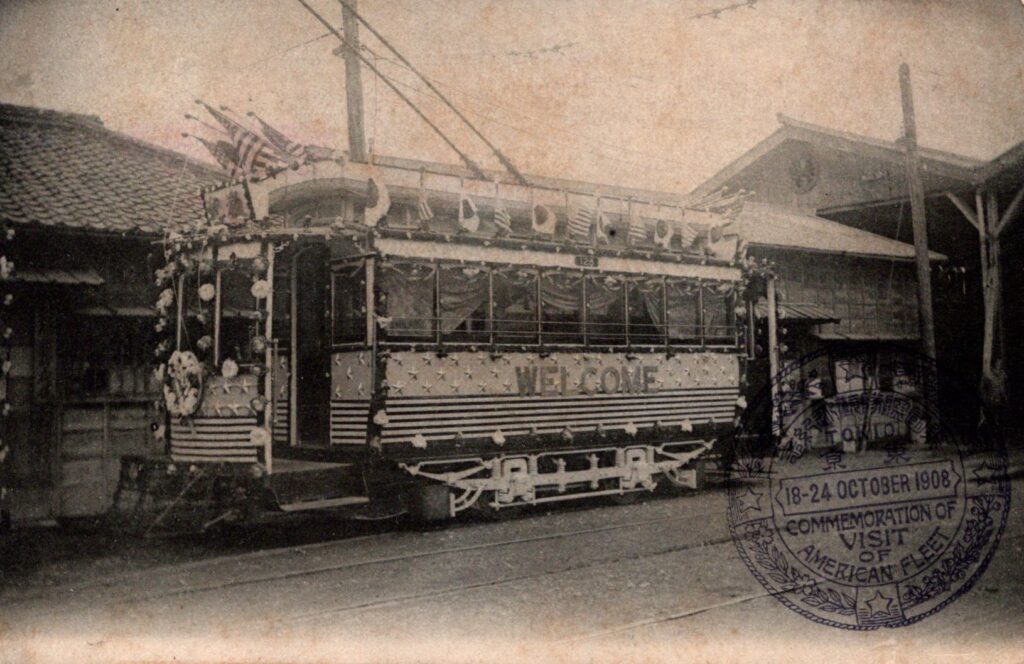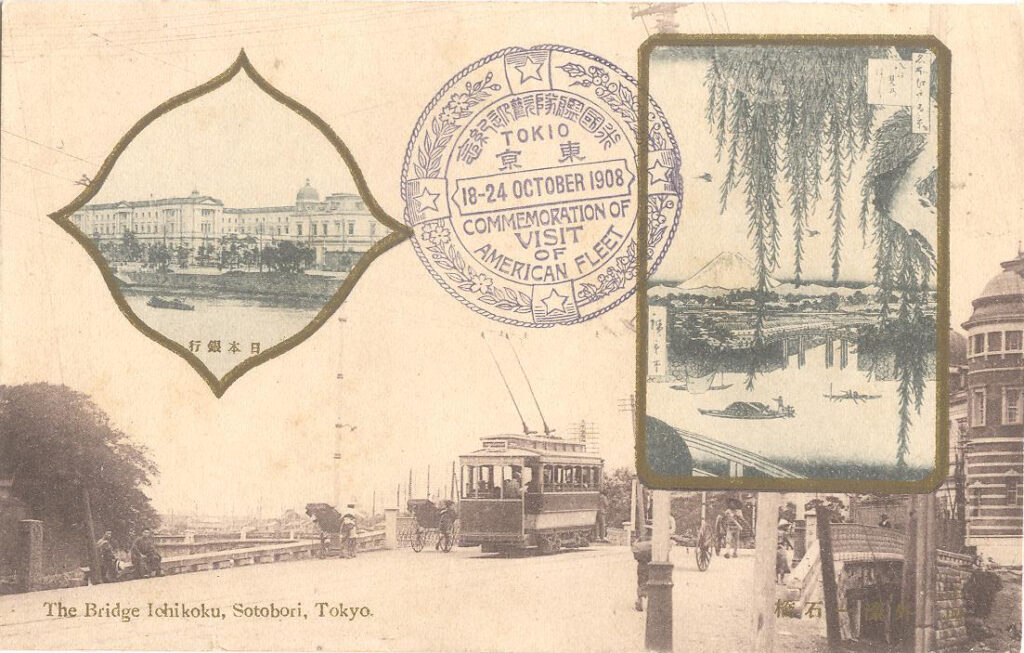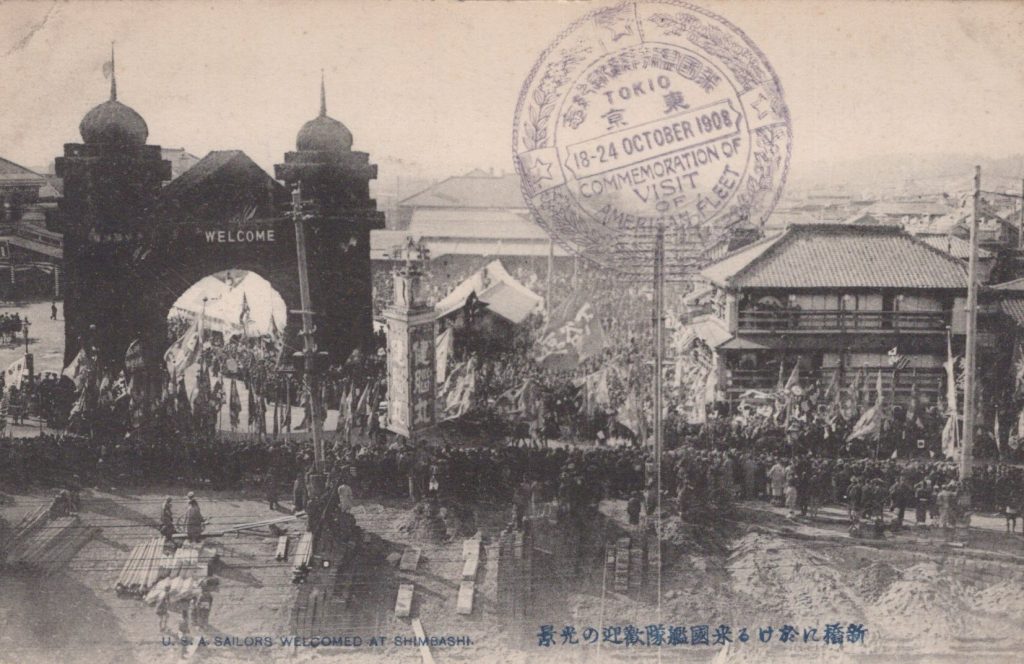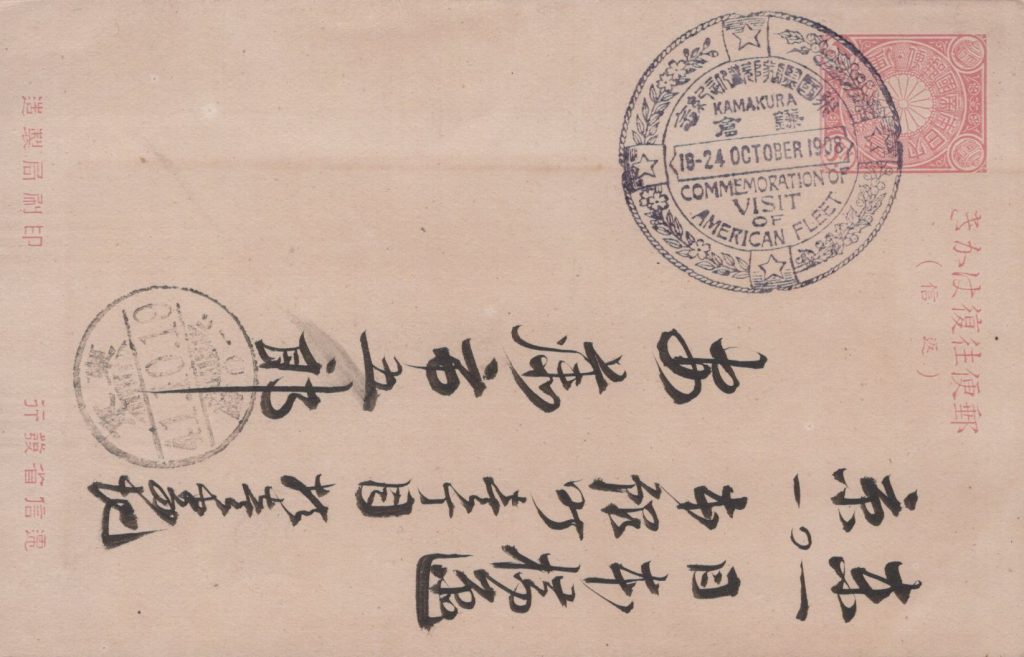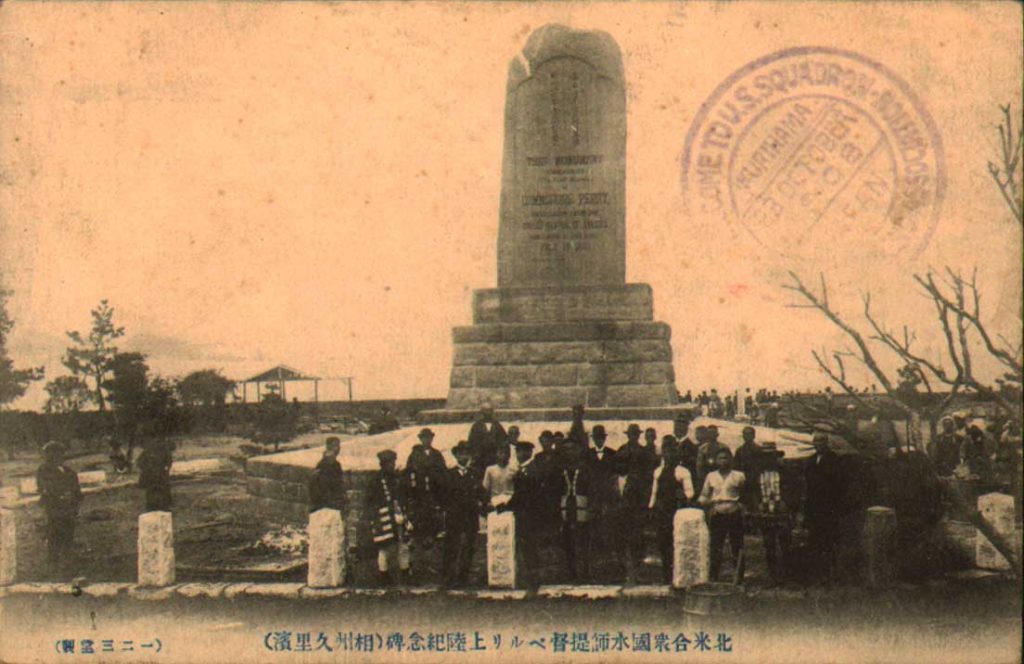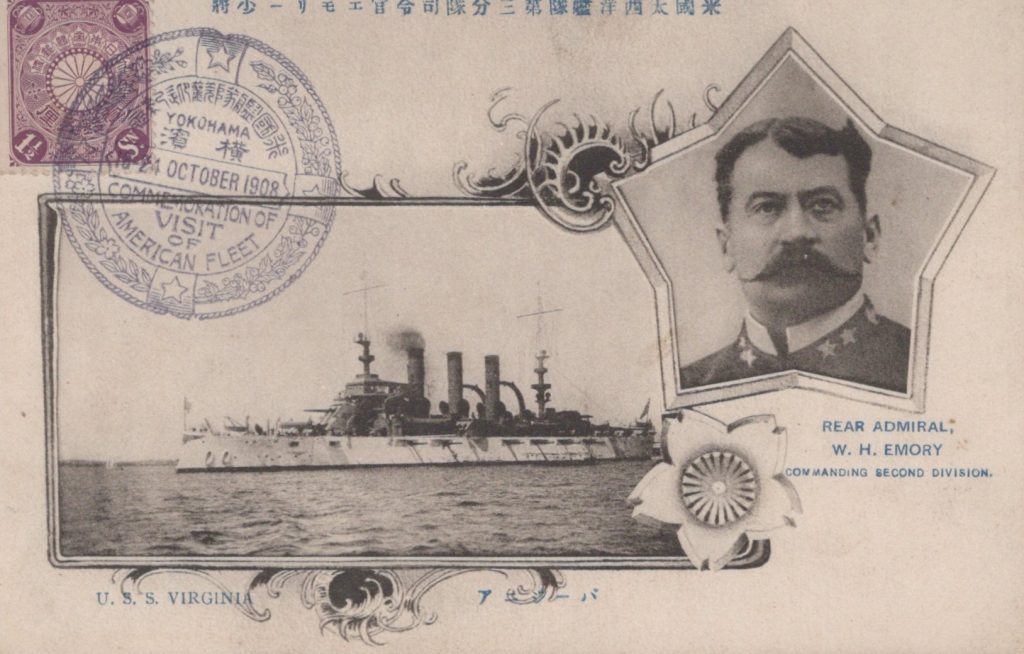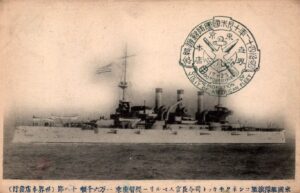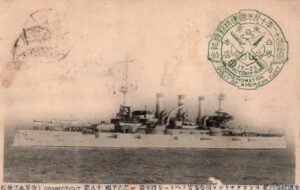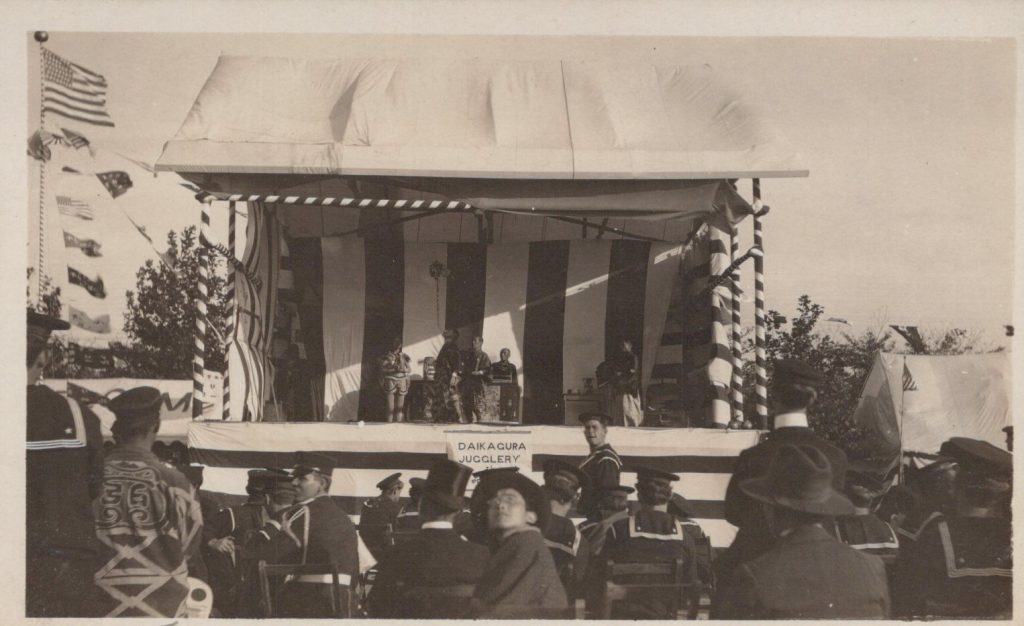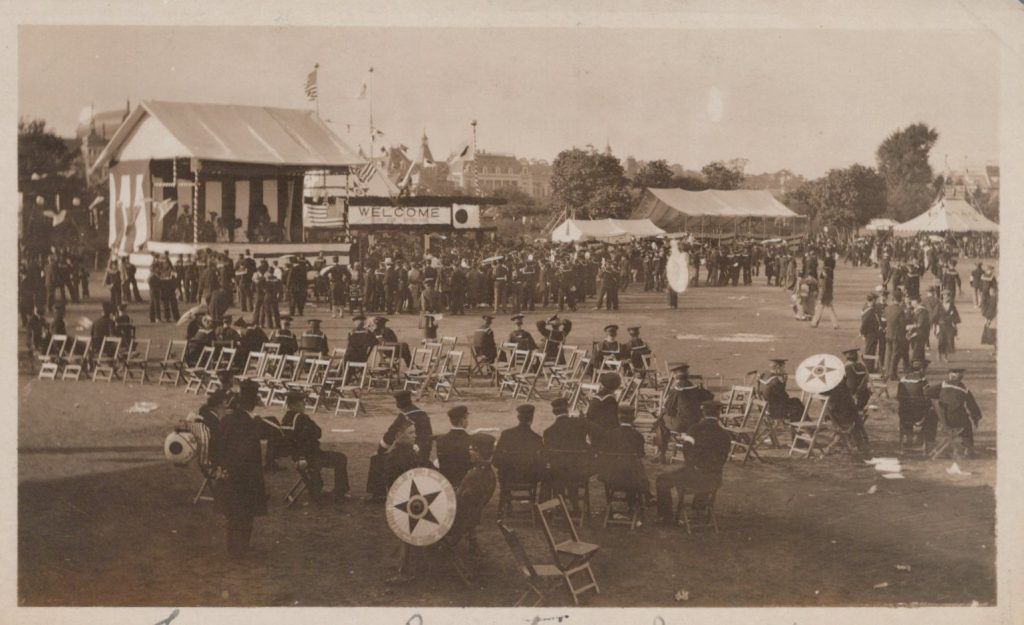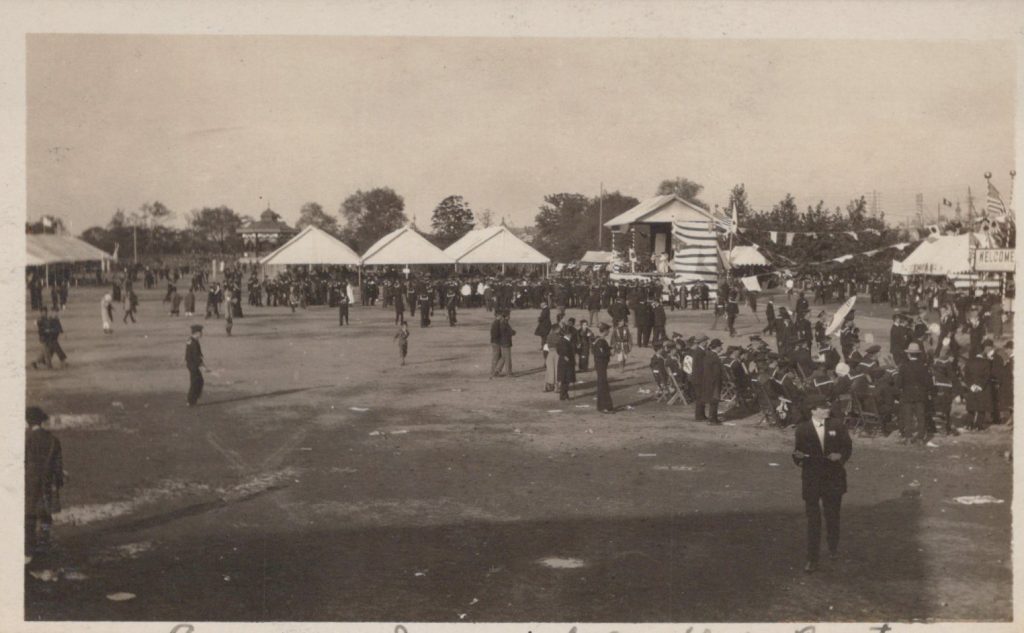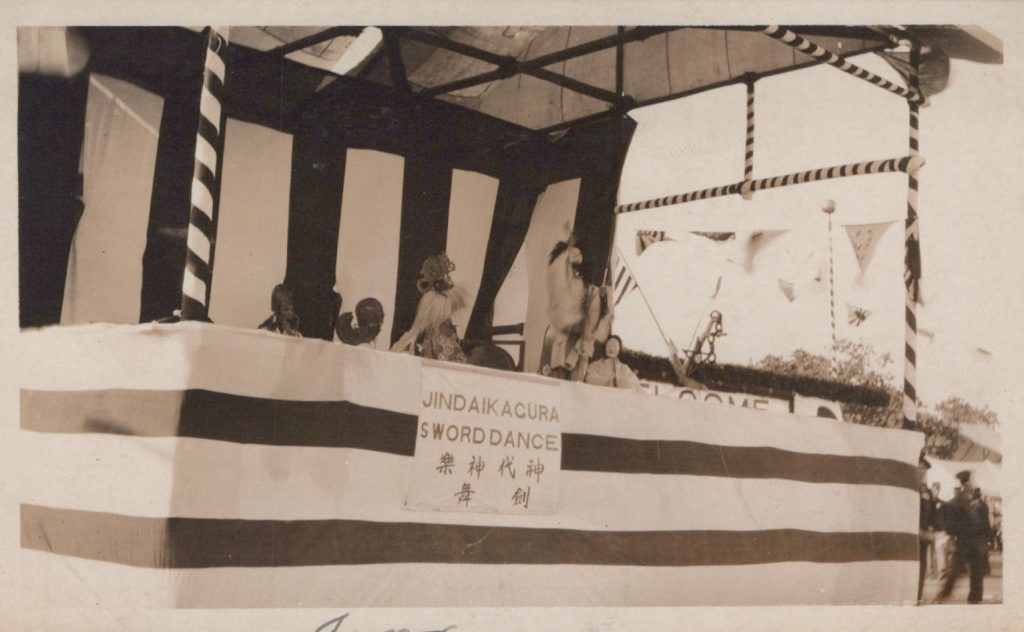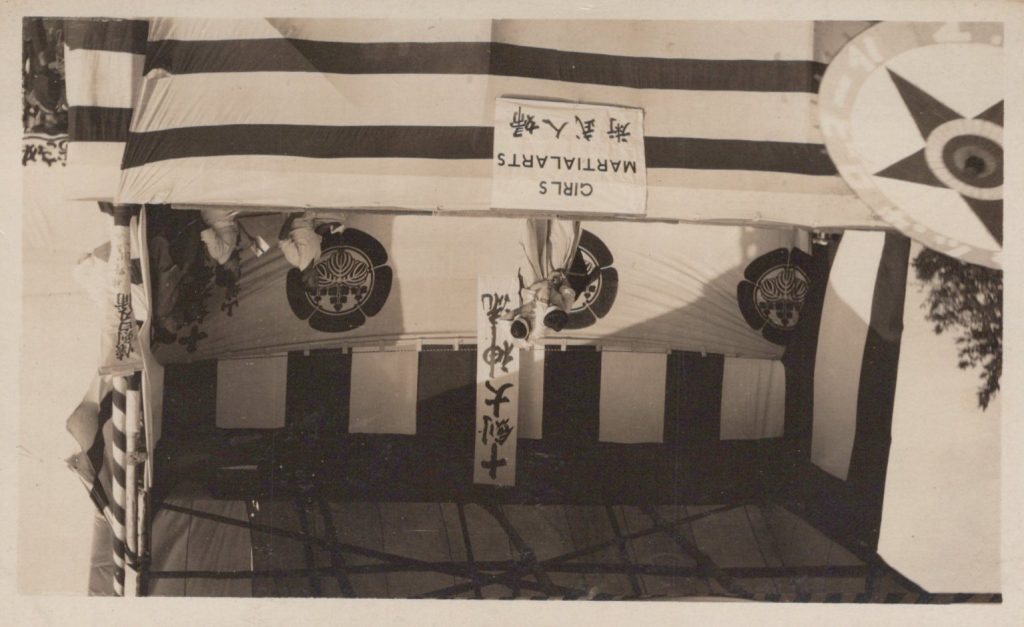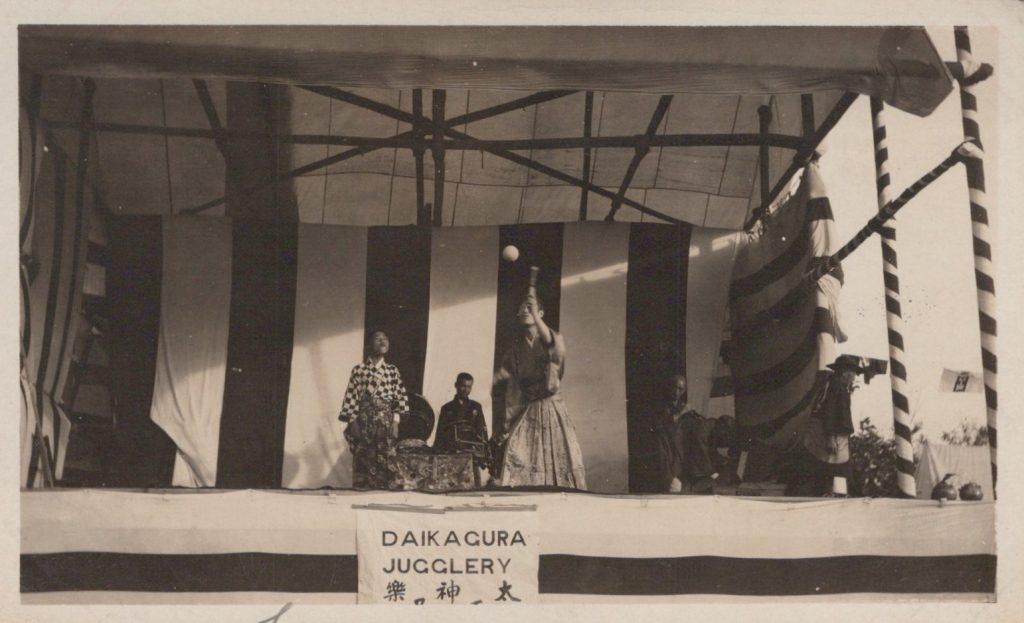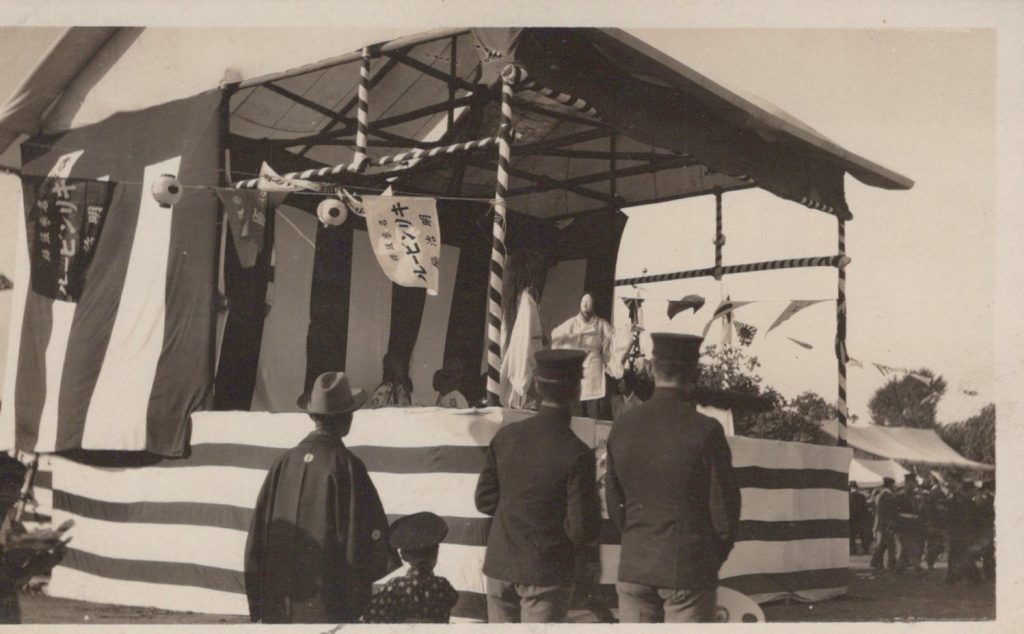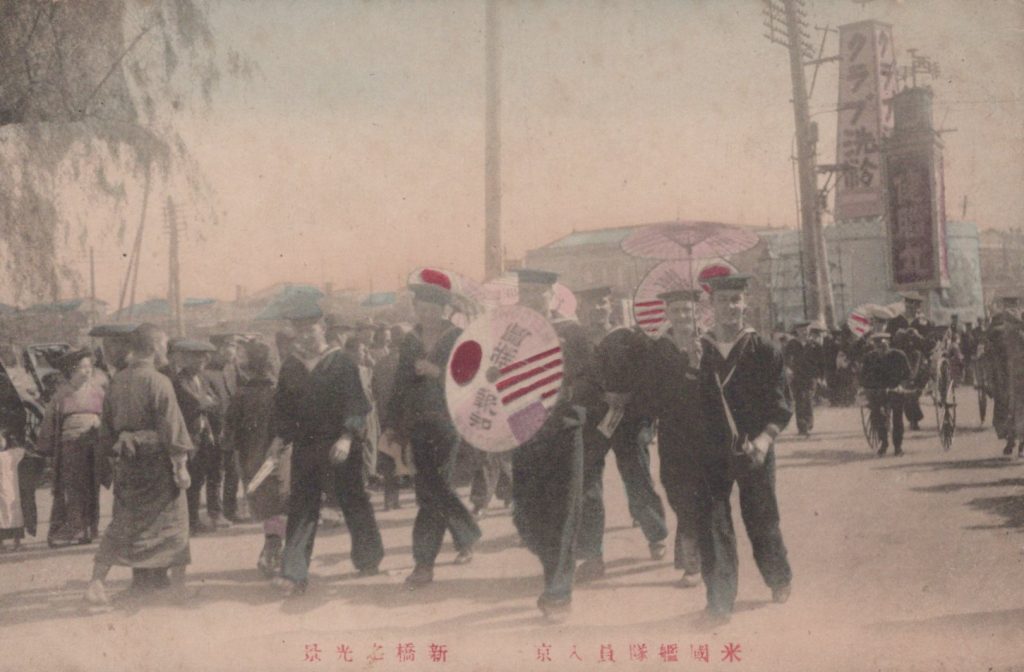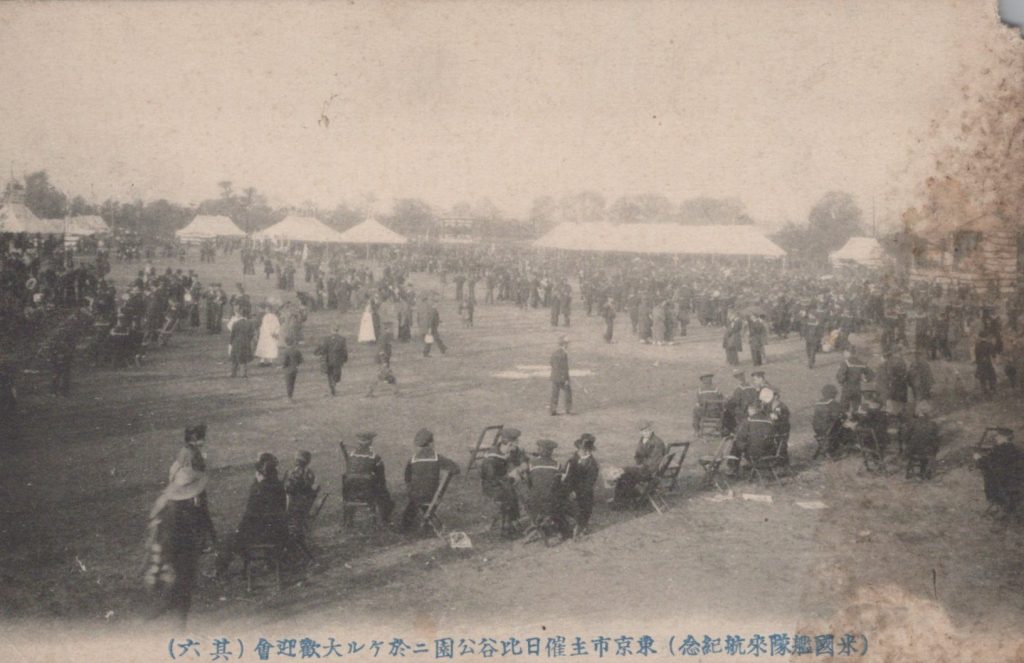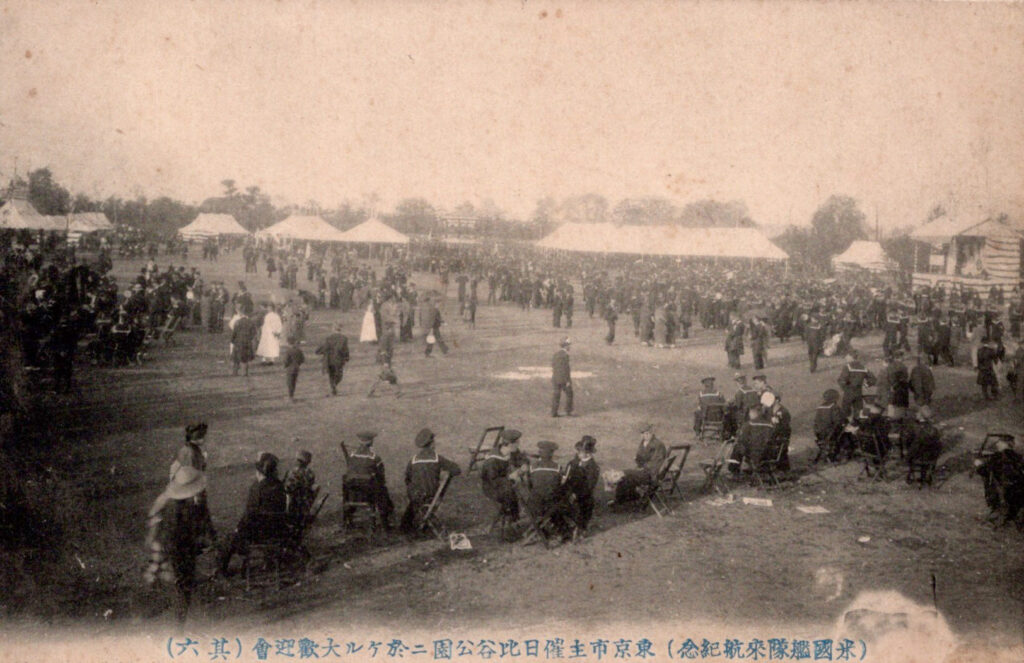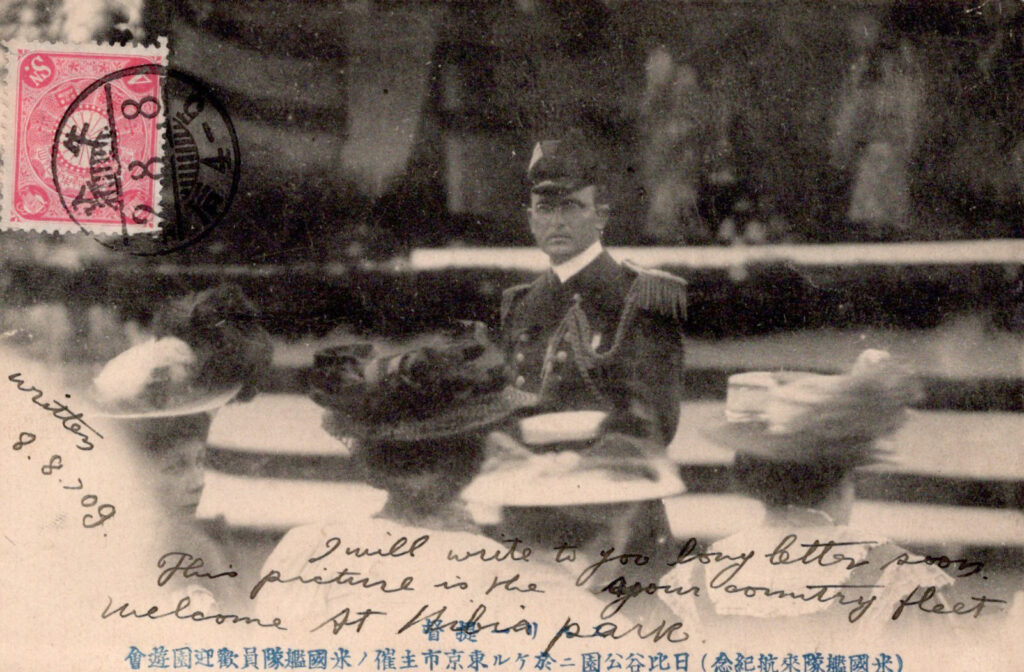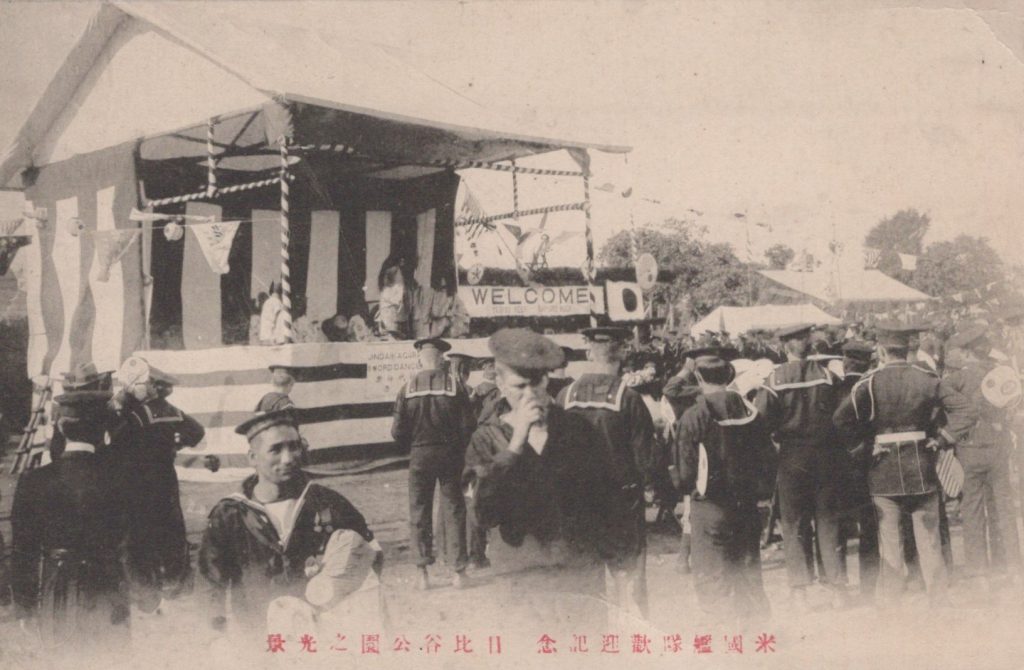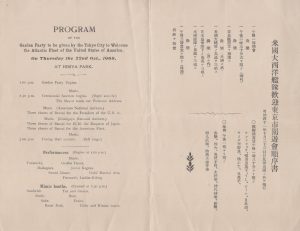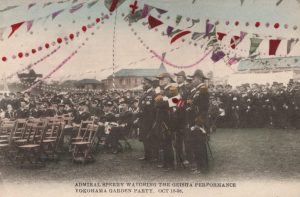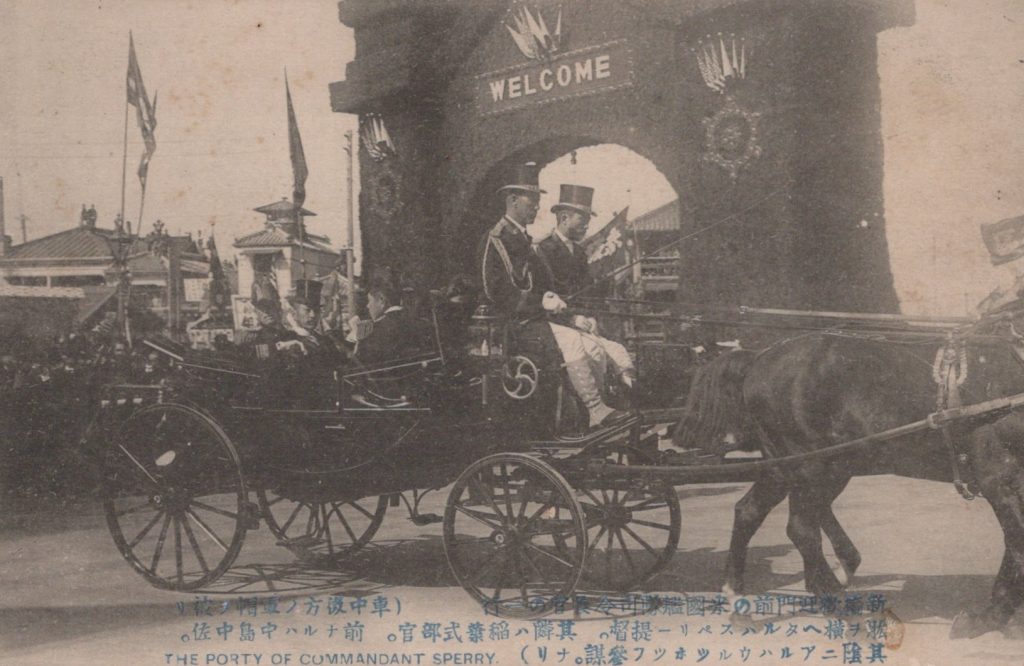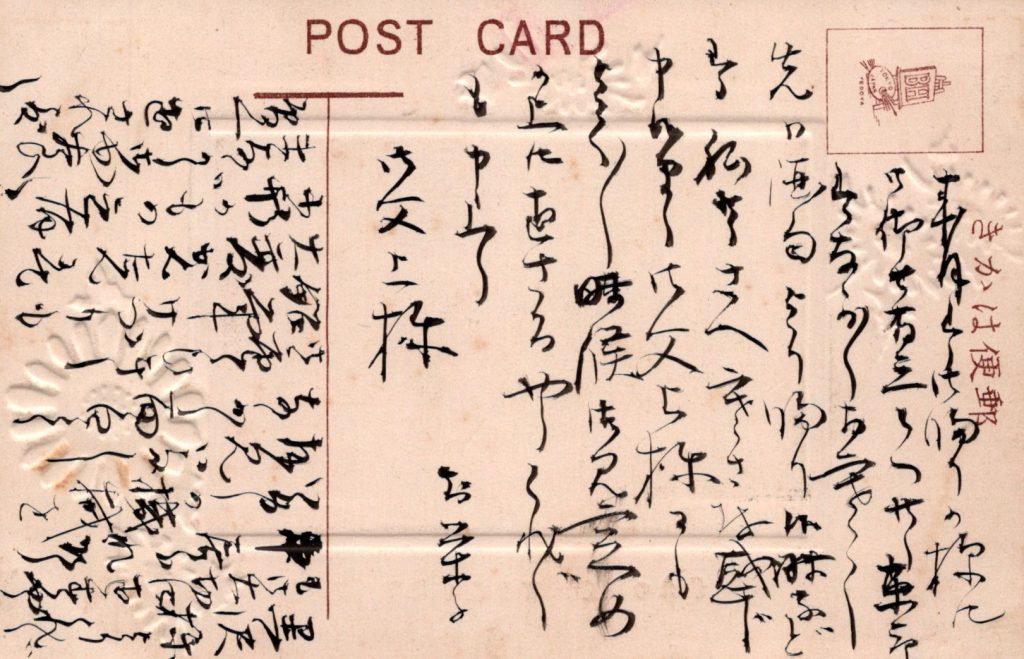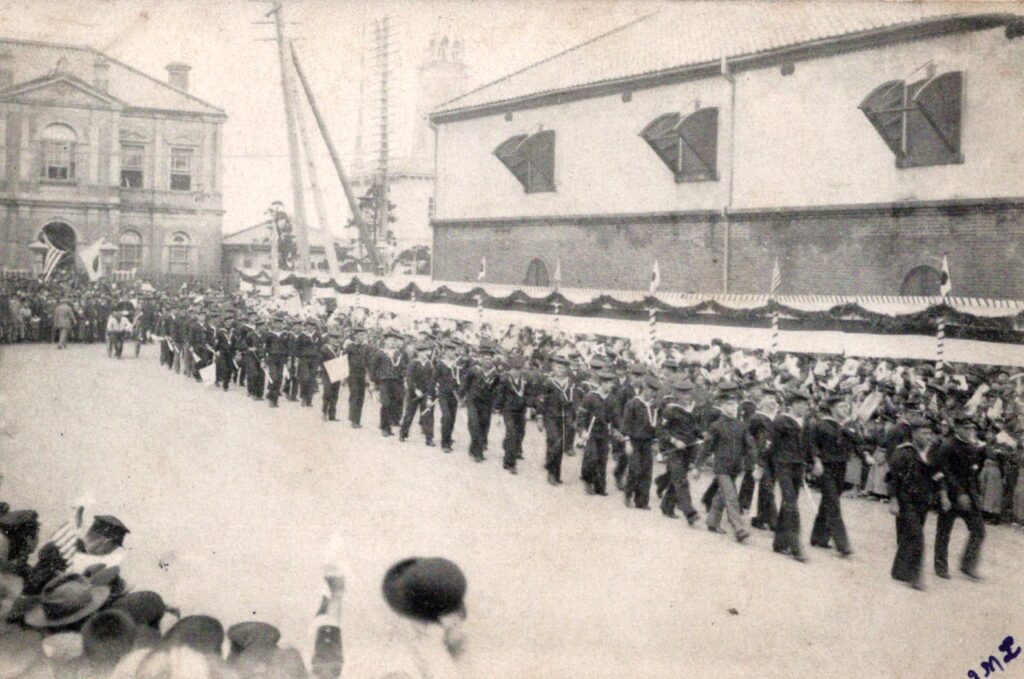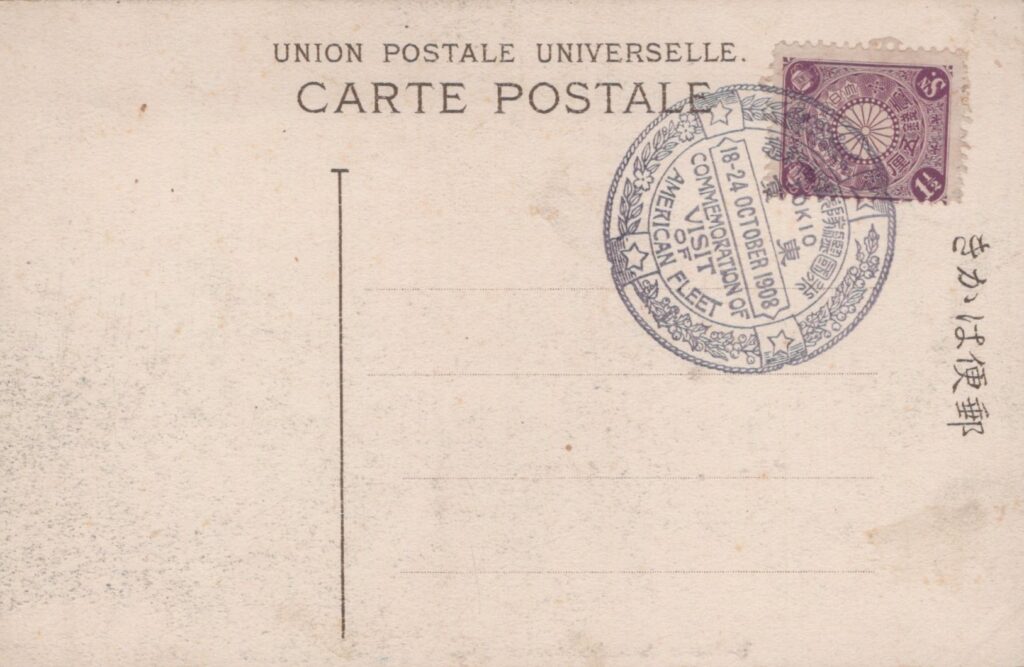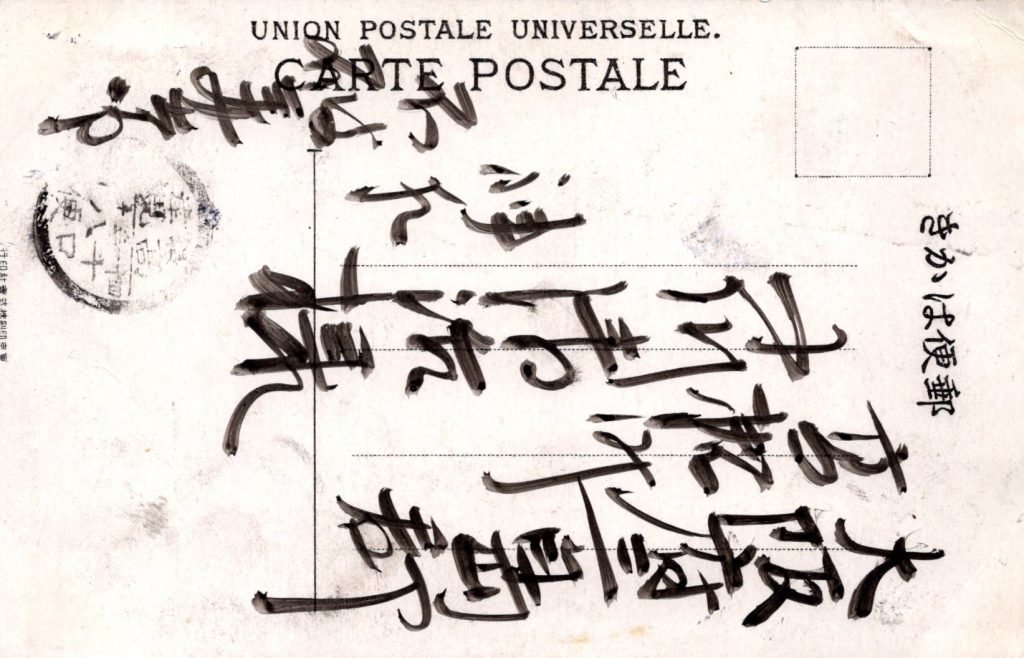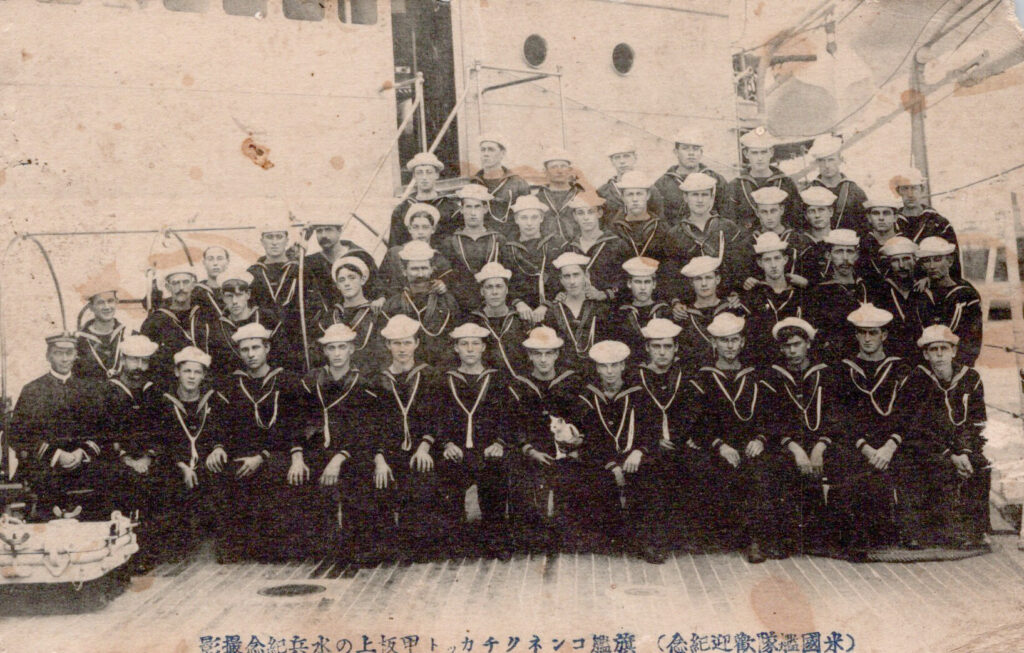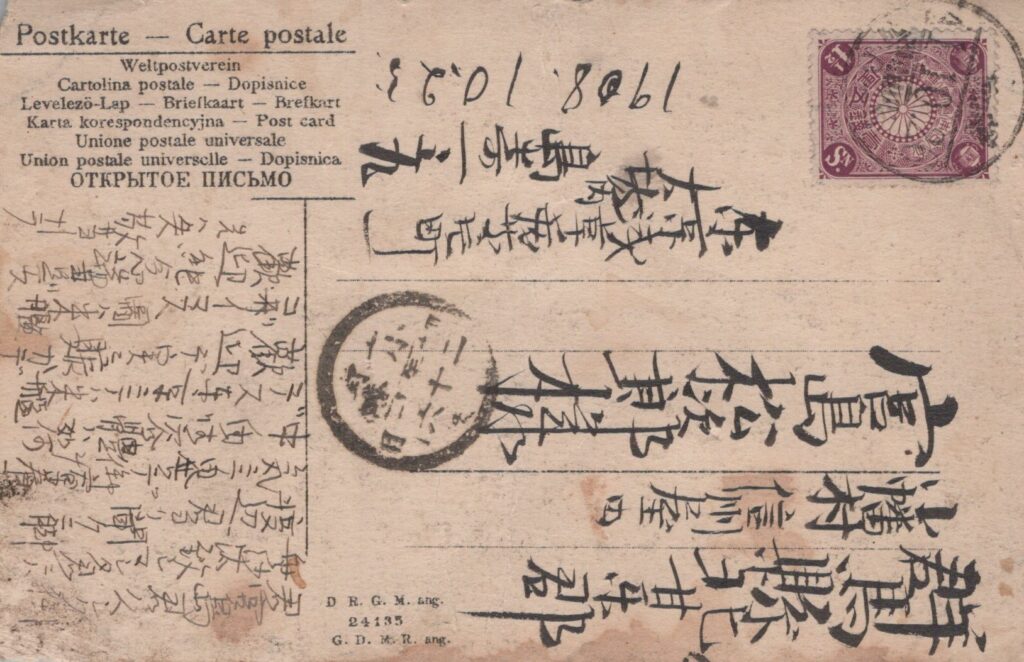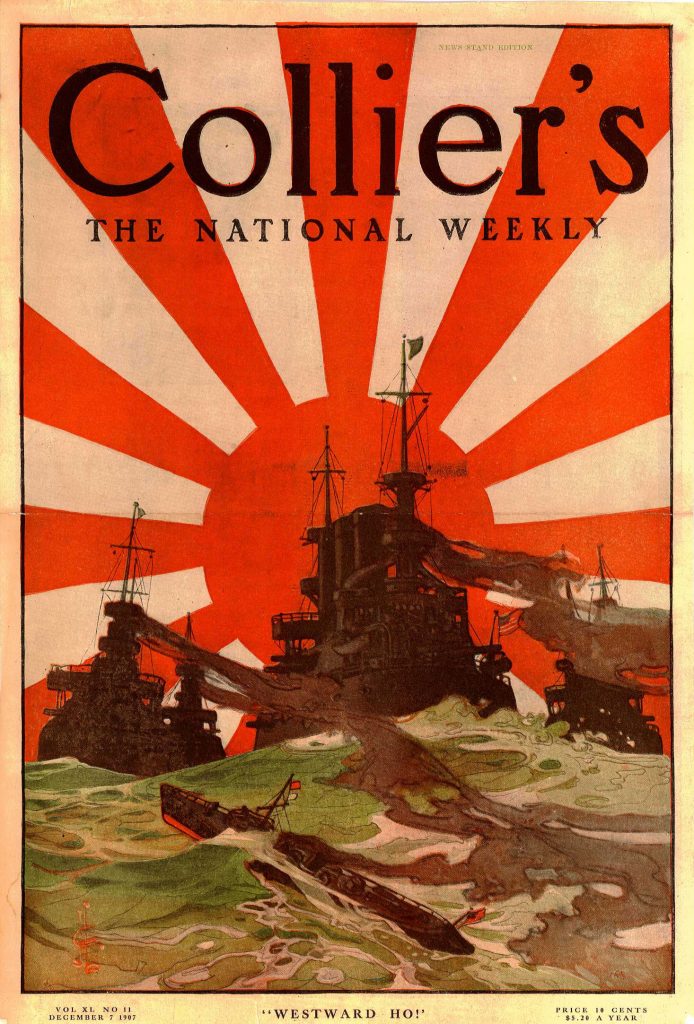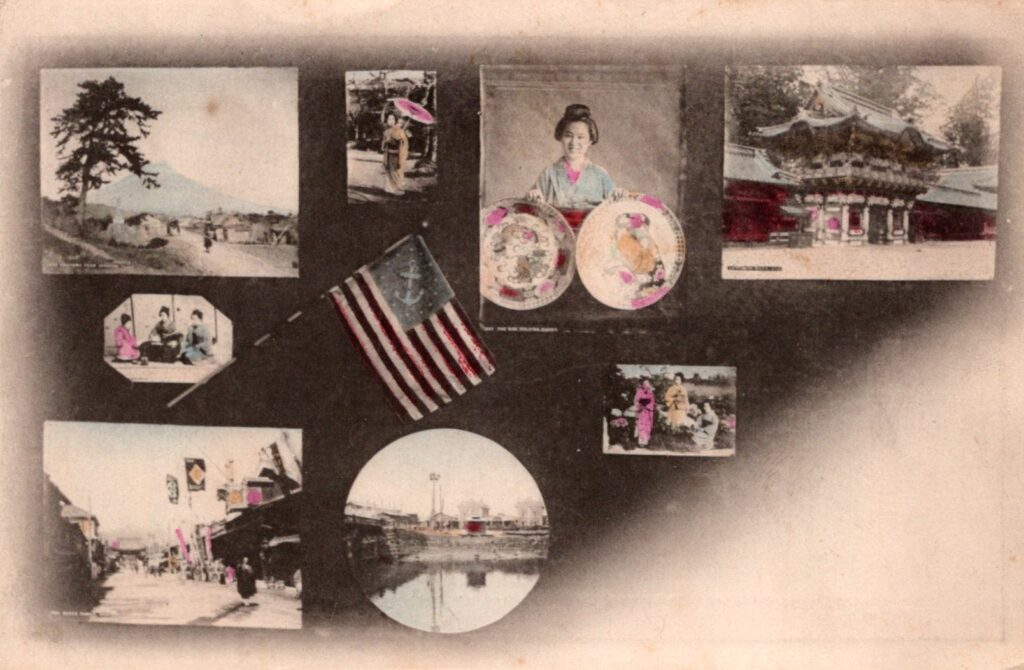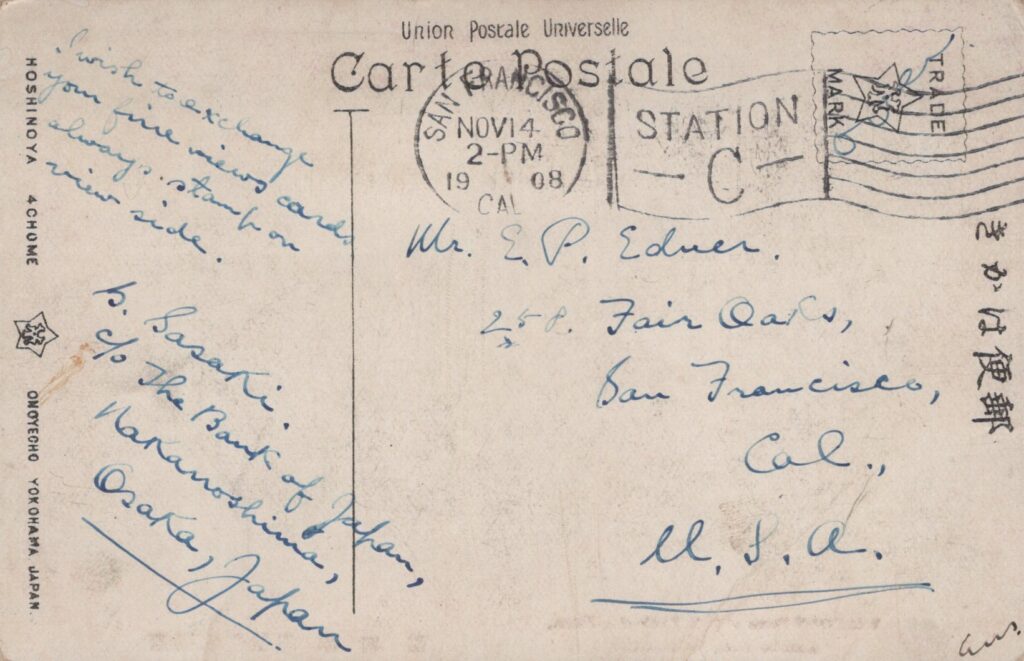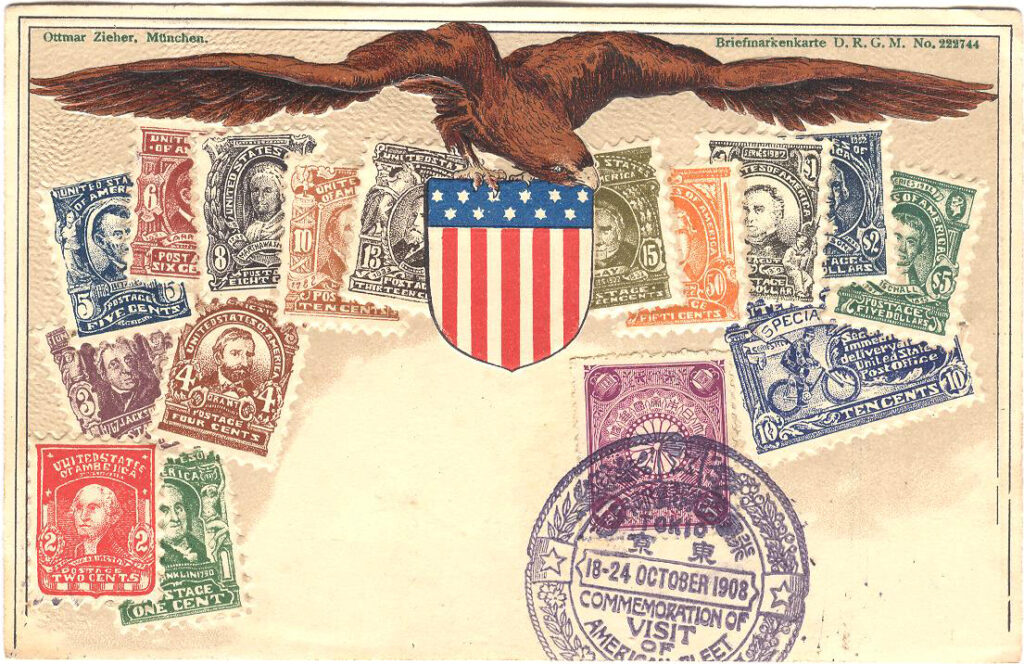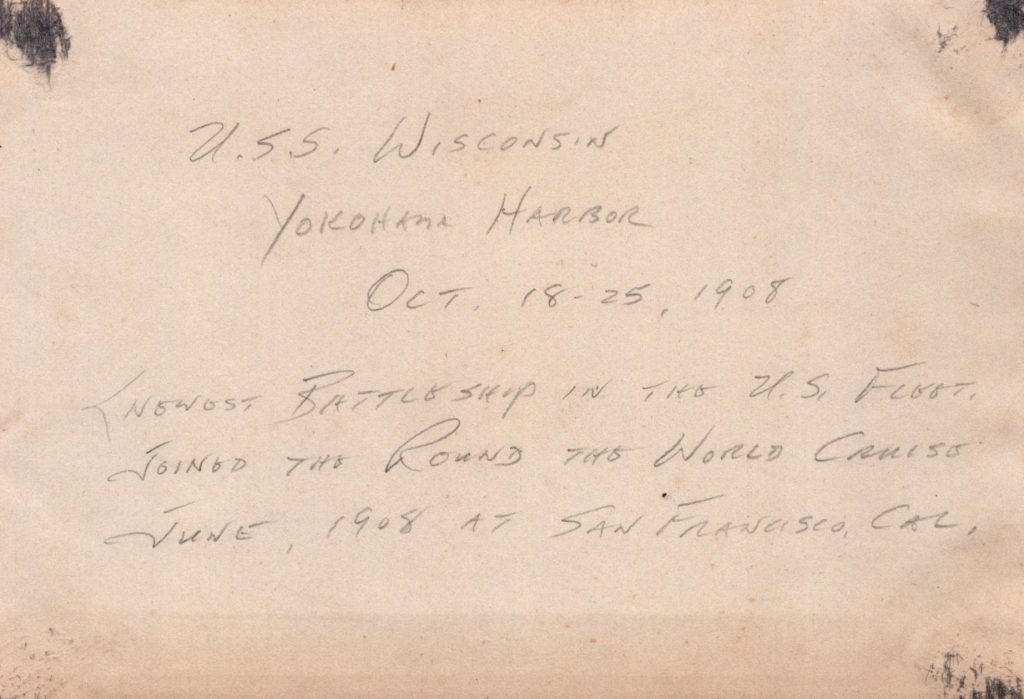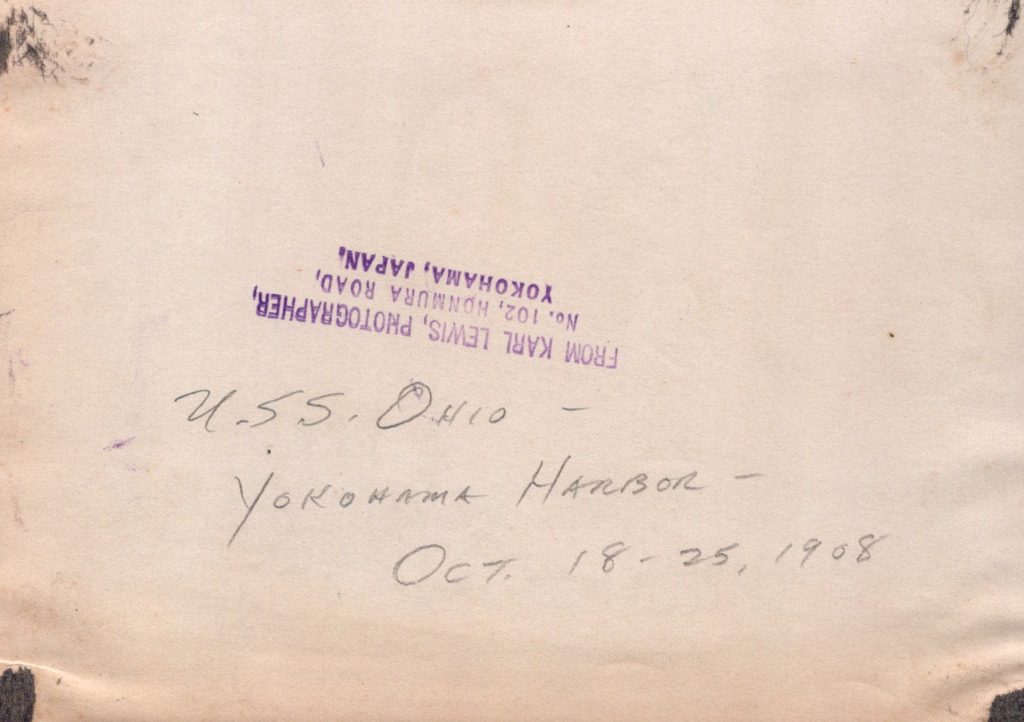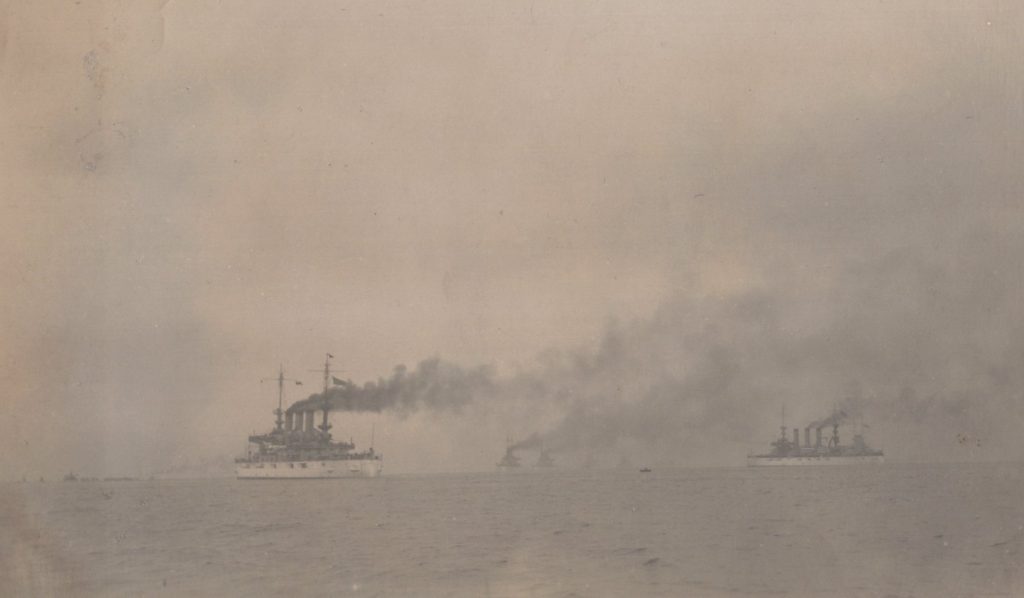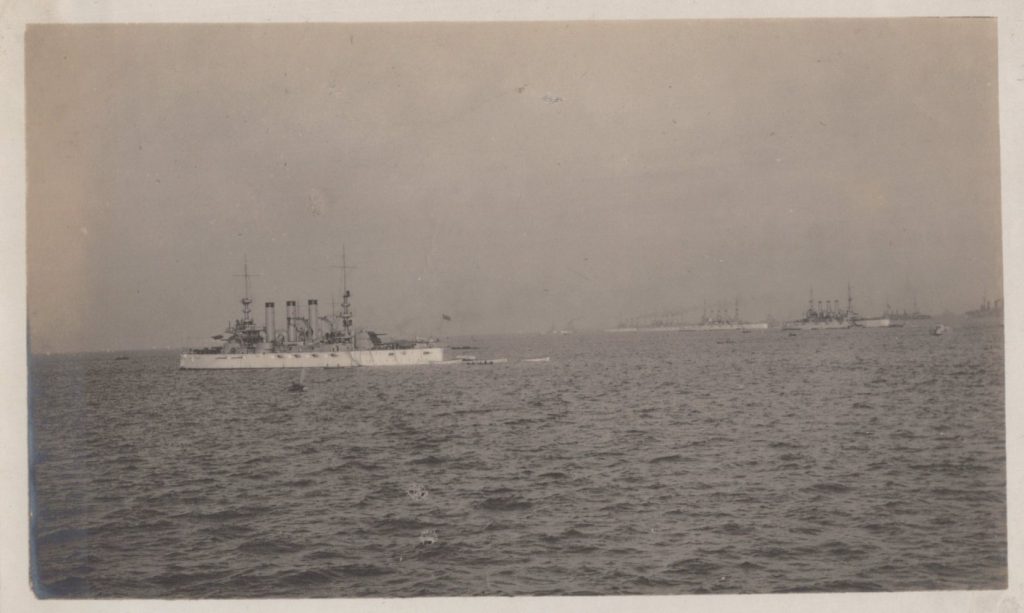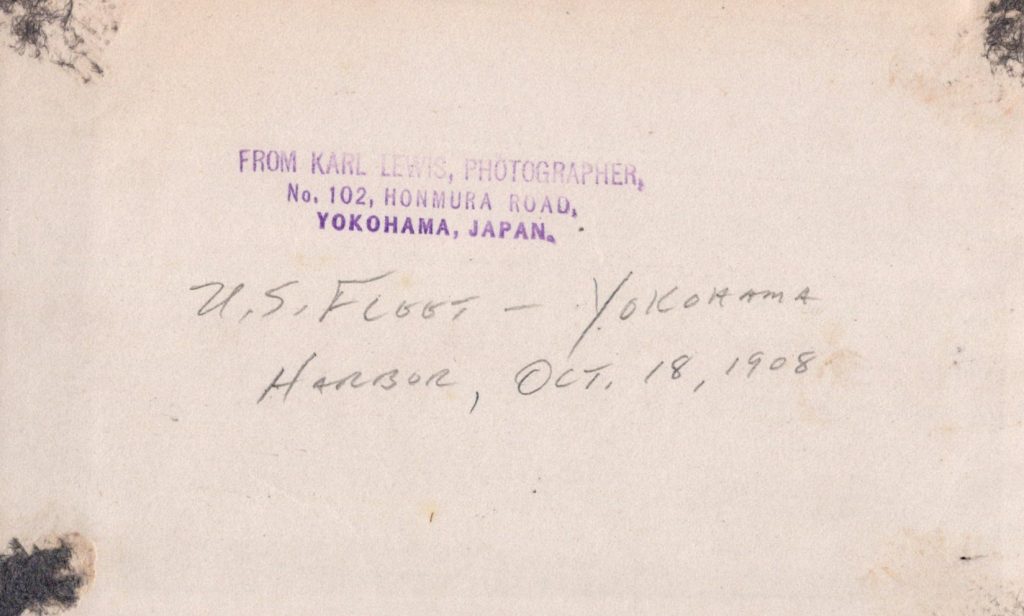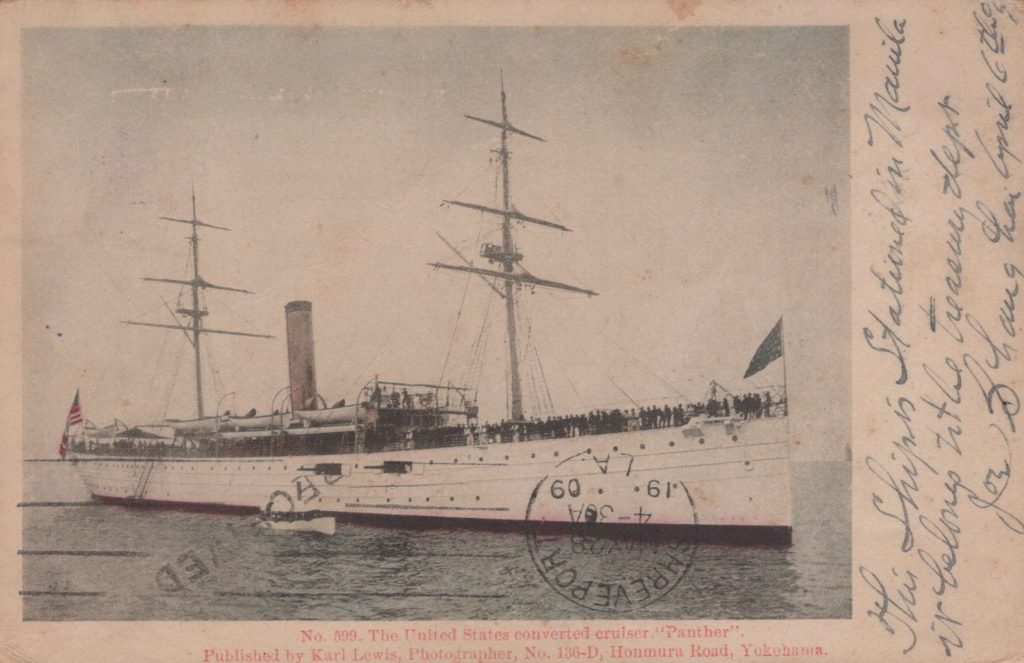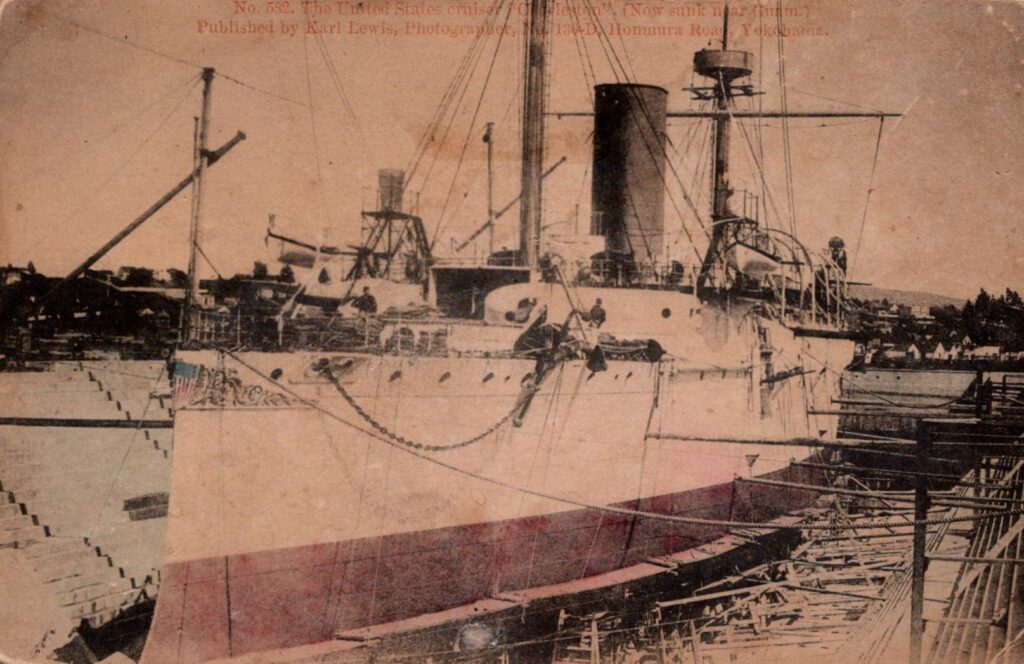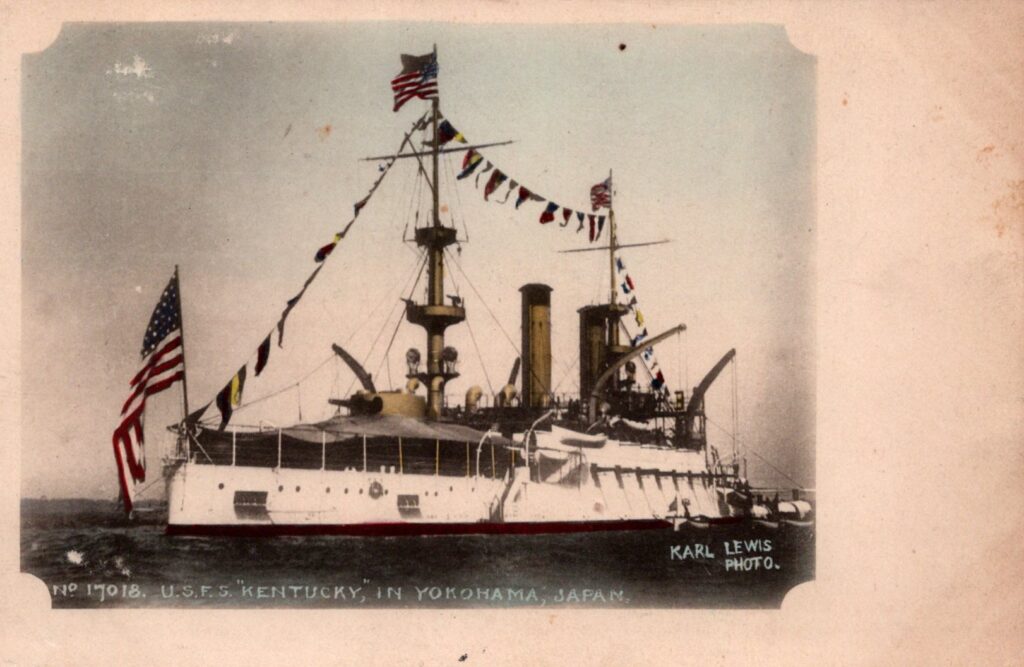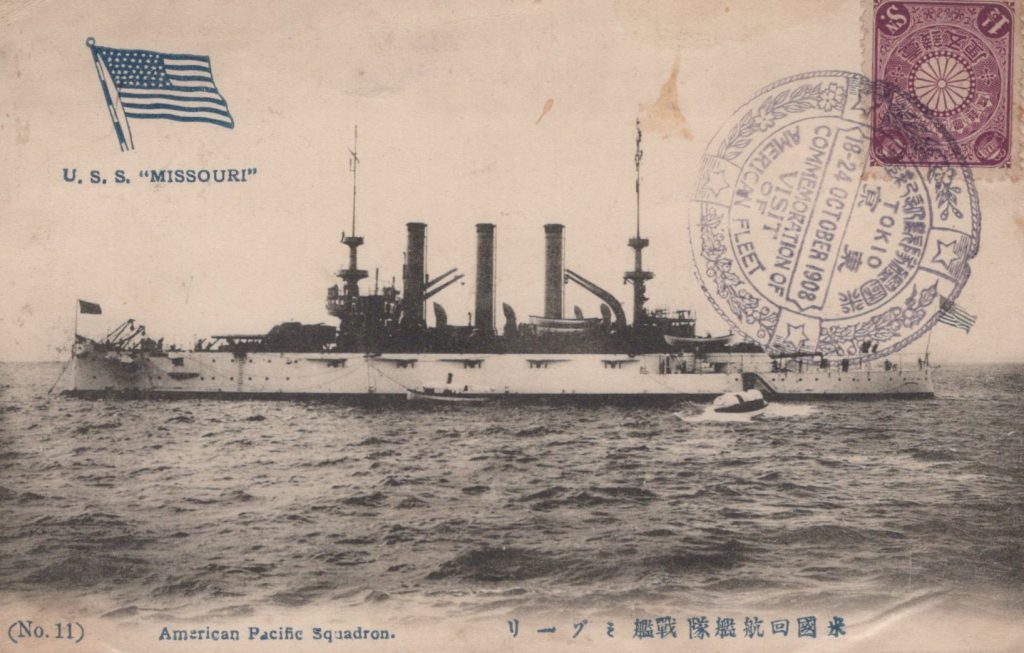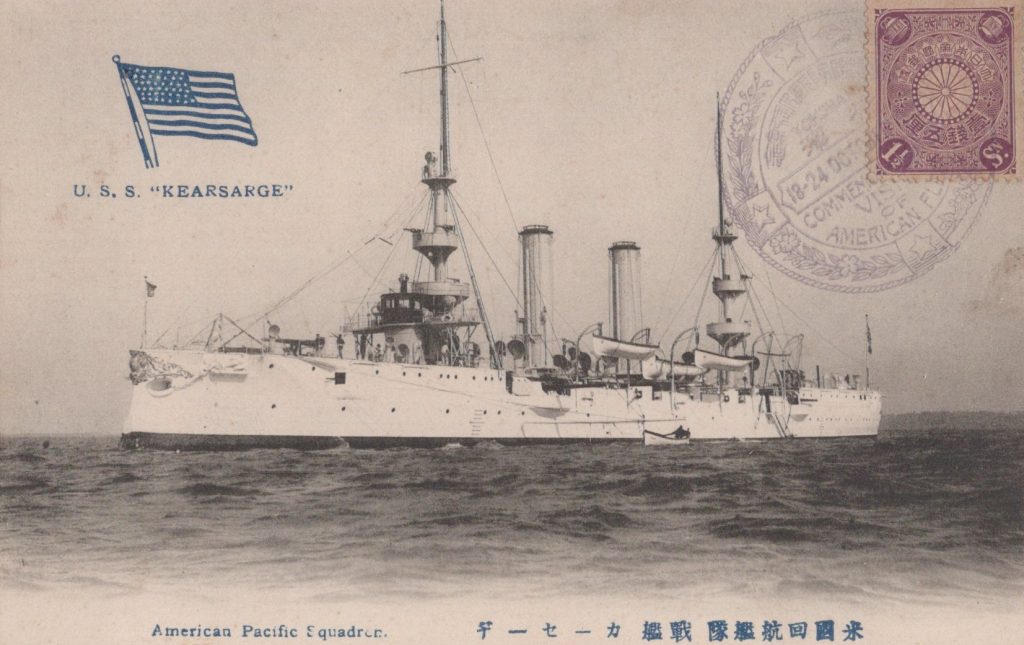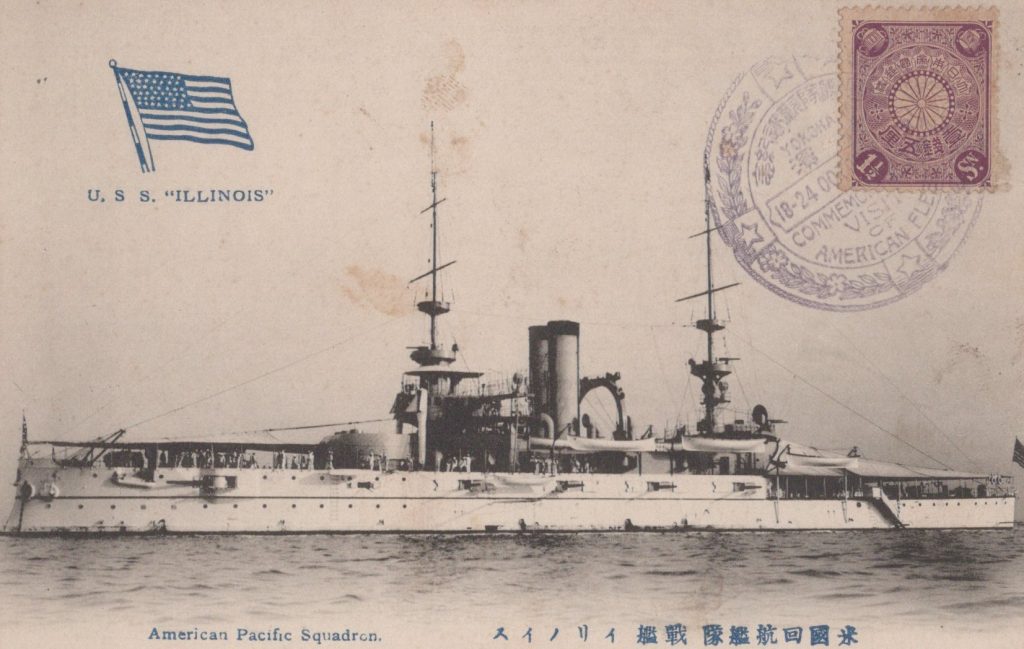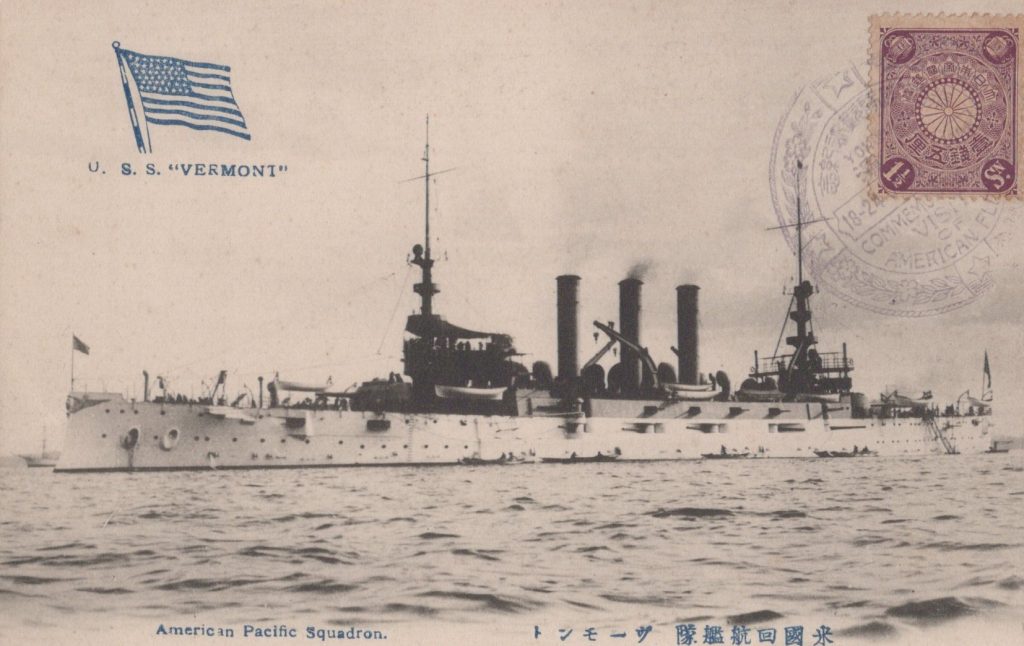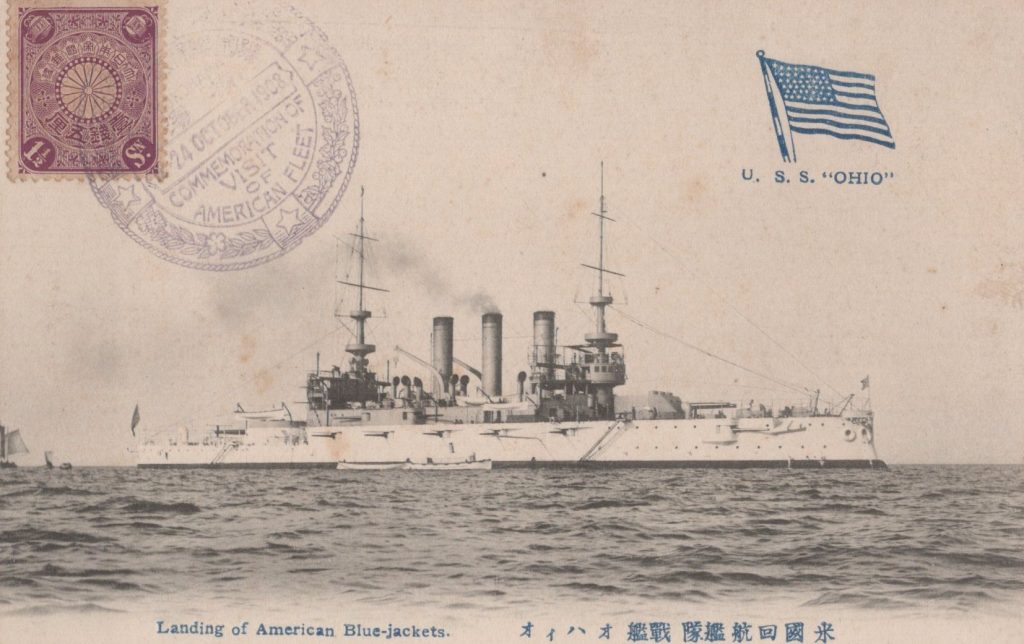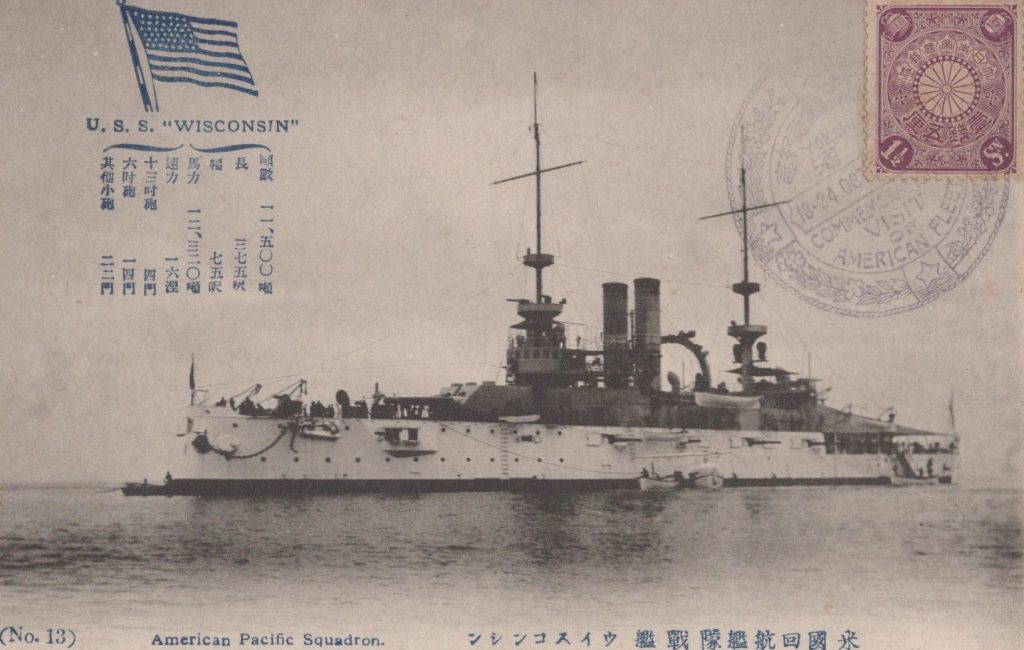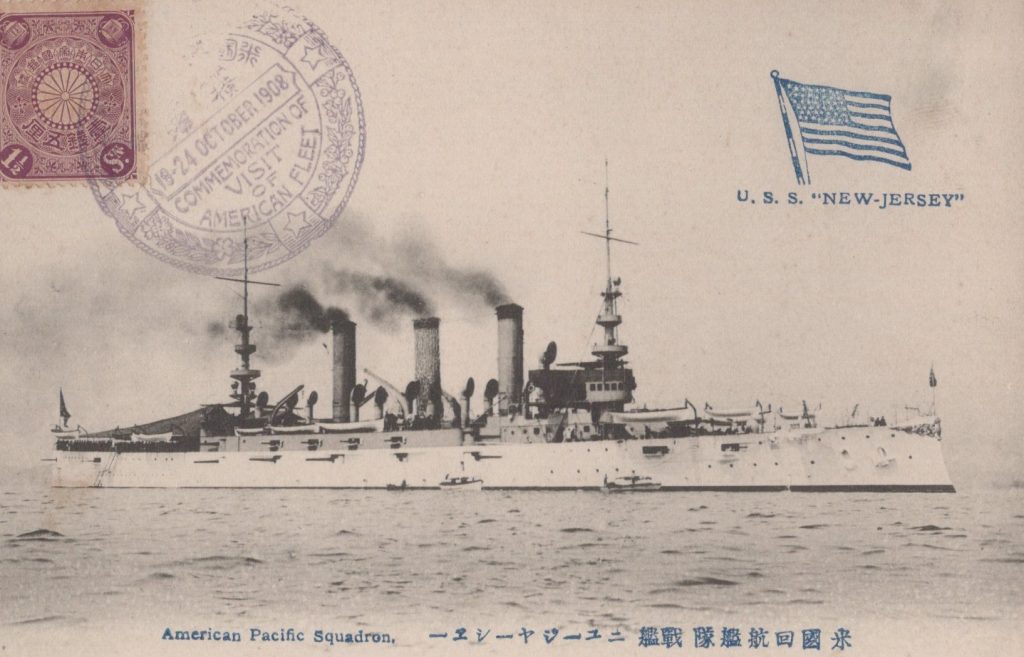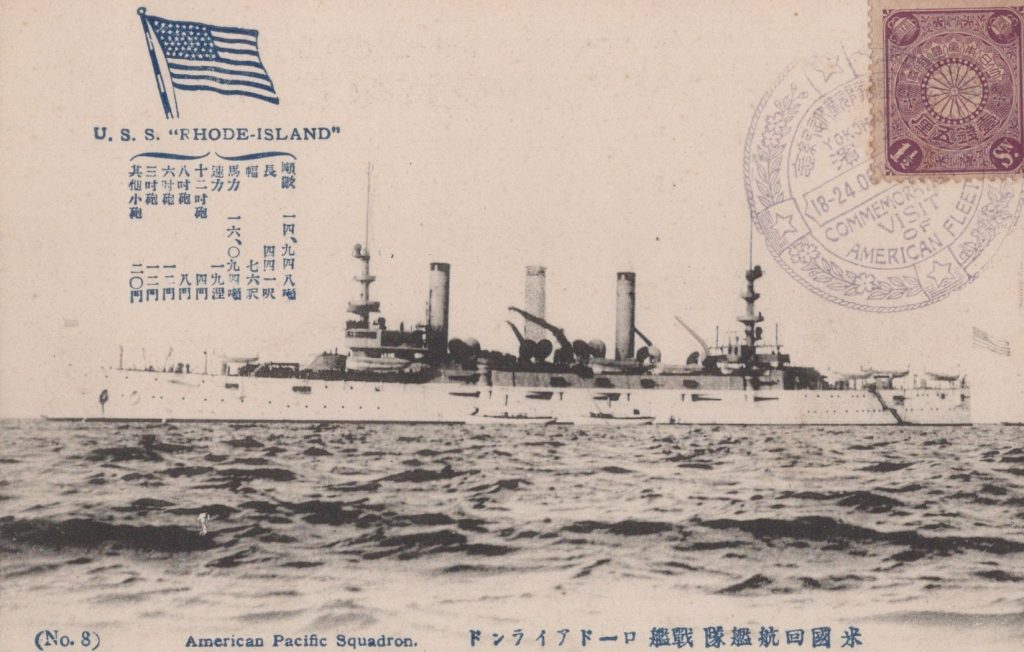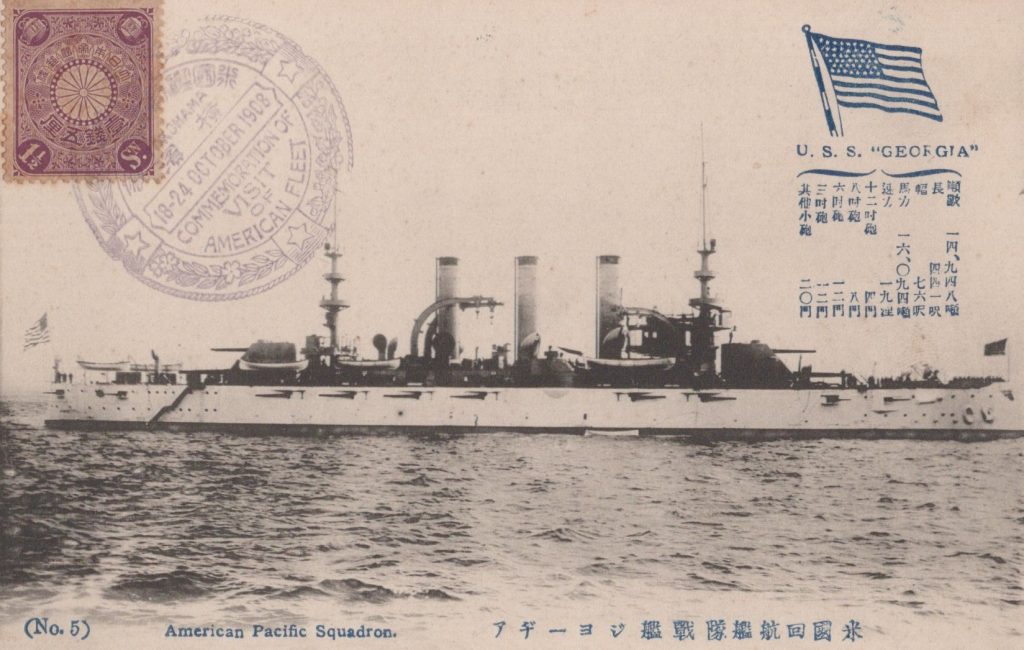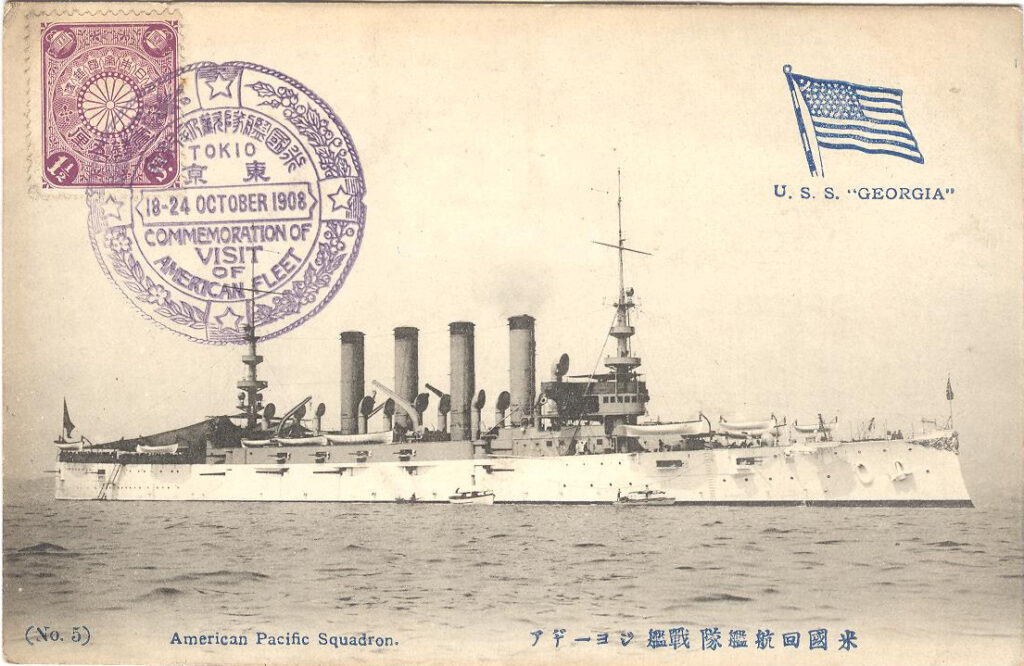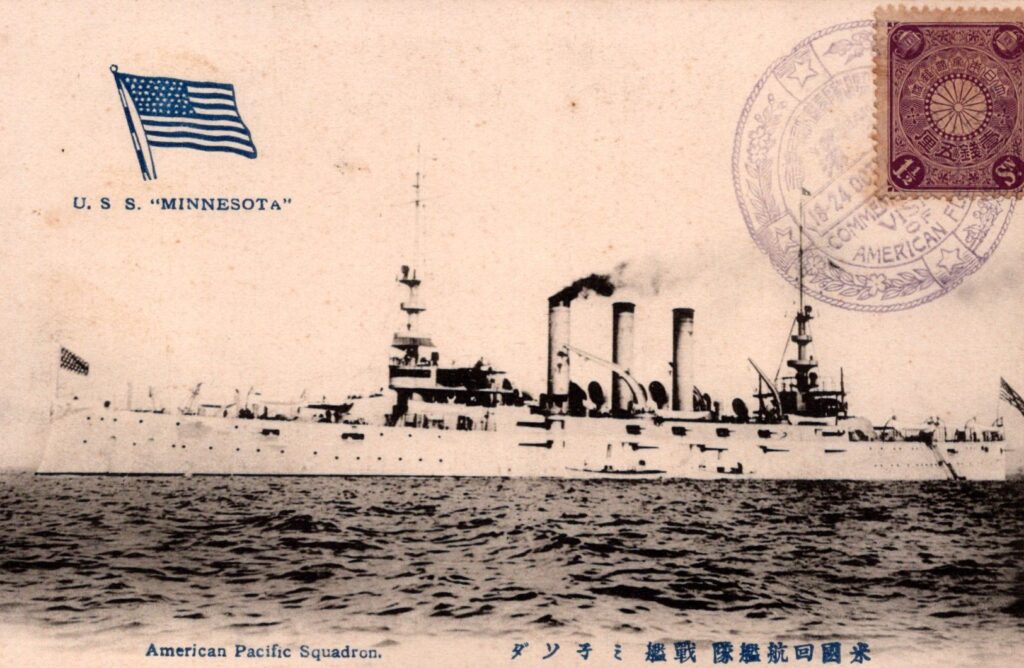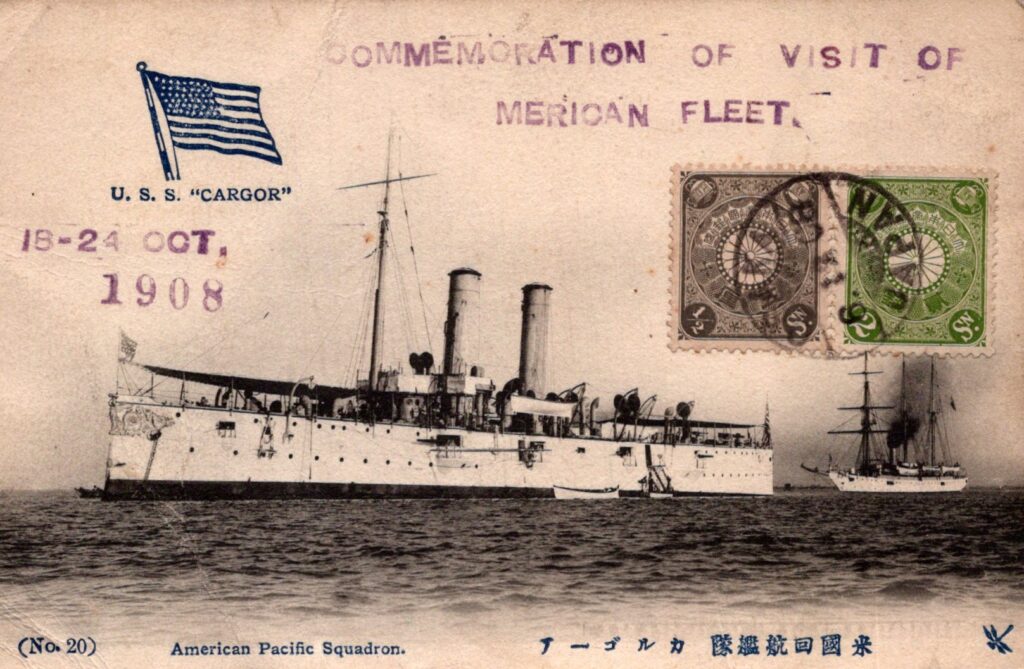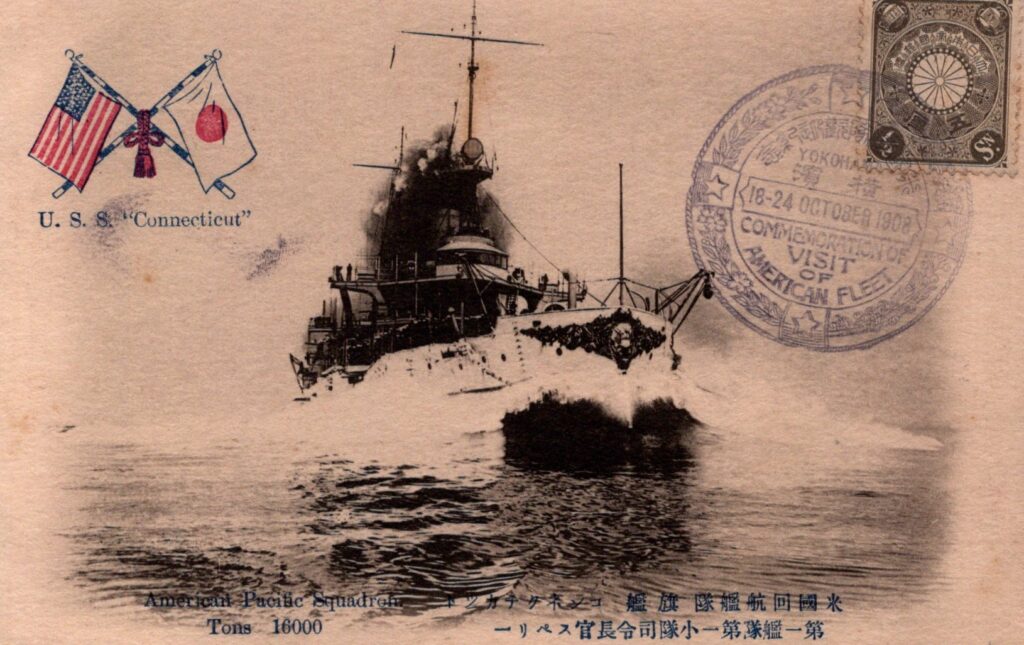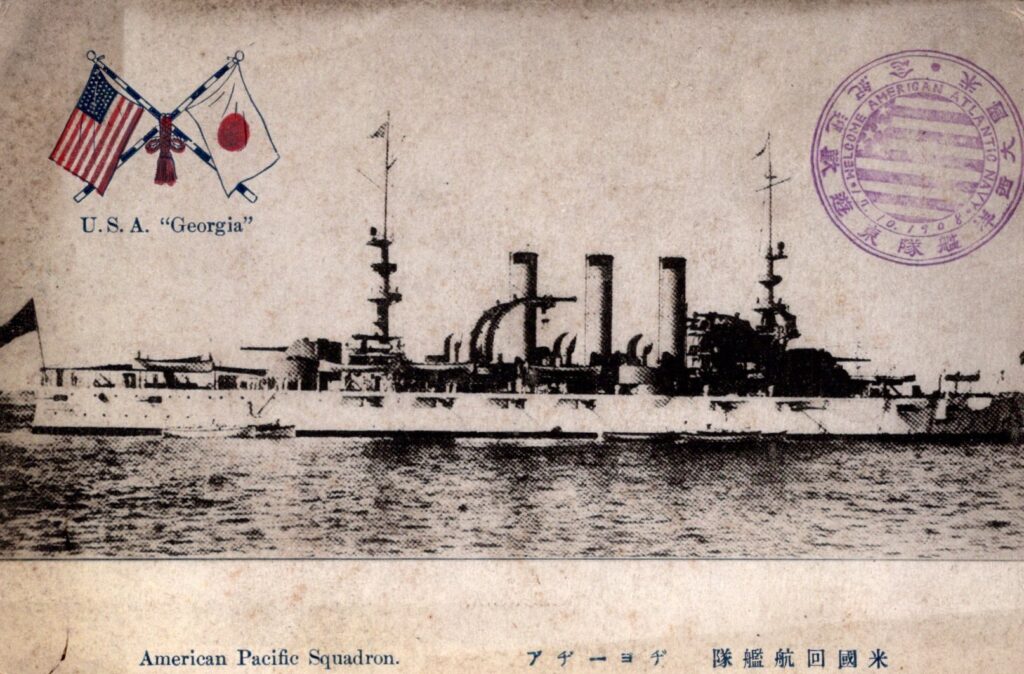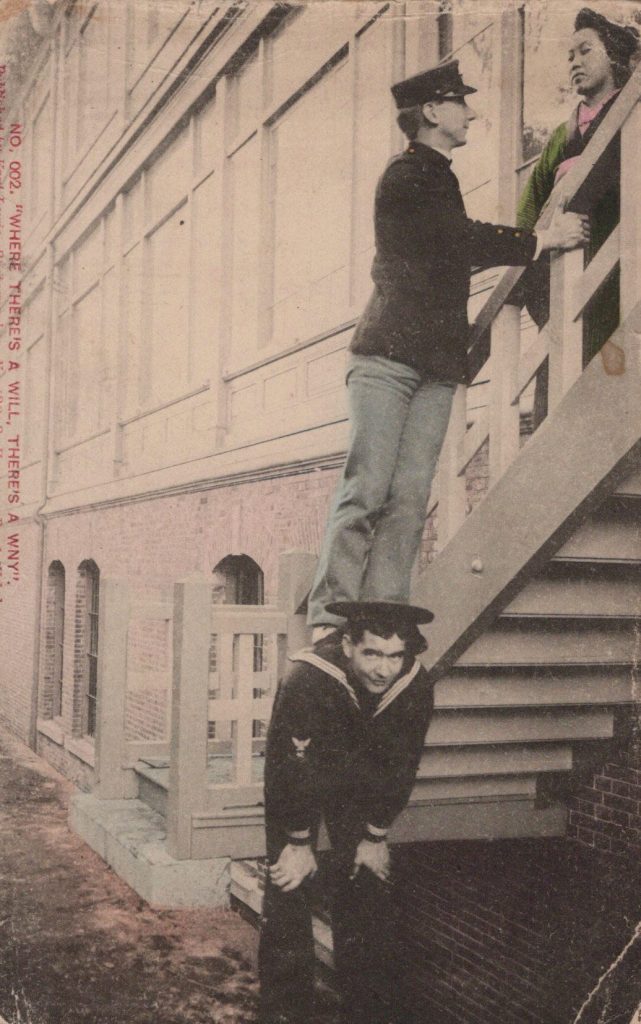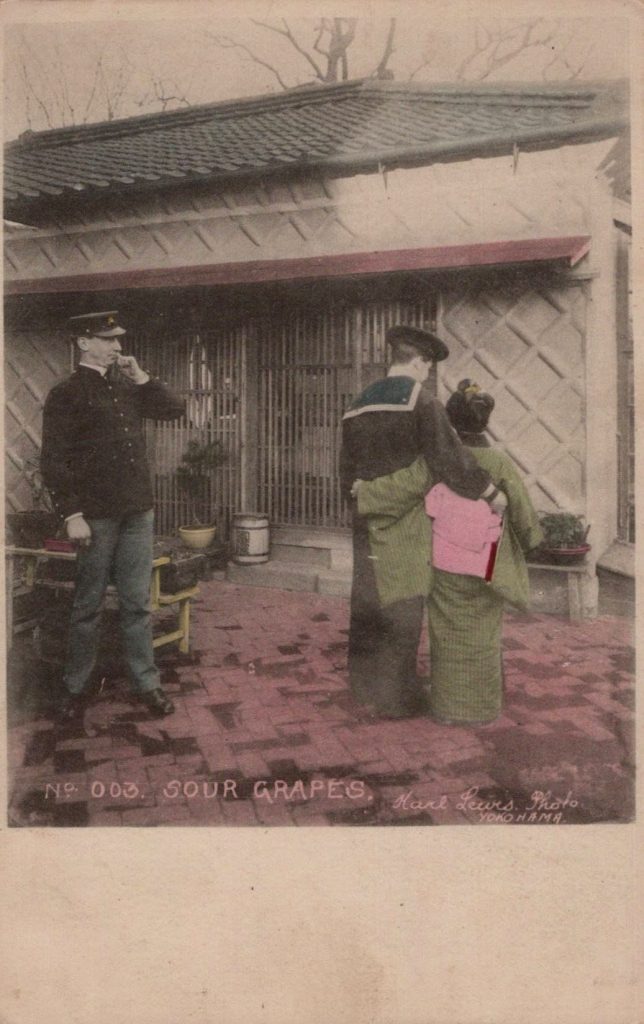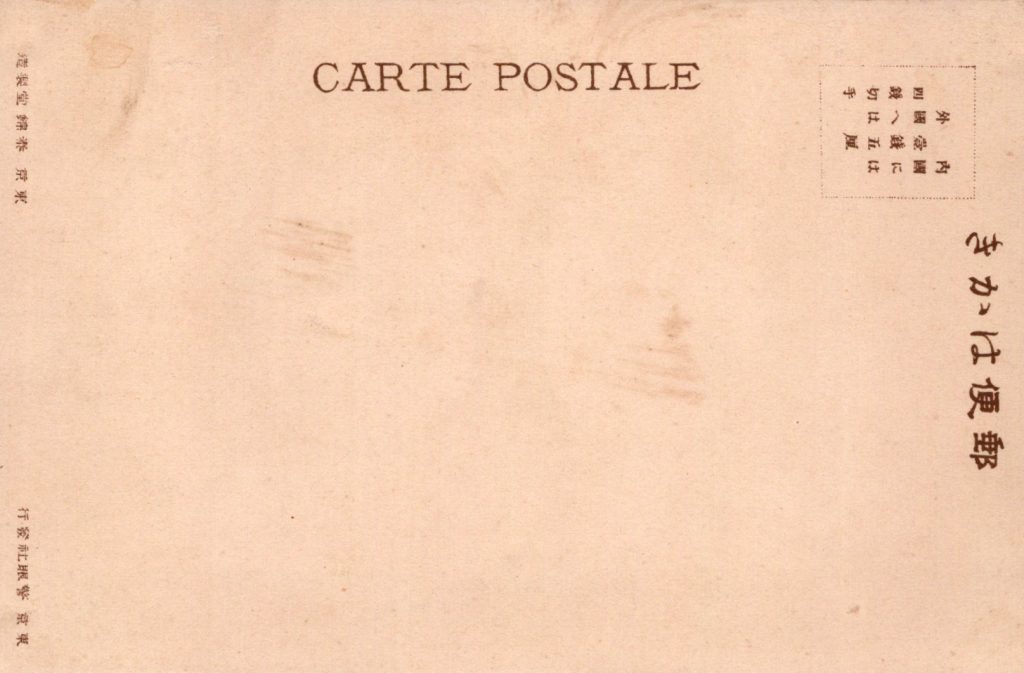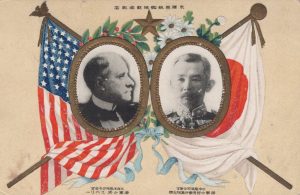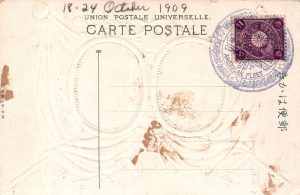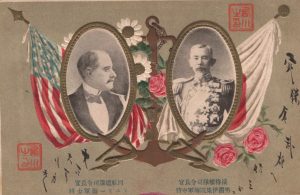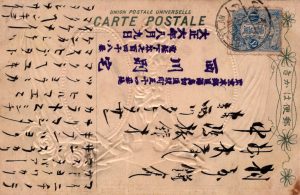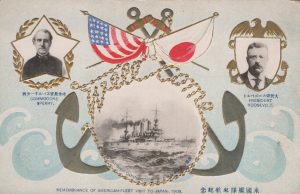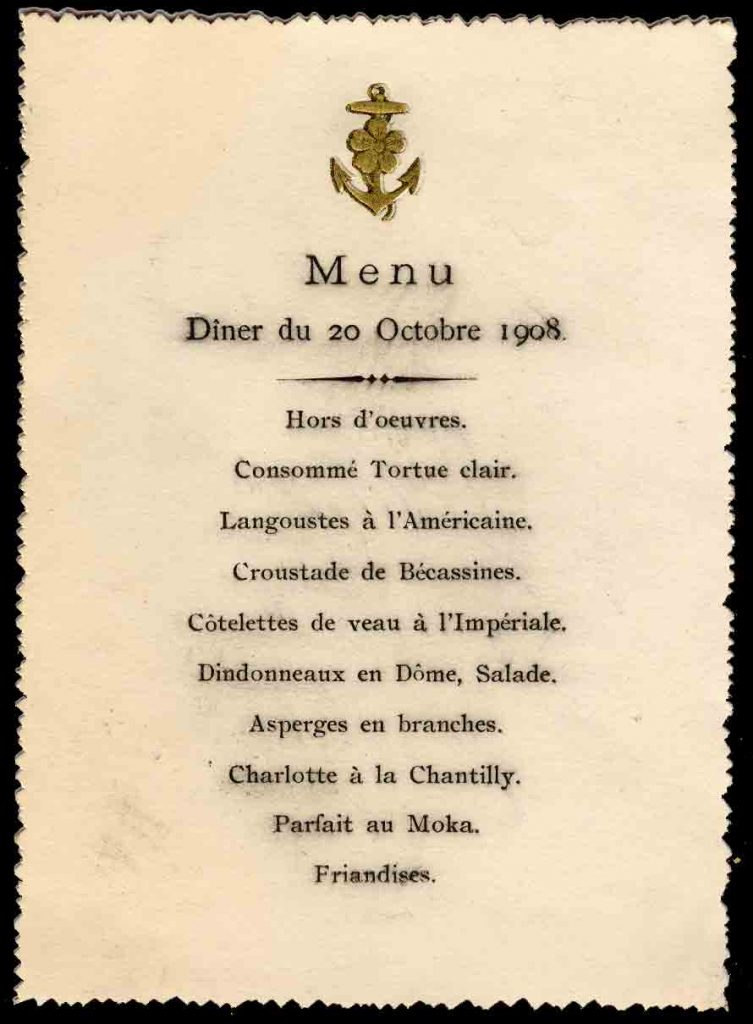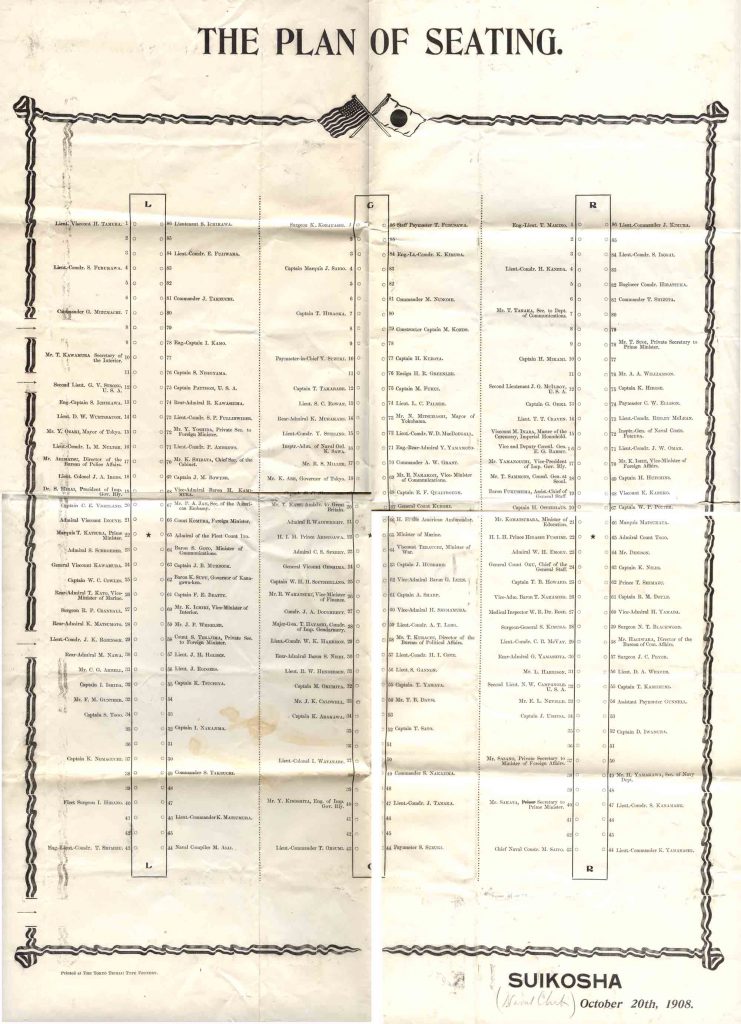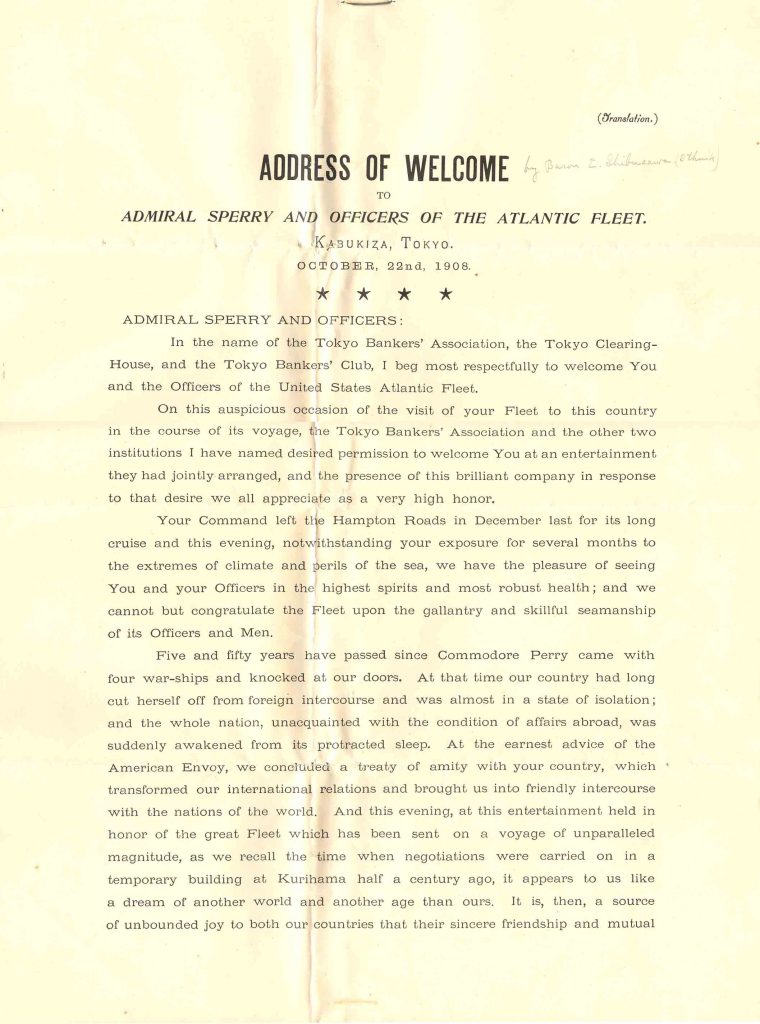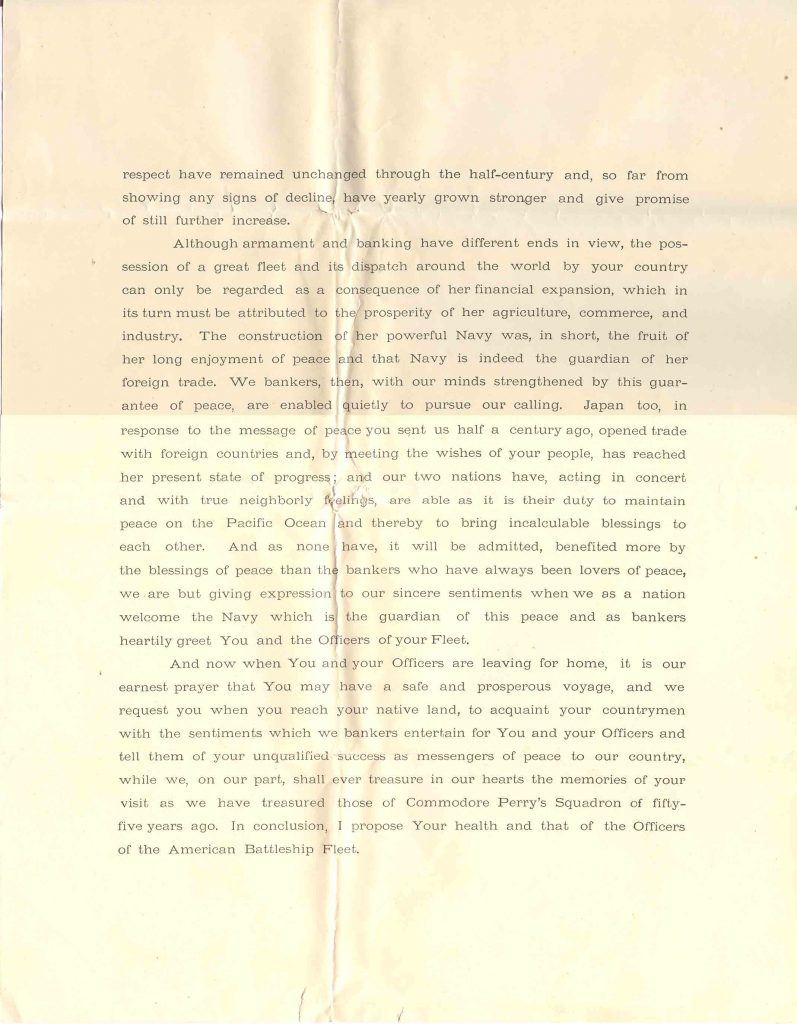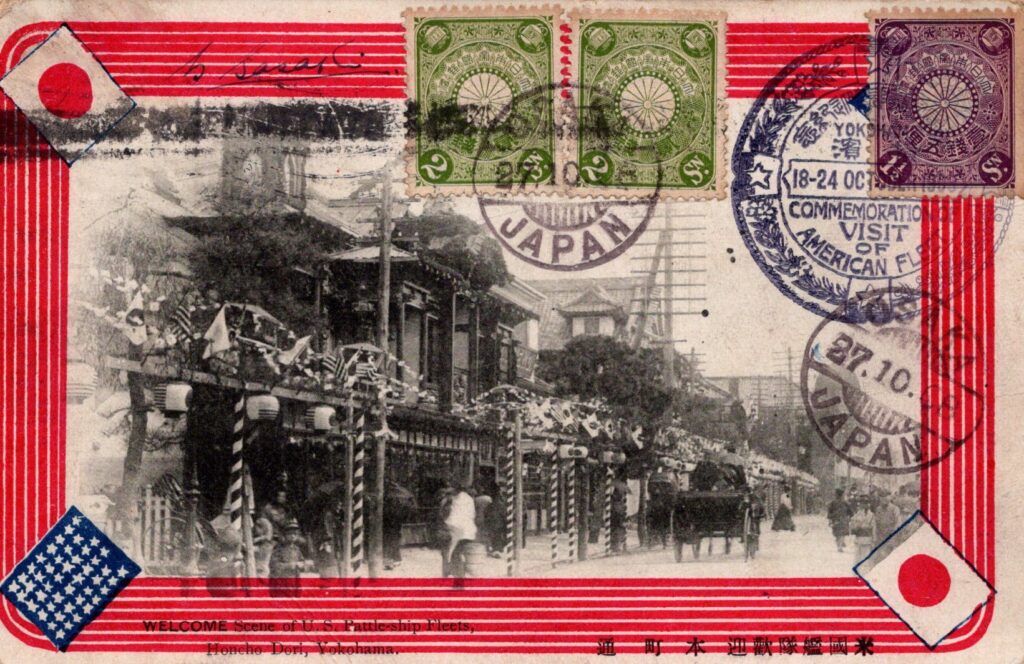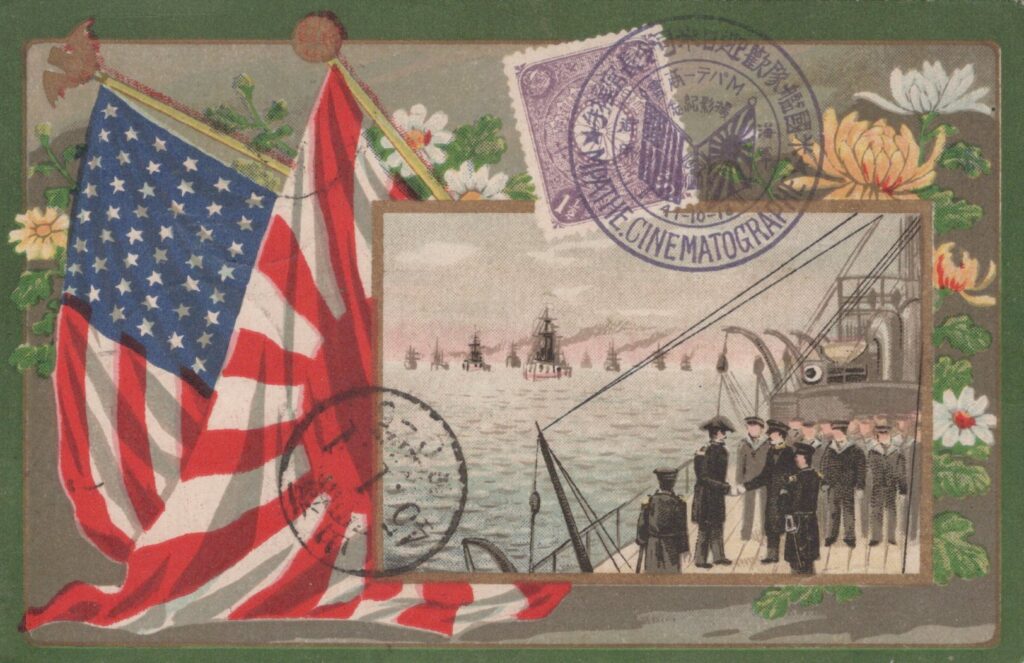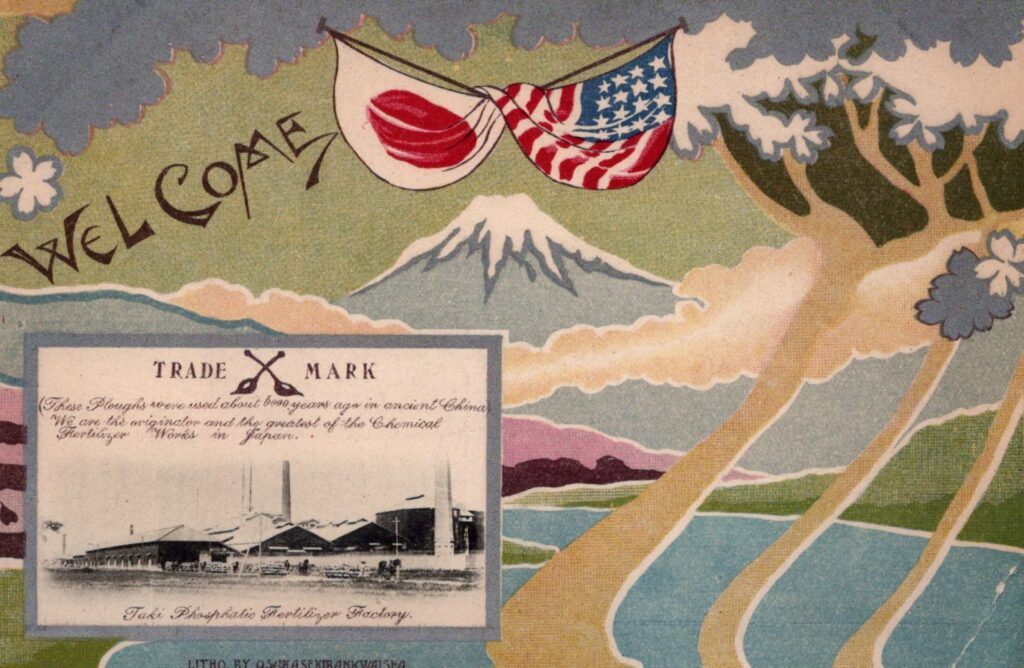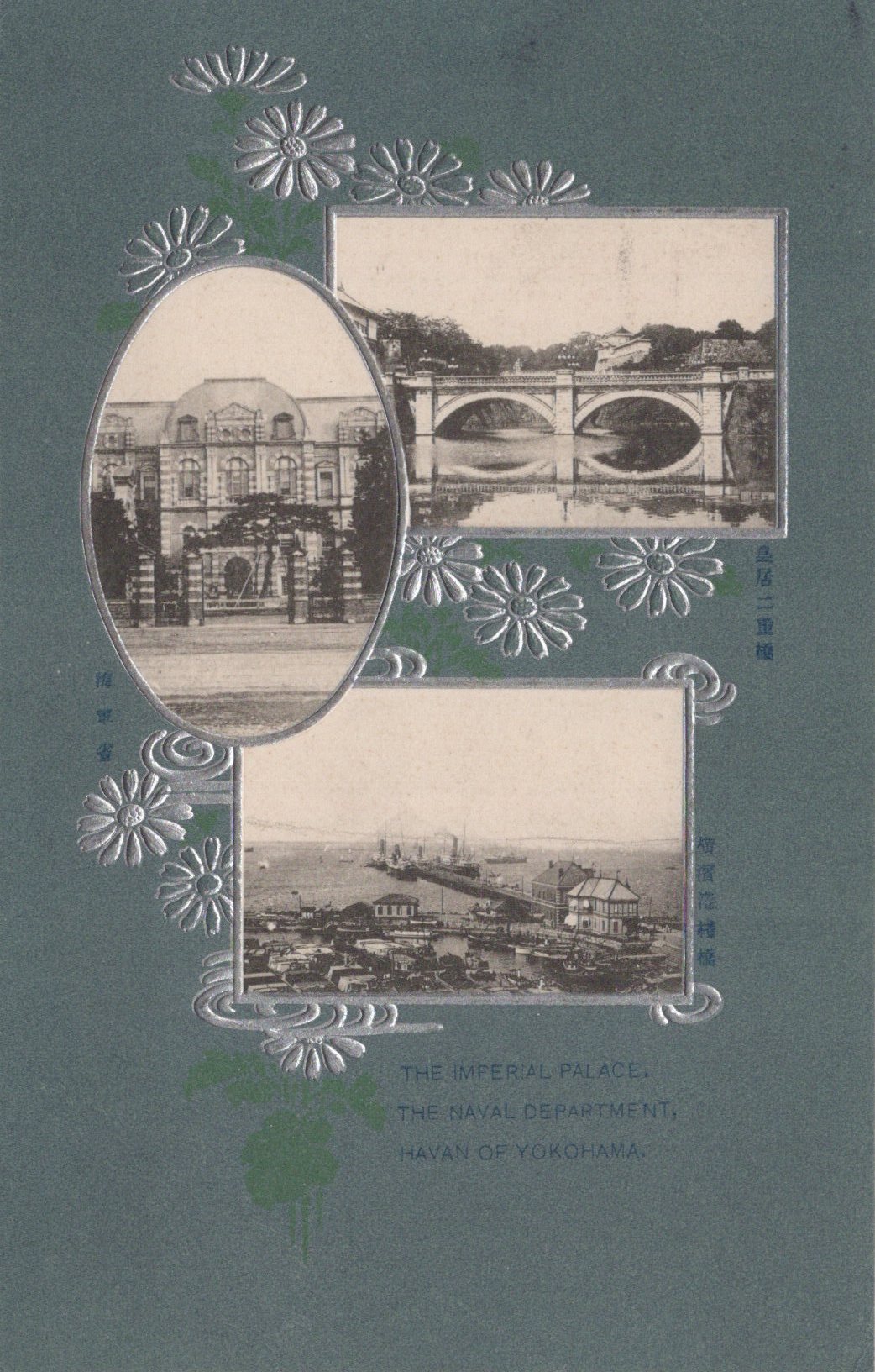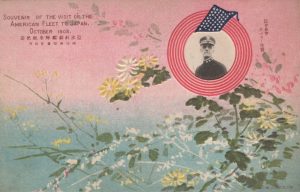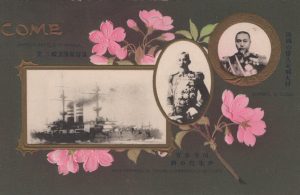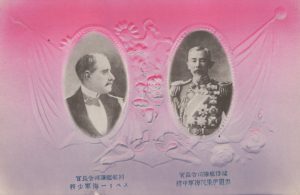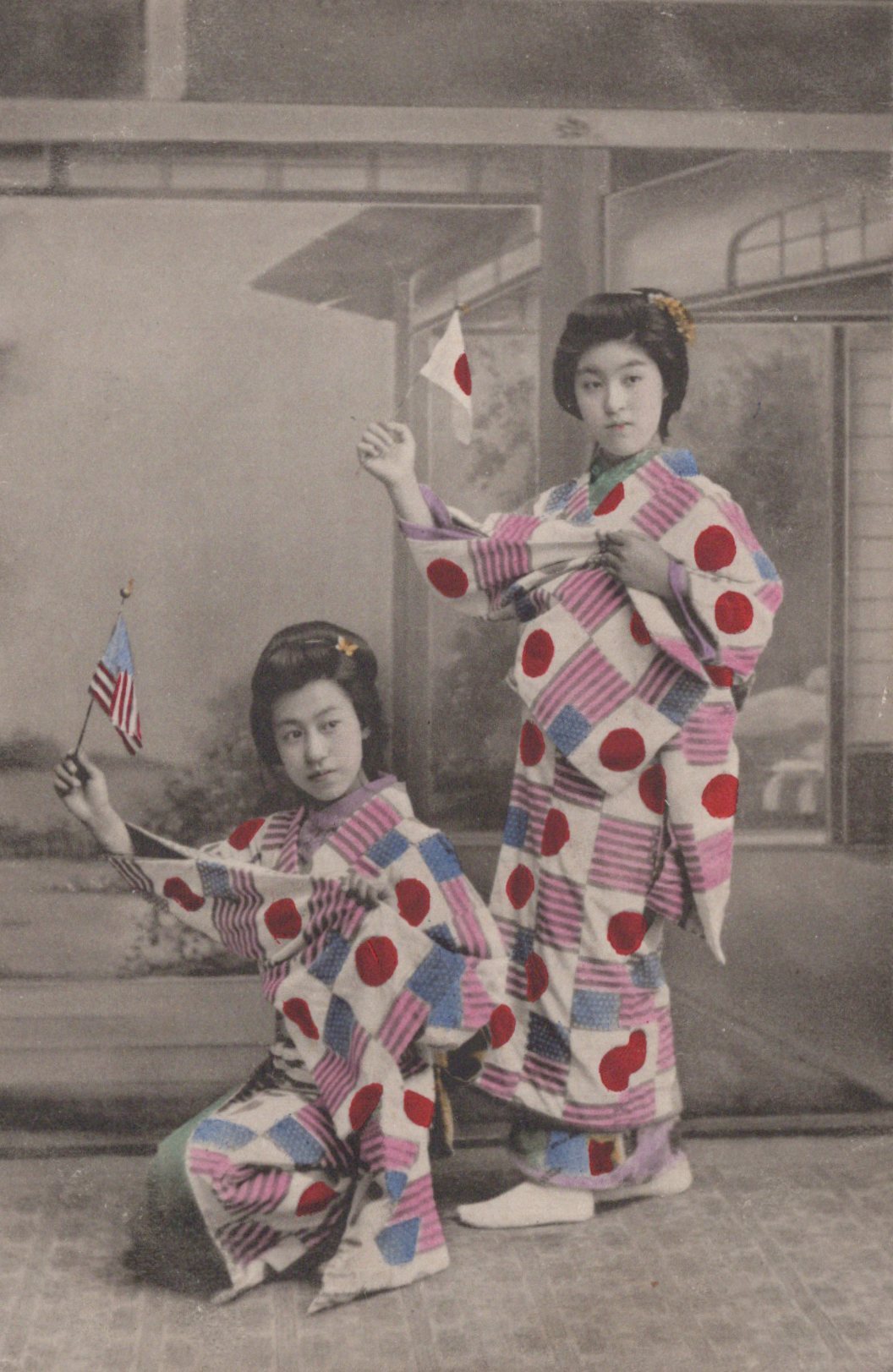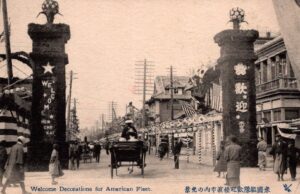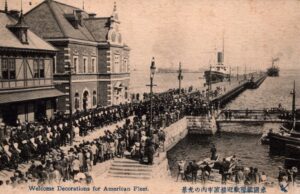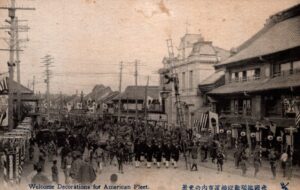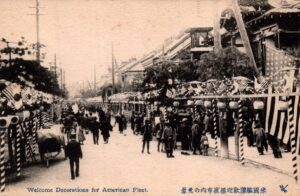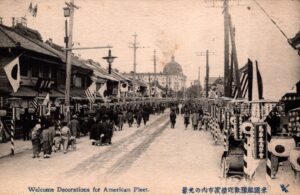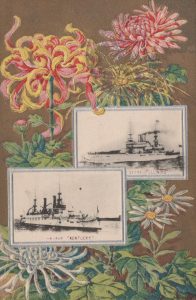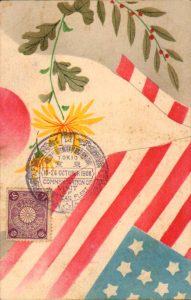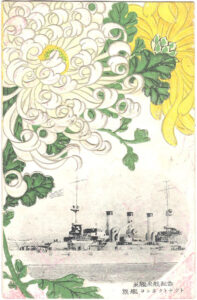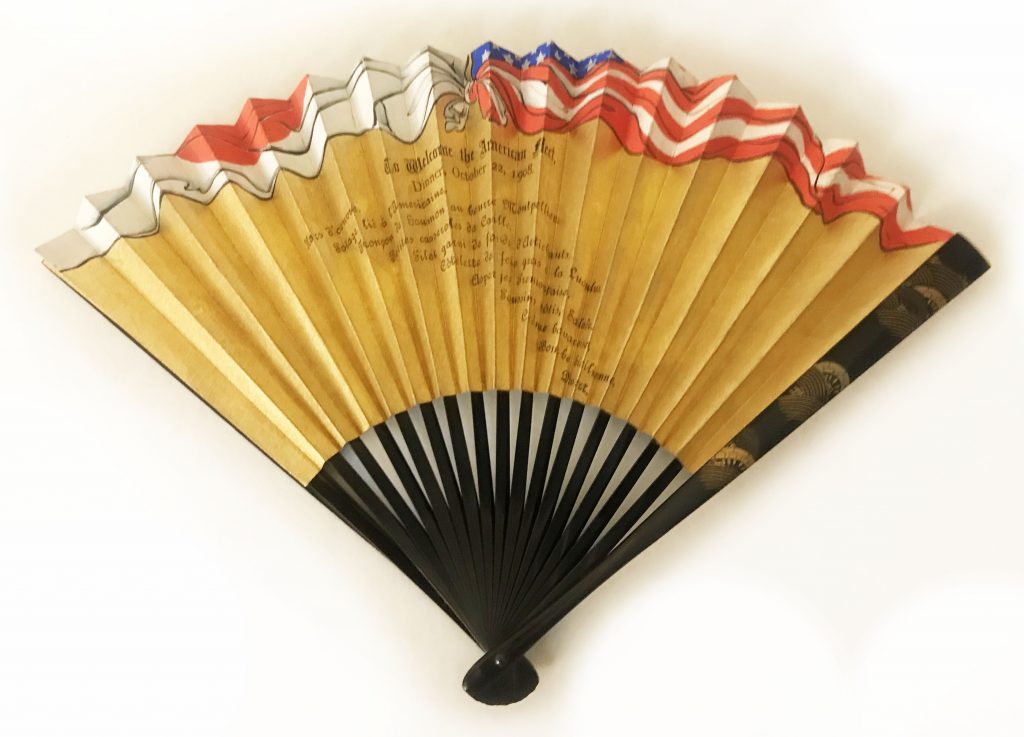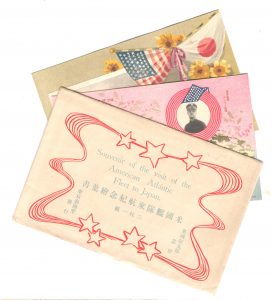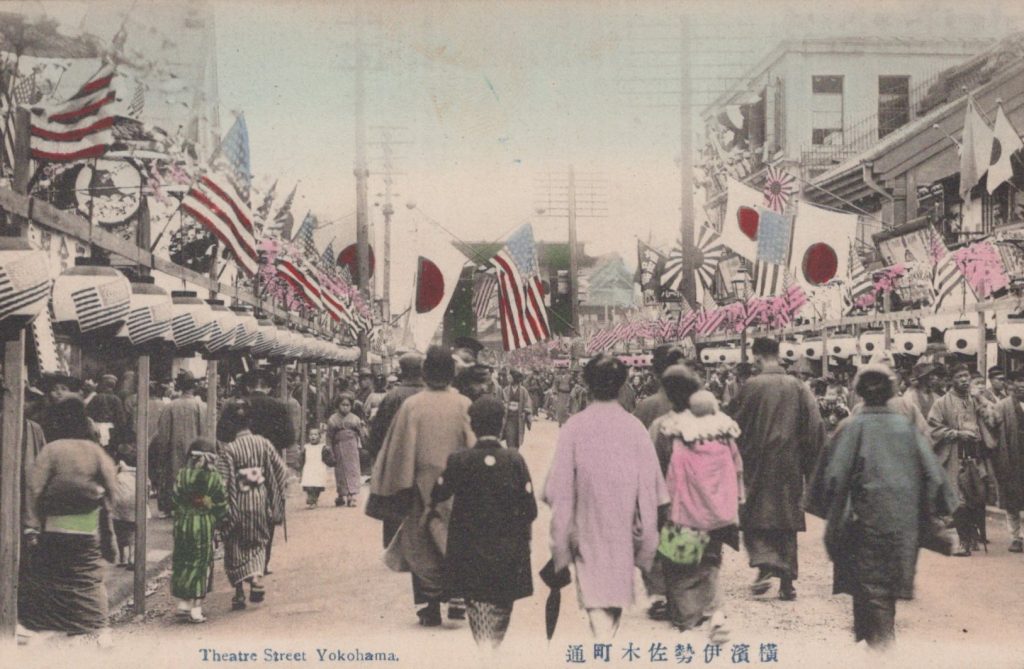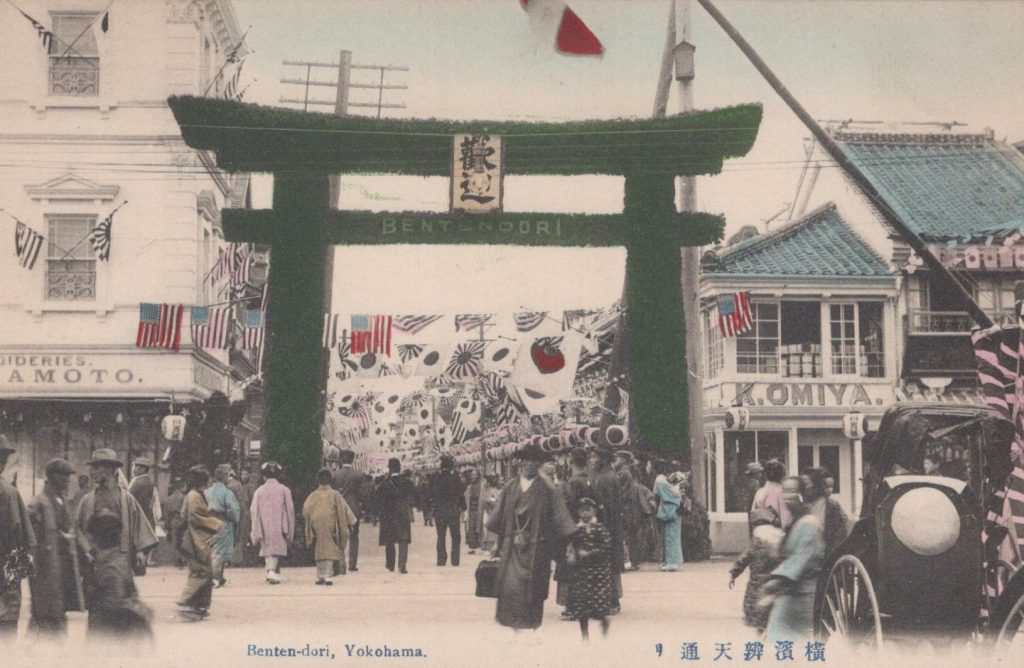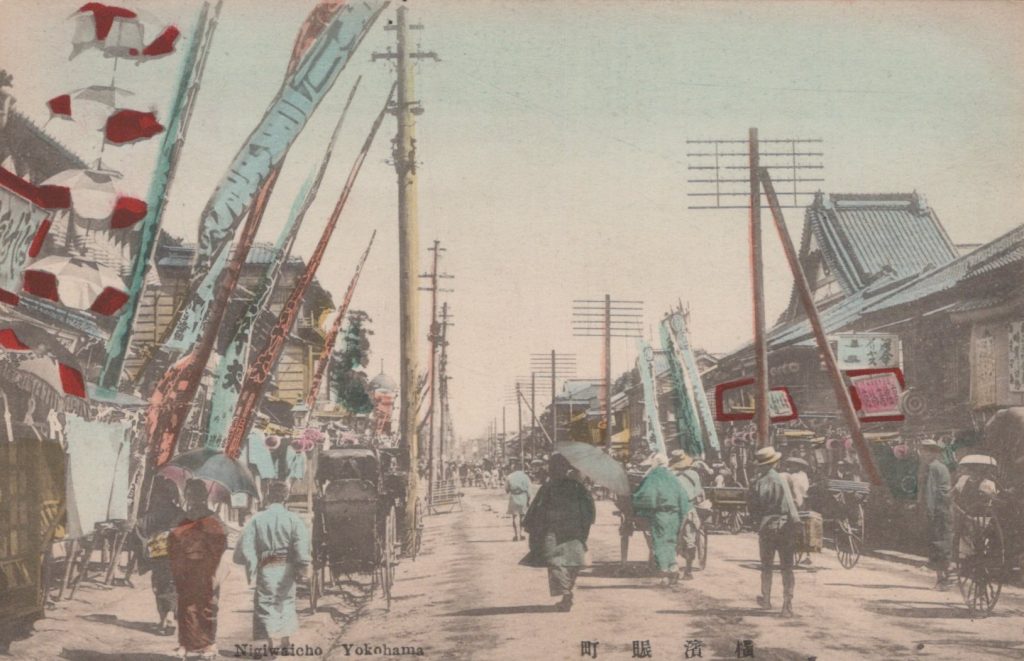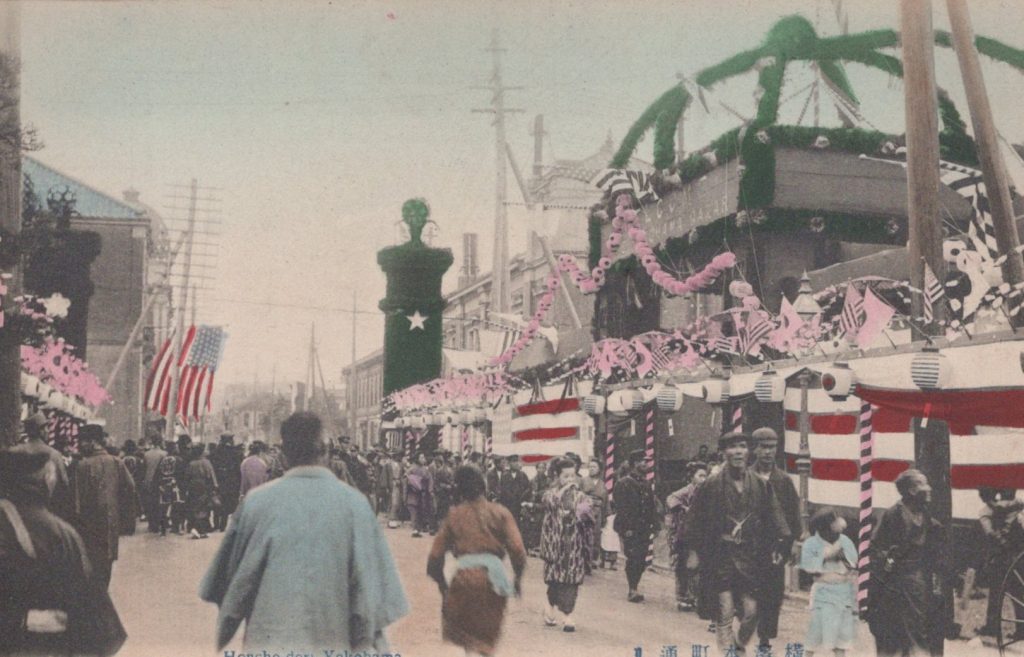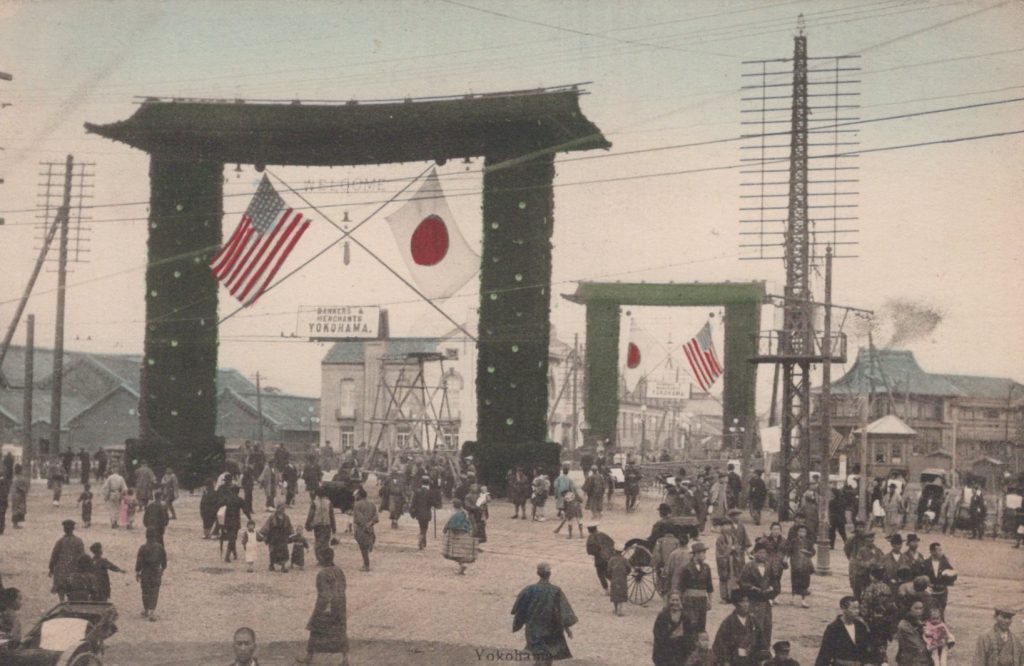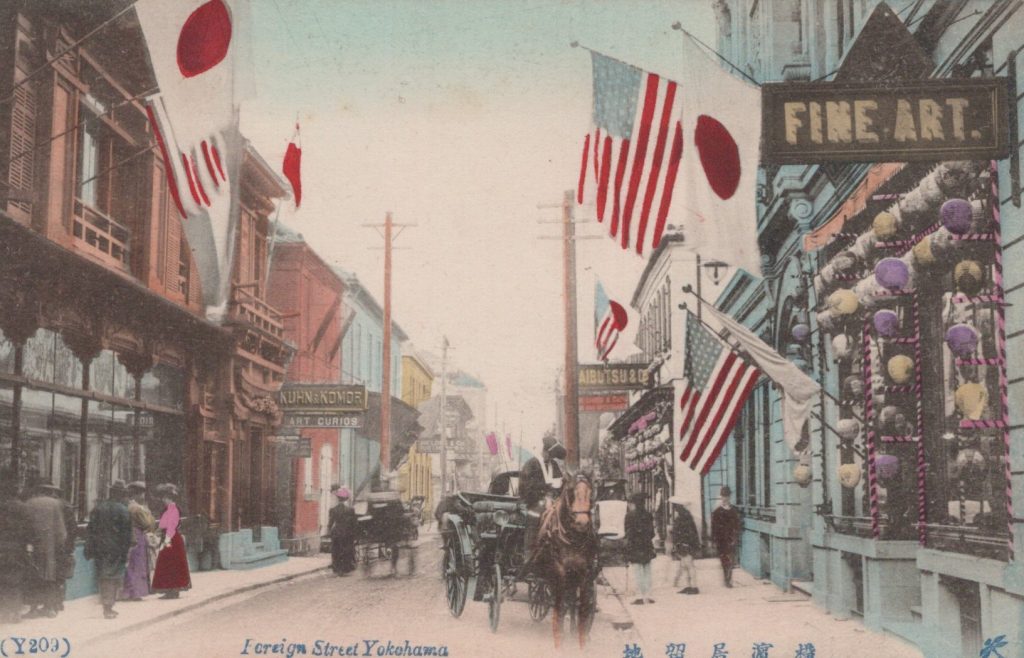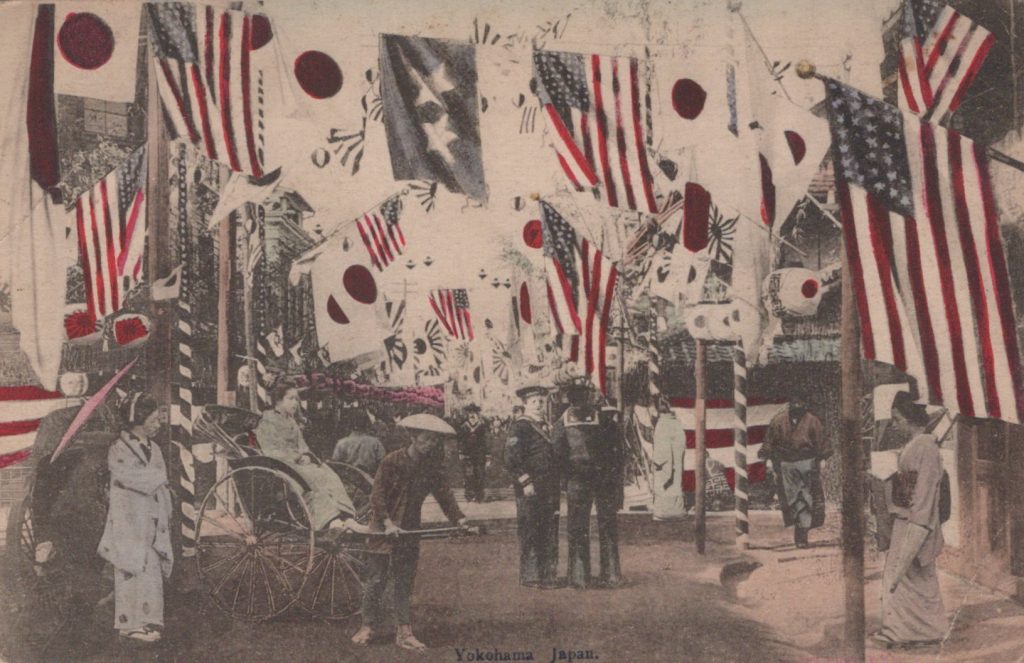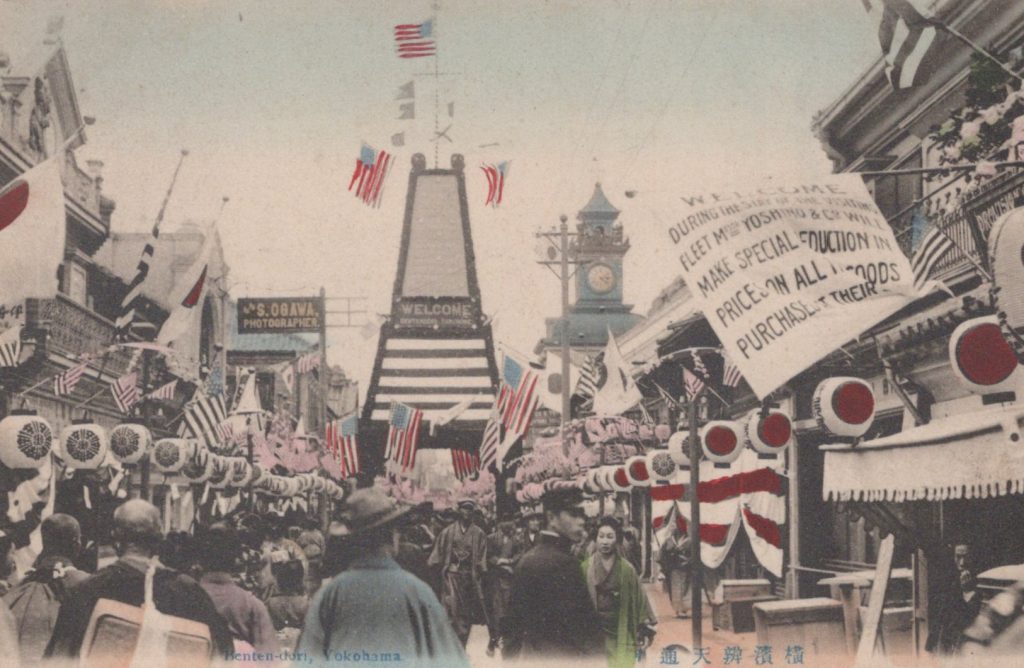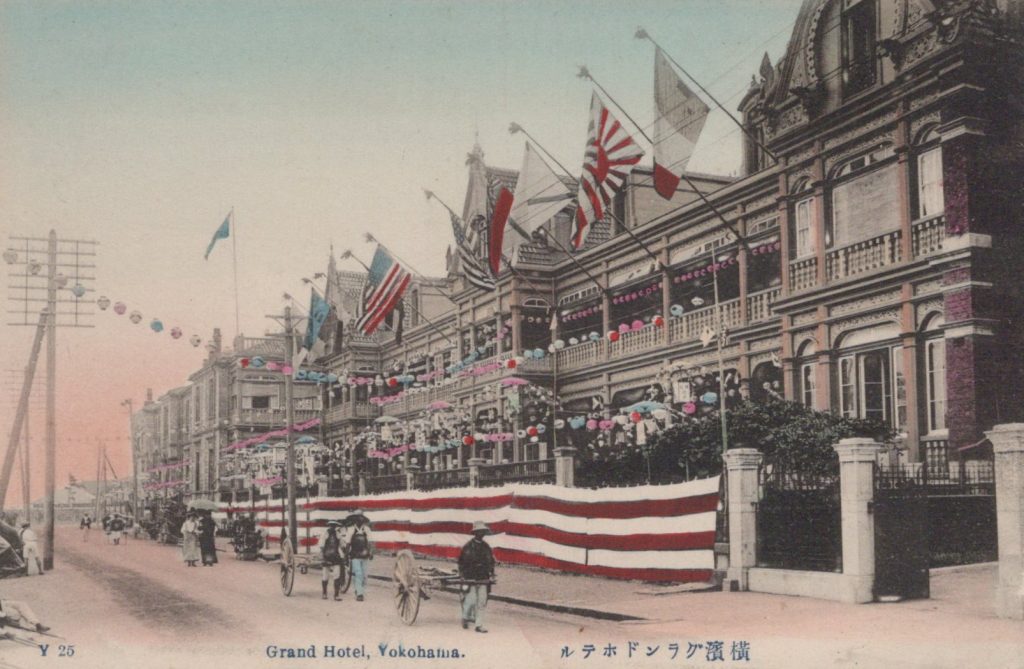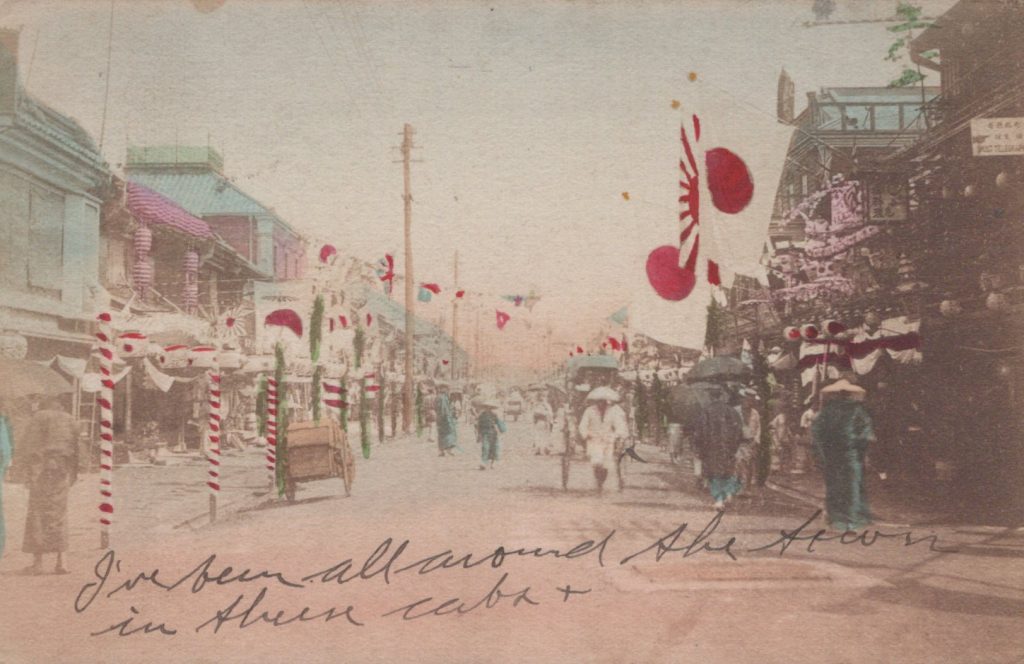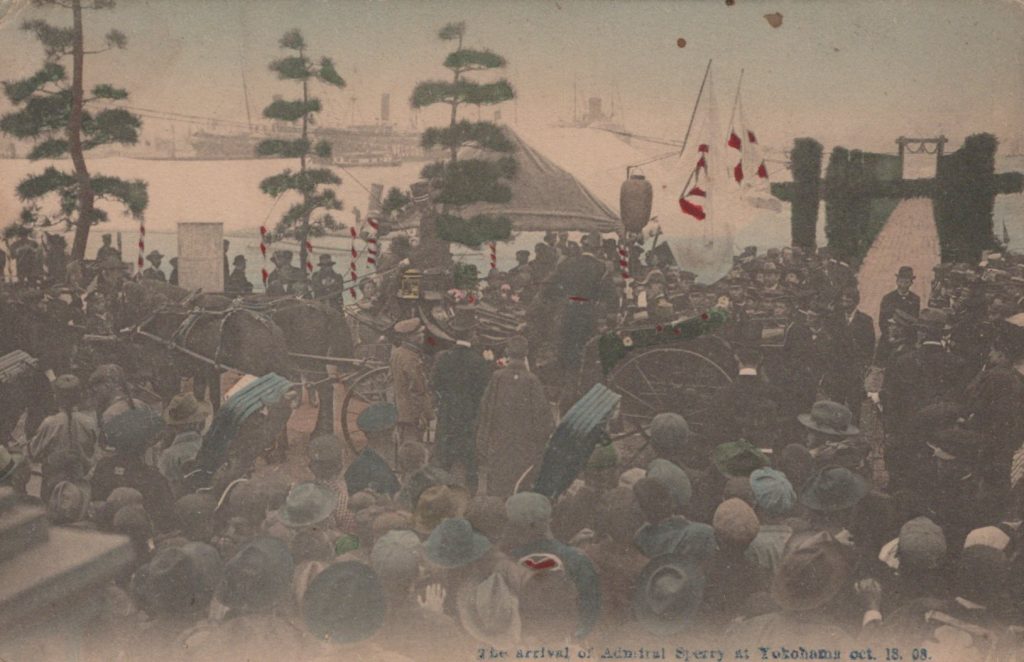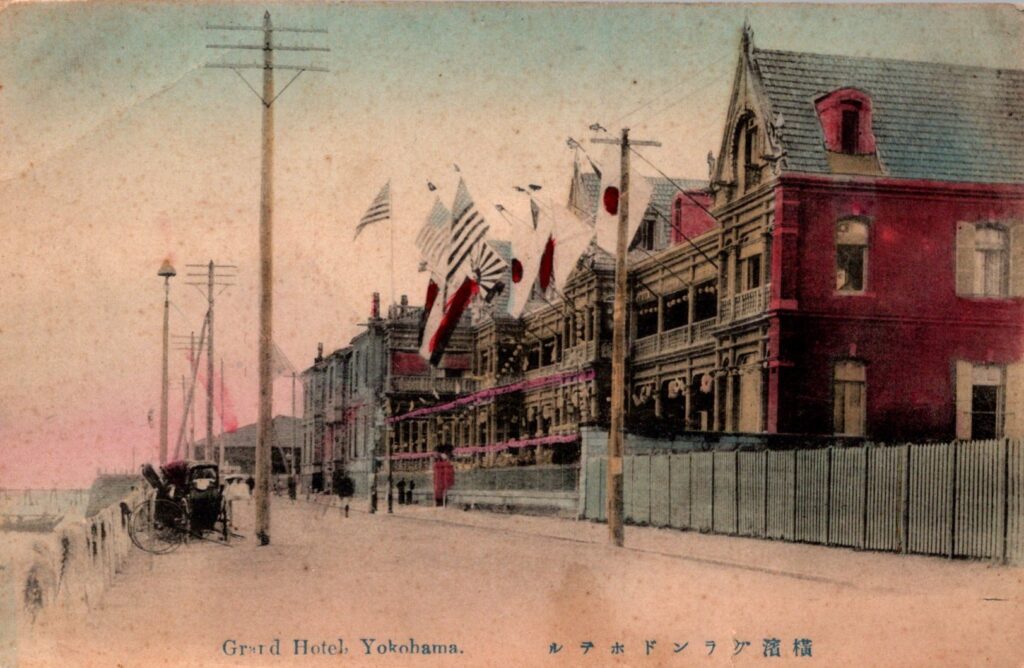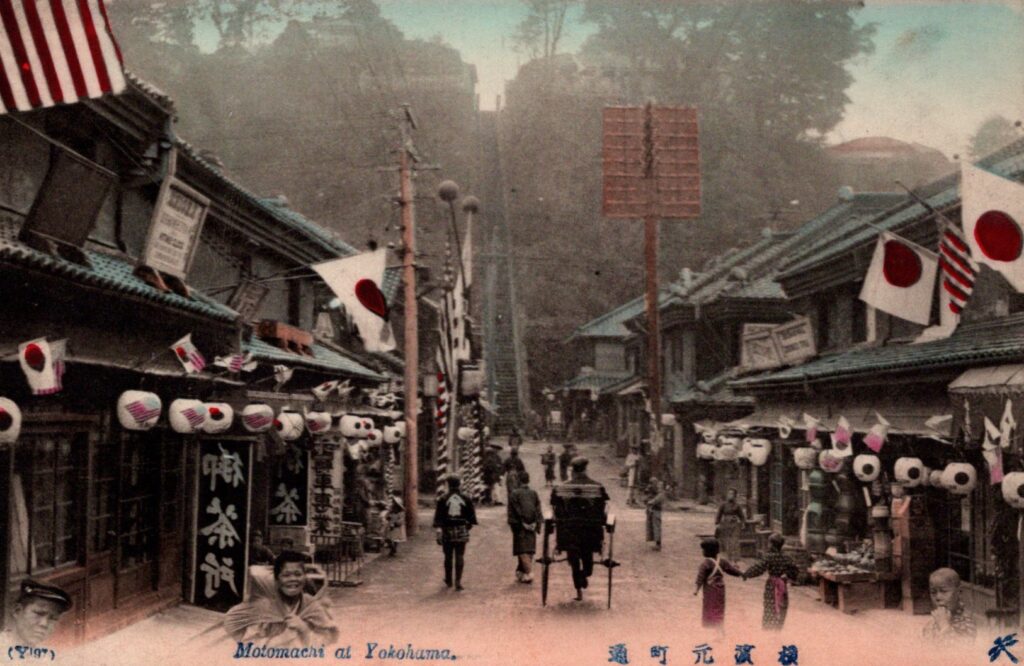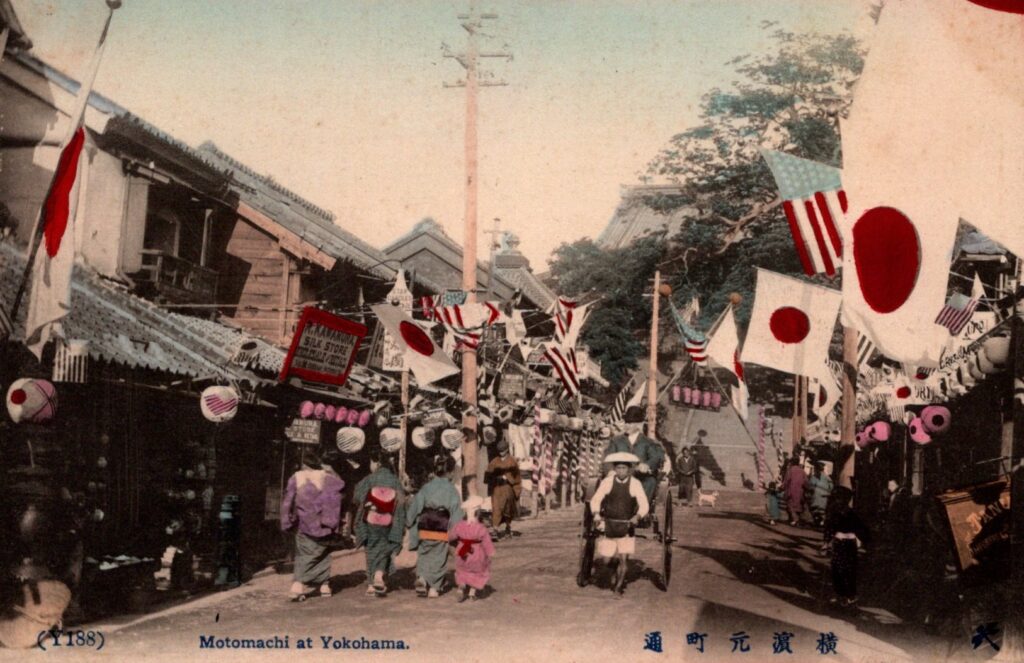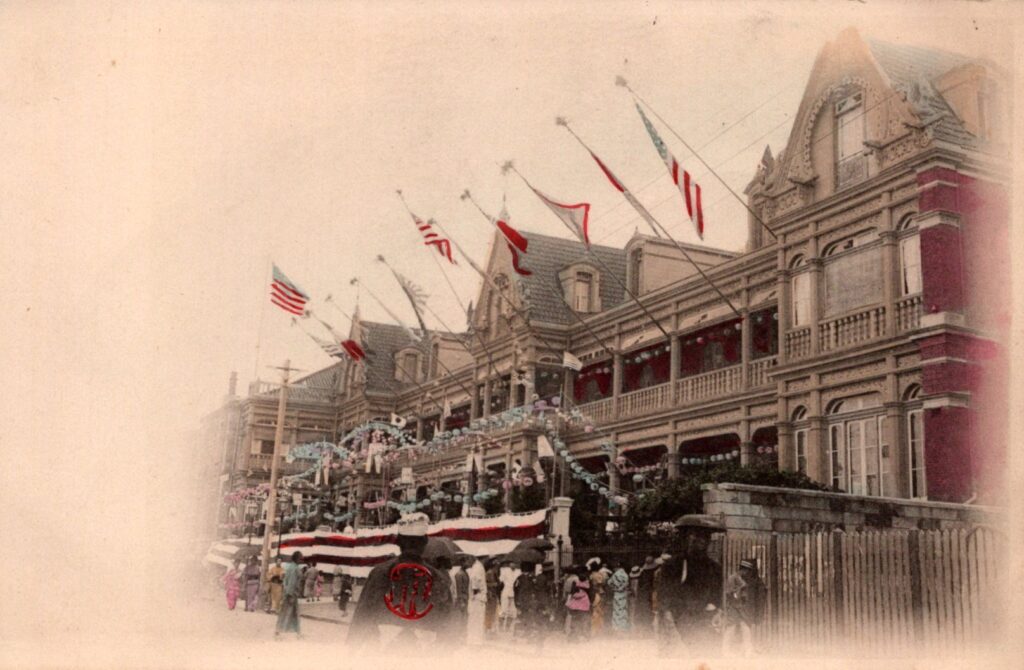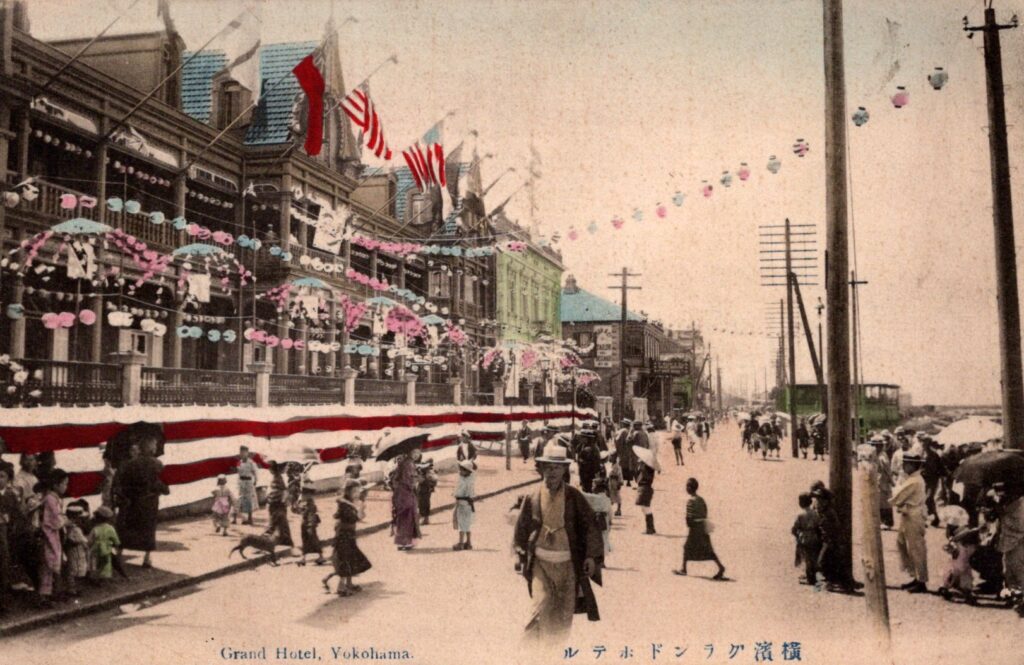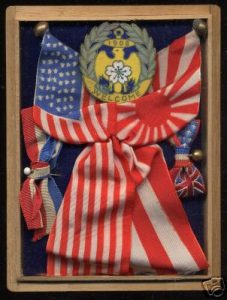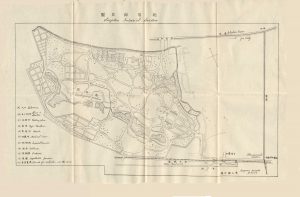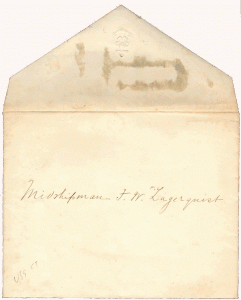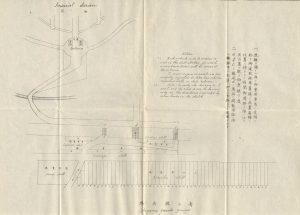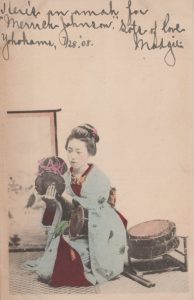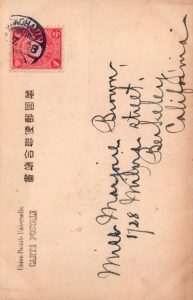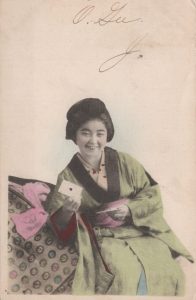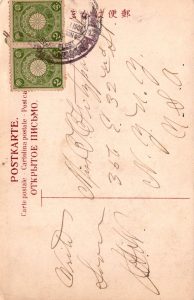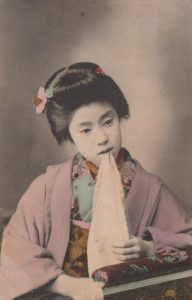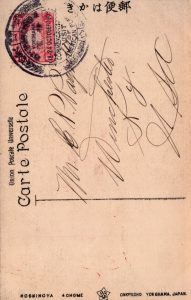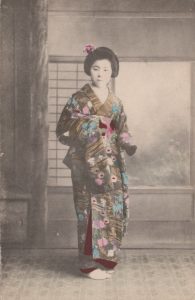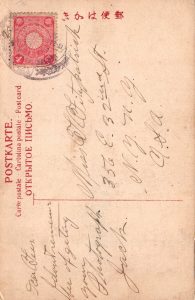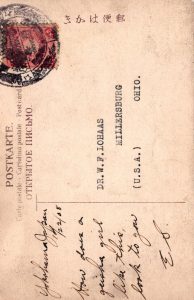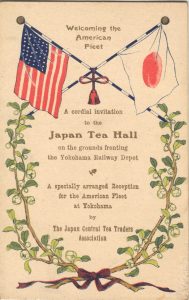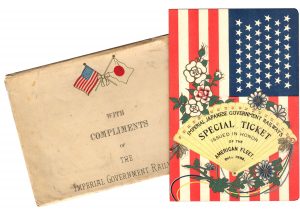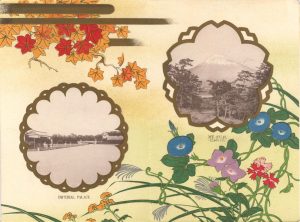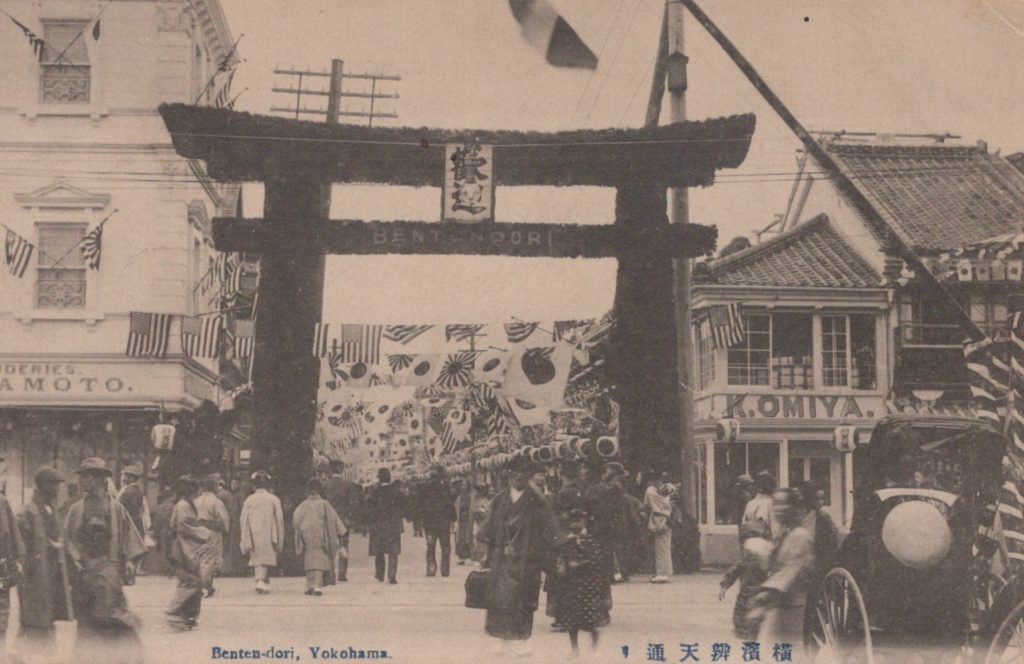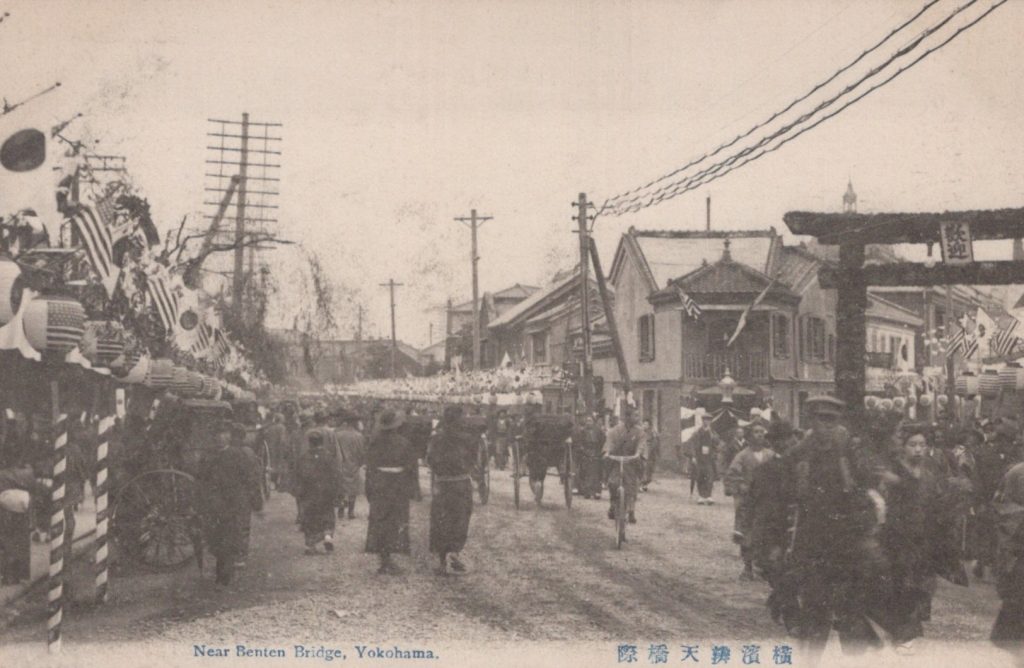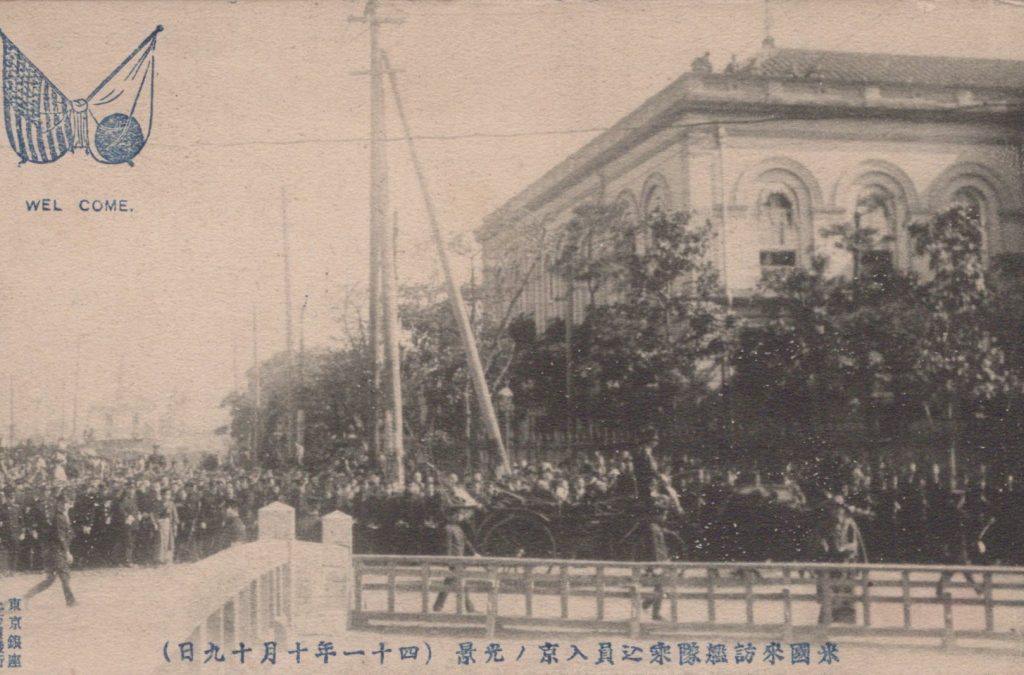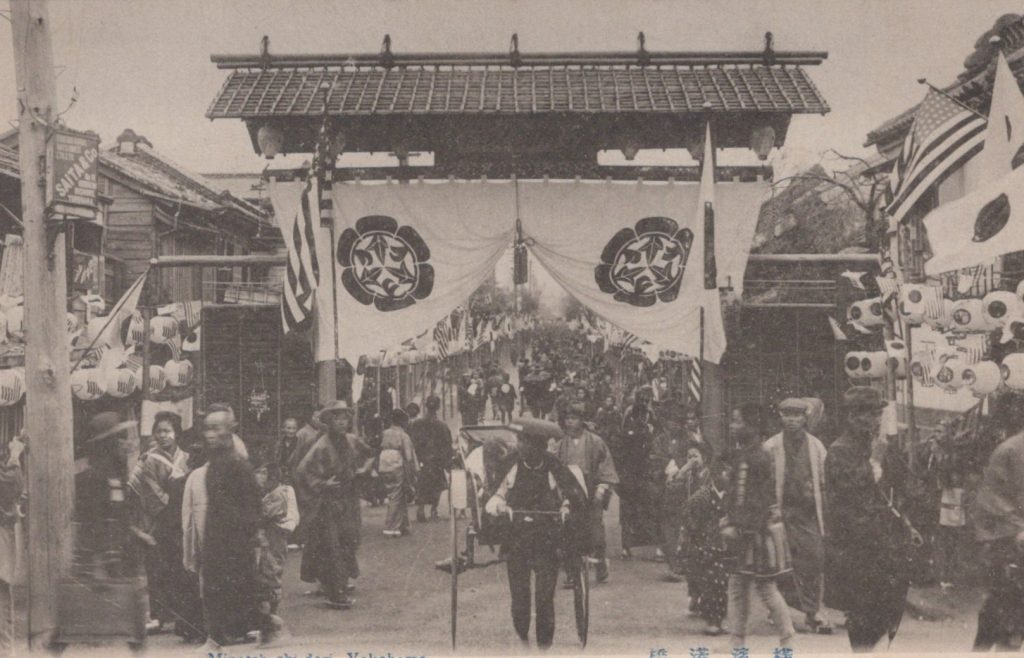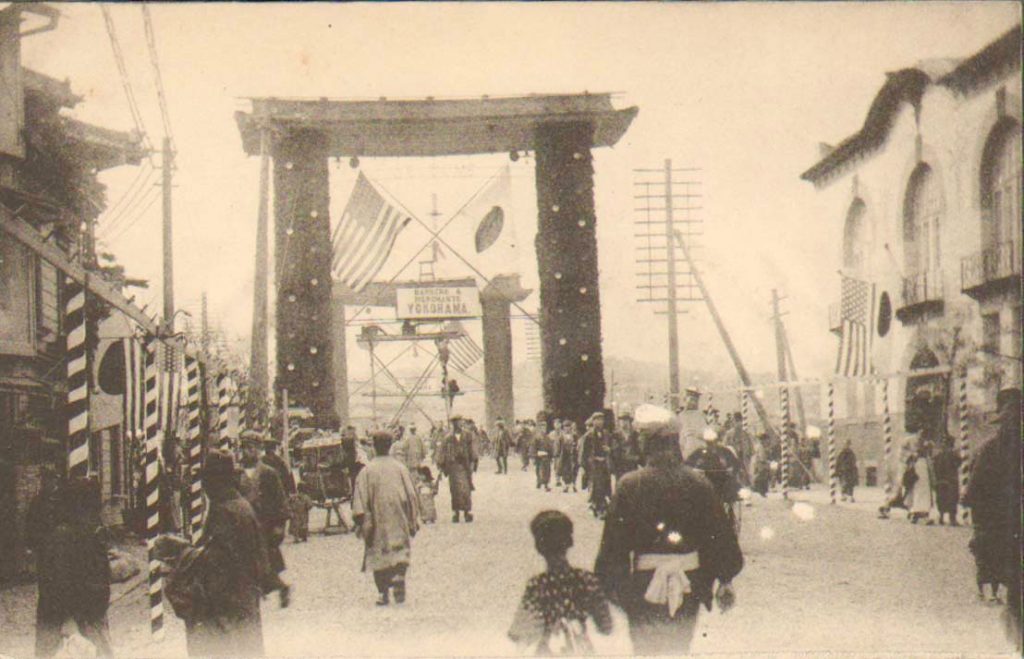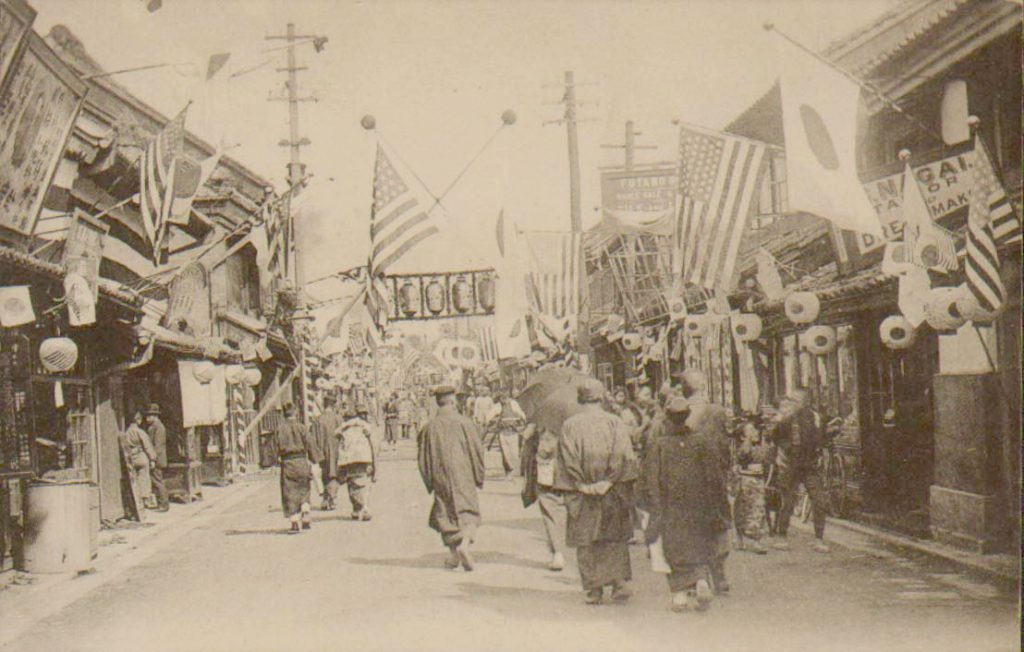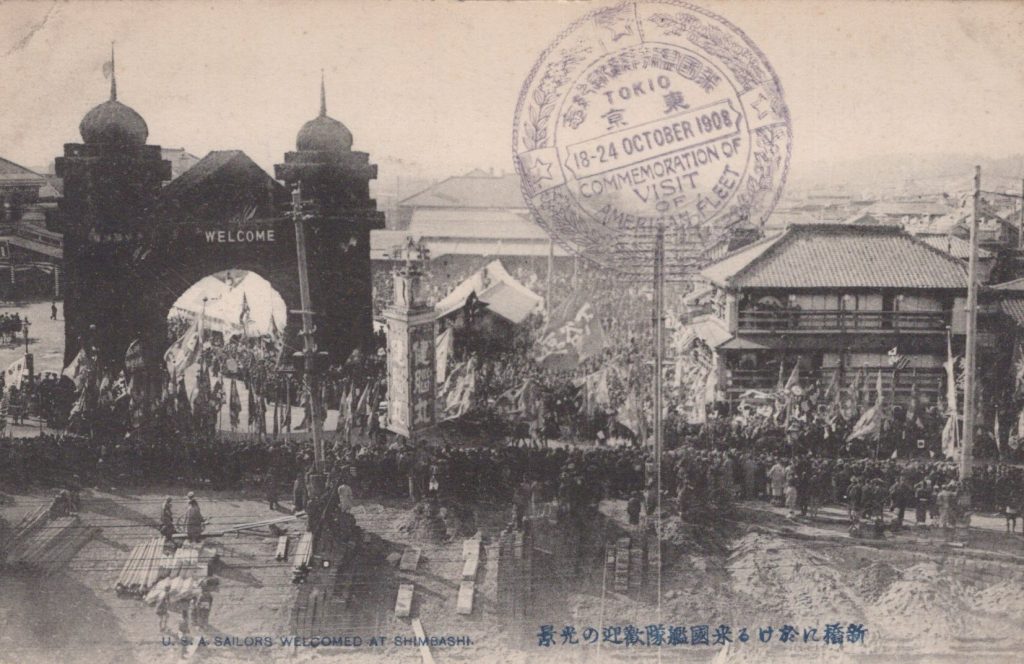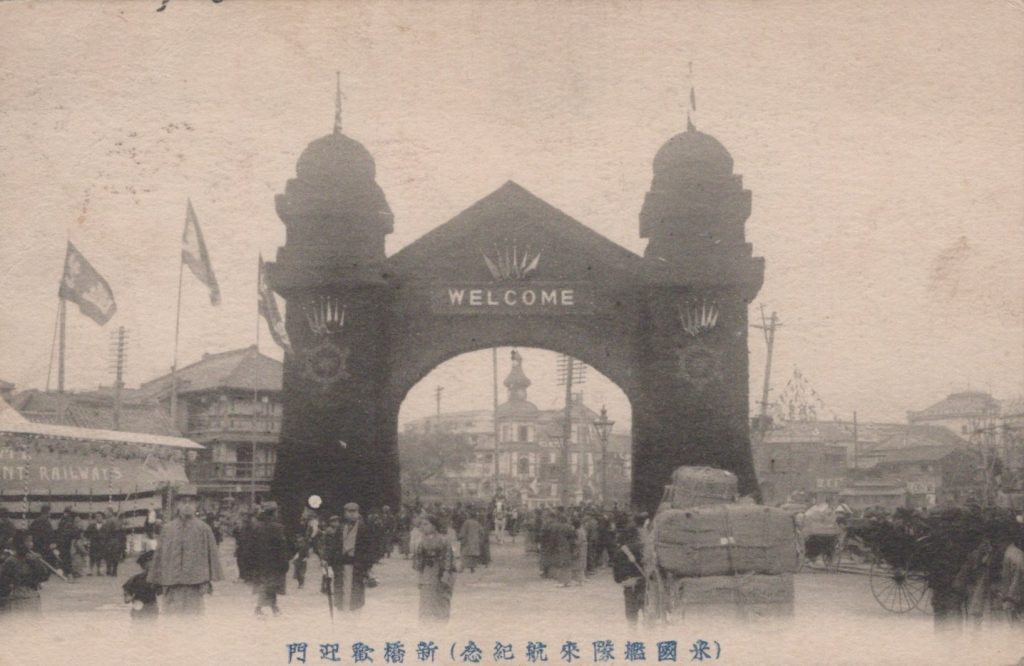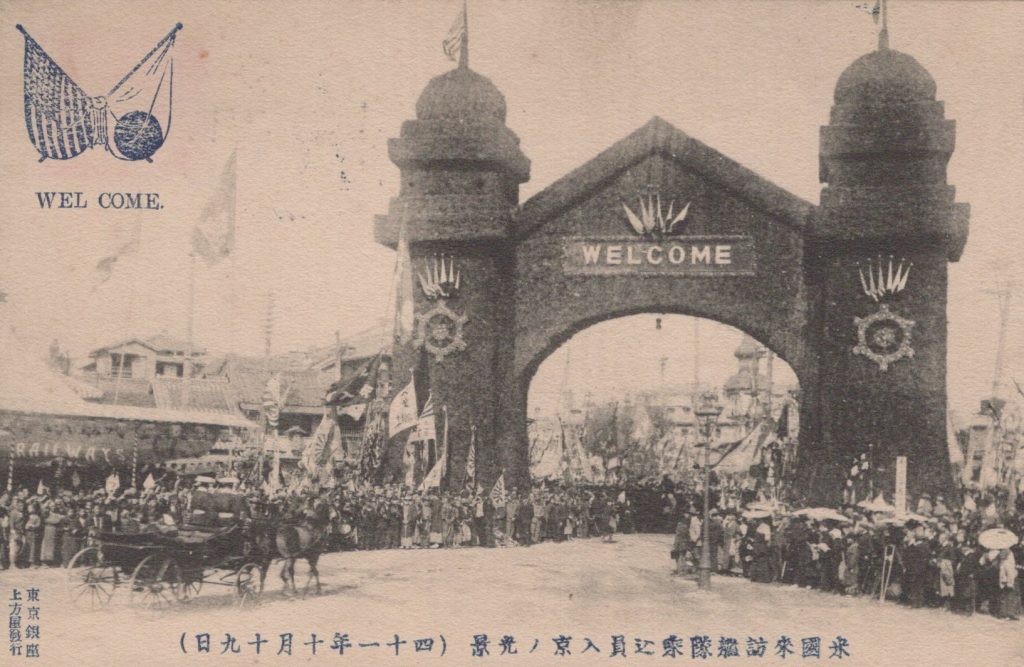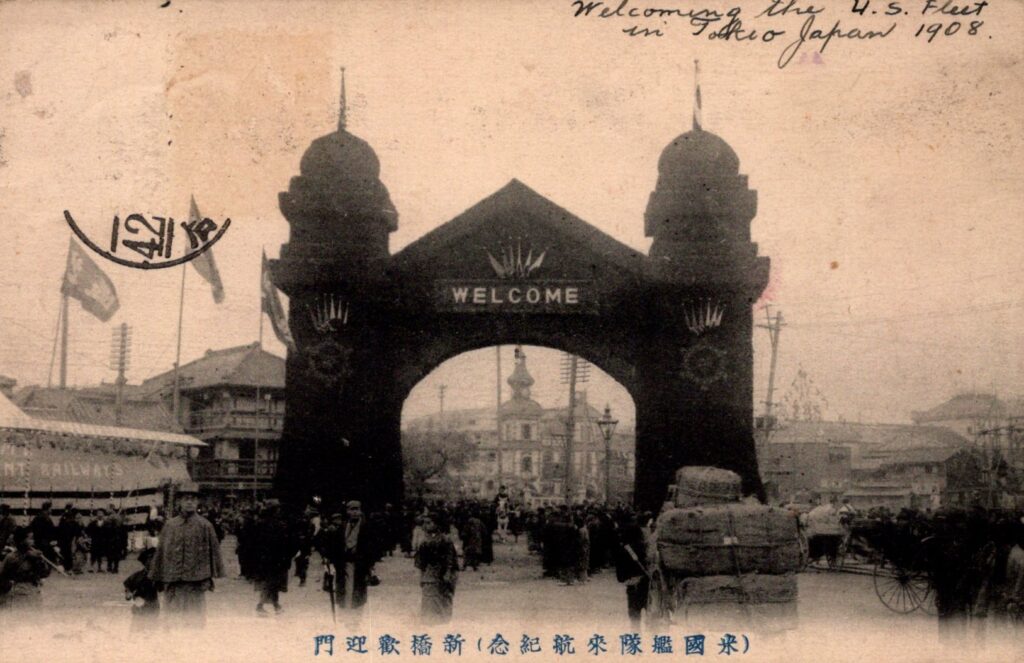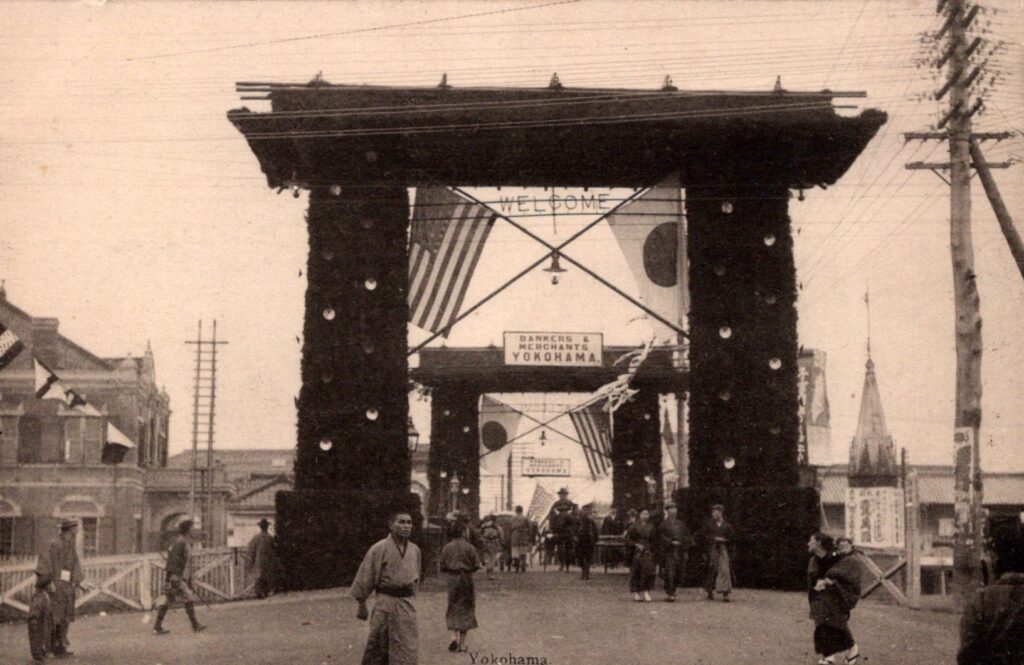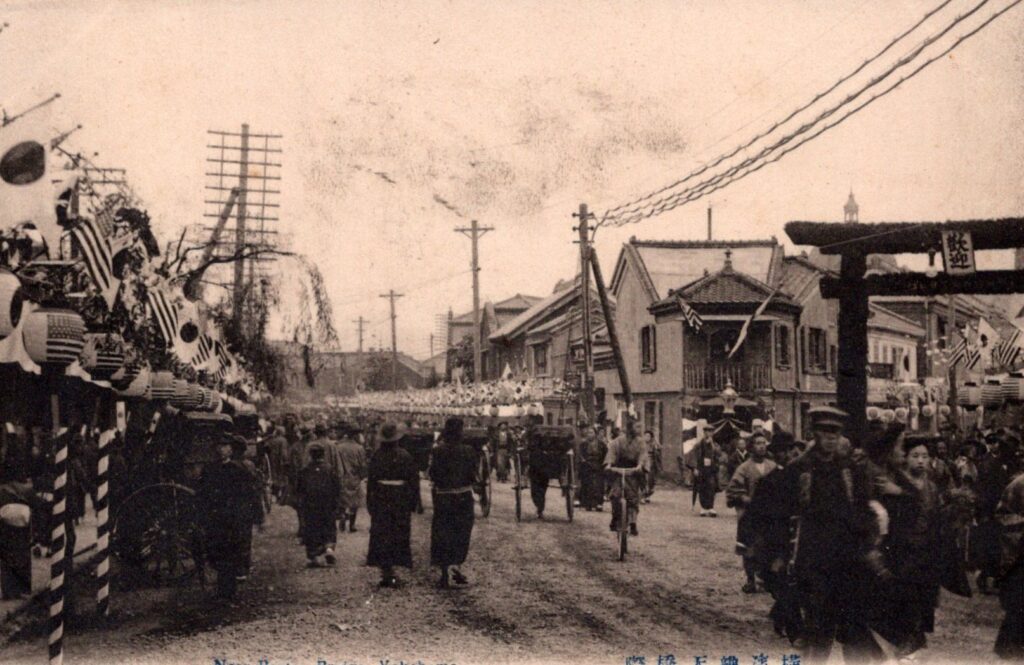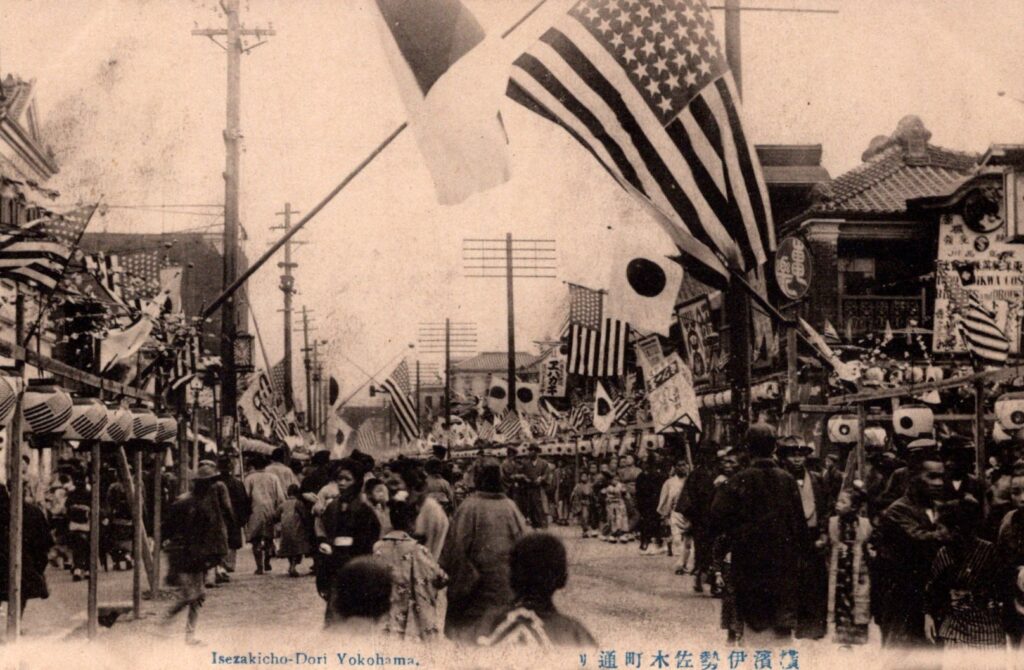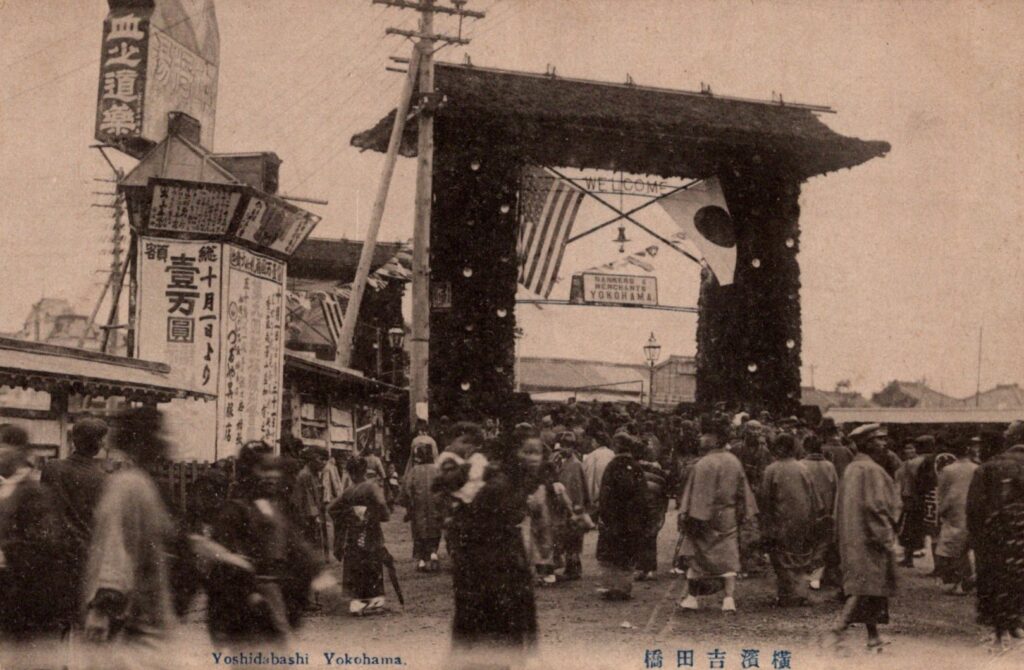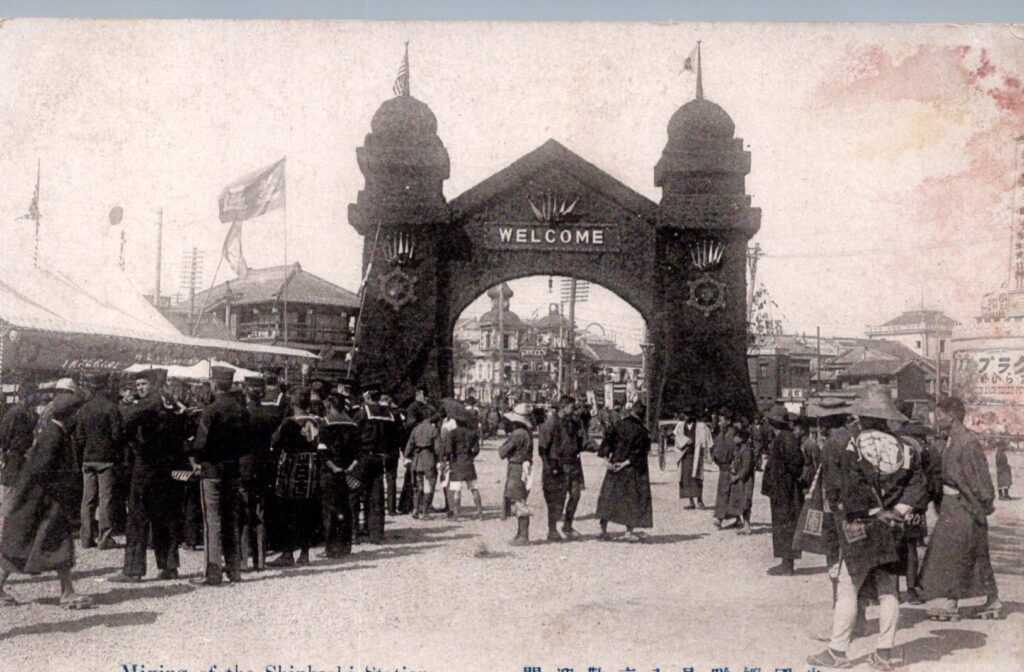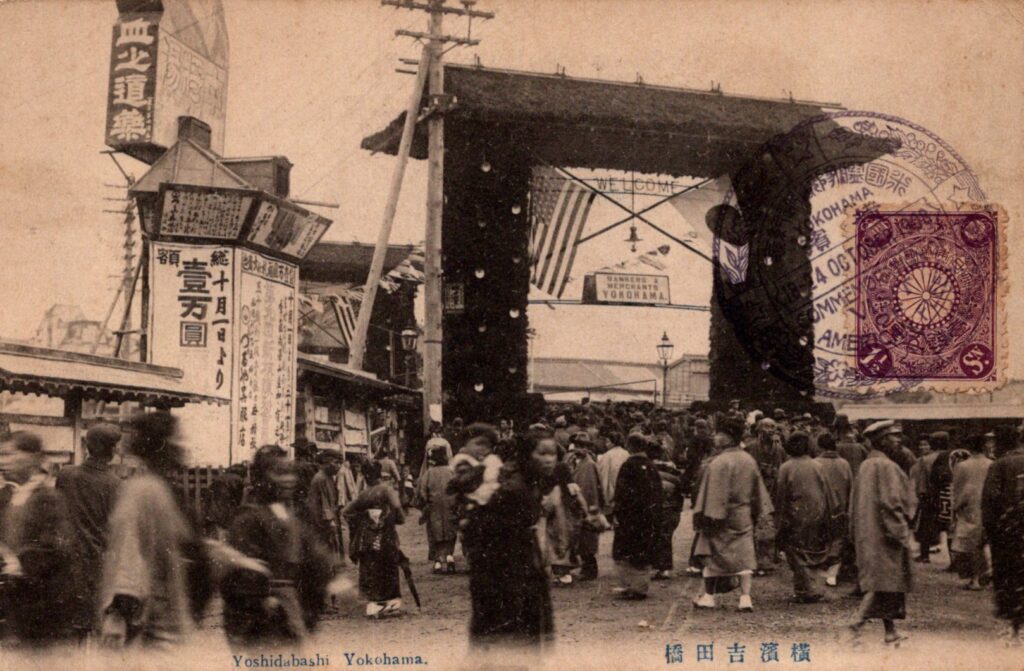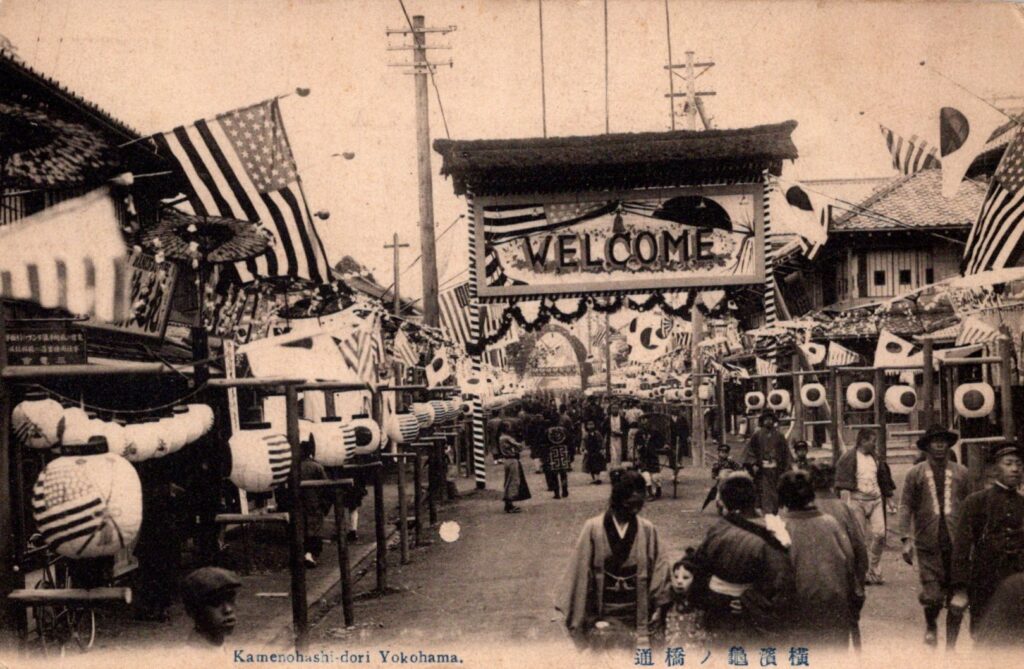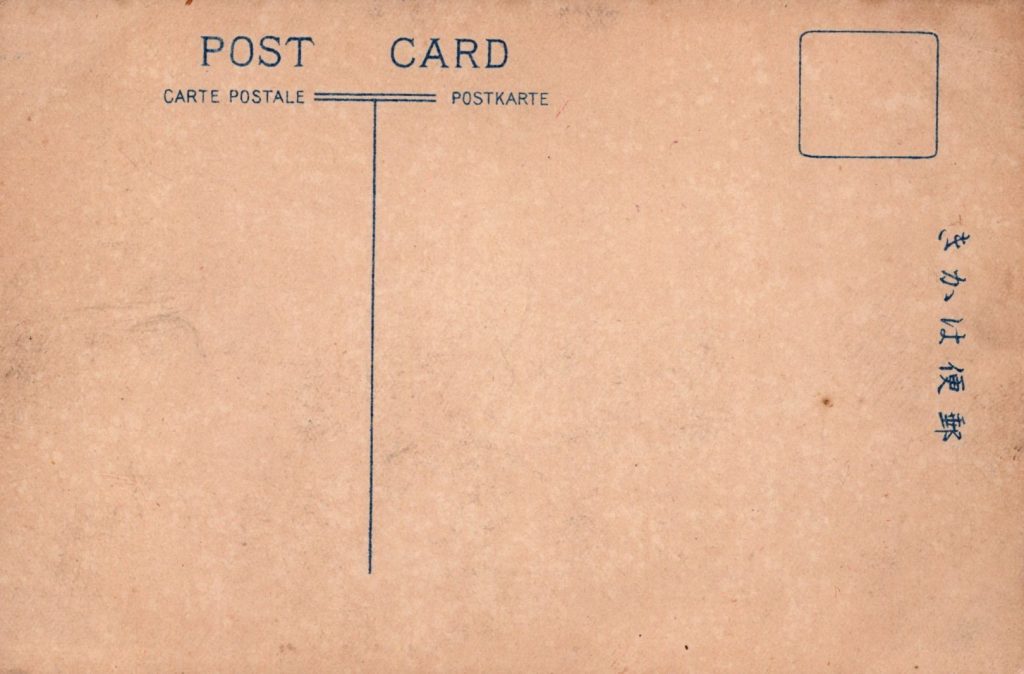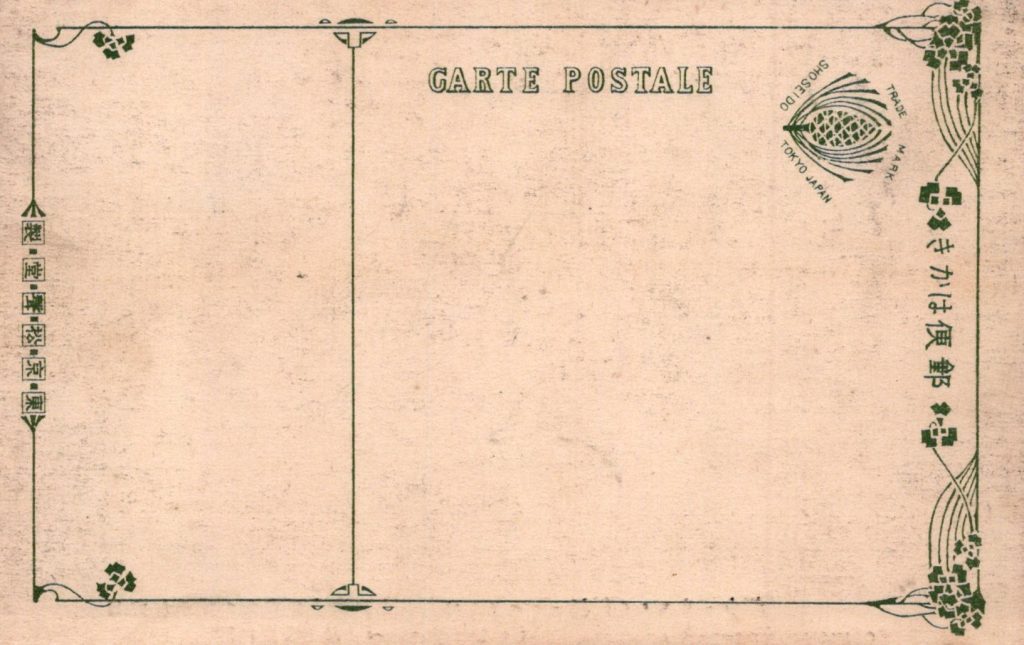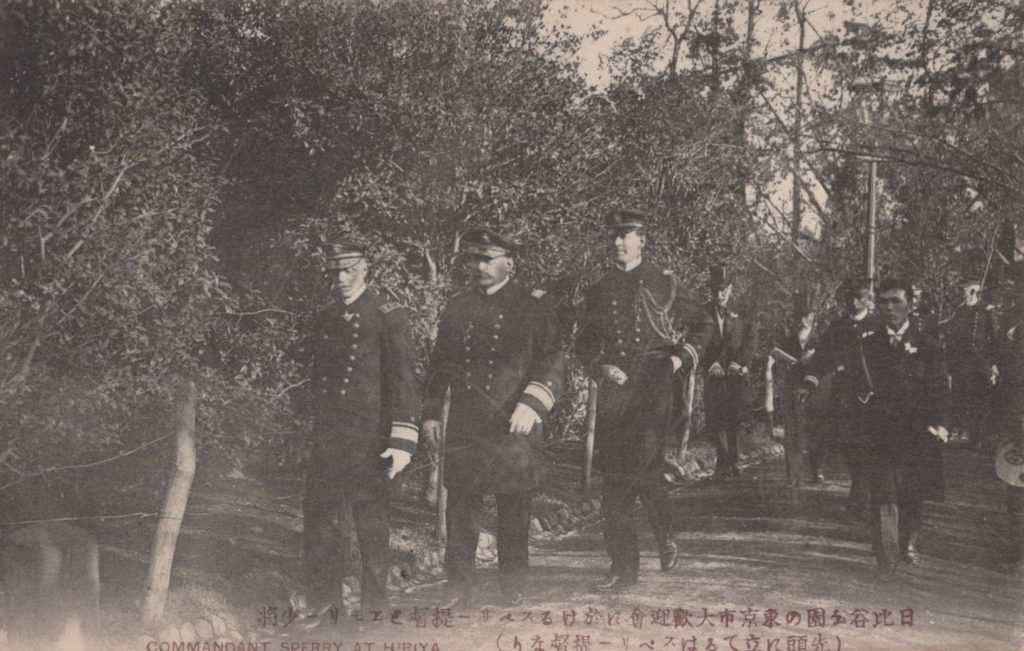Apologies, but no results were found for the requested archive. Perhaps searching will help find a related post.
The journey from Manila was marred by one of the worst typhoons in 40 years. Seas as high as 60 feet battered the fleet until they were forced to slow to 6-knots and ride out the storm. Battling the storm 4 sailors went overboard, one was left, un-recovered, Gunners mate William Fuller on the USS Rhode Island was swept overboard from the foredeck. Captain Murdock determined the seas to rough to launch a lifeboat stating, "I would rather lose one man than six or eight." It was not clear what Fuller's last words were as he was nearest the ship, some thought they heard him holler "So long fellas."
The Pacific and South China Sea
in memory of our famous cruise around the world
Long sought-after and treasured by sailors from around the world are the silk embroidery tapestries made by the artists of Japan. The grandest souvenir that any sailor could have brought home is the commemorative silk specially designed for the 1908 Cruise Around the World.
The silk depicts President Roosevelt in the center with Admirals Sperry and Evans to either side. The painting is completed within a gold embroidered frame showing the sixteen battleships coming into Tokyo Bay with Mount Fuji in the background. In the life preserver below is a space for the sailor who selected the silk. In the tapestry at right, this one belonged to Otto Sinclair, a musician onboard the USS Virginia.
japan welcomes the american fleet
As the fleet entered the mouth of Tokyo Bay they were greeted by six steamships crowded with the Japanese people waving Japanese and American flags and cheering wildly. On the side of each vessel painted in black, in letters as big as a house were the words, "WELCOME." The Japanese people loved postcards more than the Australians or Americans. They had, since the early beginning of postal stationary used it for every occasion. During the war with Russia, hundreds of patriotic postcards and been produced by the government and private publishers. For the American Fleet of 1908 there would be no exception. Every imaginable card was produced and ready upon the fleet's arrival. These three cards issued by Japanese publishers show to extent to witch they were extending a greeting to the American Fleet. At left, Admiral Sperry with the Battleship Connecticut; center President Roosevelt and Emperor Meiji, and at right again Admiral Sperry and the Connecticut.
From the first moment the fleet met the Japanese people to the time of departing, it was clear that Japan desired to show the American's genuine friendship. By the end of the visit no one believed they had received anything but the most sincere welcome from the Japanese people.
The Japanese people loved postcards more than the Australians or Americans. They had, since the early beginning of postal stationary used it for every occasion. During the war with Russia, hundreds of patriotic postcards and been produced by the government and private publishers. For the American Fleet of 1908 there would be no exception. Every imaginable card was produced and ready upon the fleet's arrival. The above three cards came as a set and were given out free to Sailor of the Fleet.
for welcome the advent of the american fleet
These cards were issued for the Fleet's visit showing key officers of the American and Japanese Navy. At left is Admiral Sperry with the USS Connecticut. The card in the center shows Admiral Wainwright, Second Division, Third Division Admiral Emory, and Fourth Division Admiral Schroeder, with the fleet below. The third card is Admiral Togo with the Battleship Mikasa.
the might of the japanese navy
The fleet was met south of the entry to Yokohama by three Japanese cruisers. As they approached the entrance three more vessels painted black with with letters announcing "Welcome" joined the precession into port. They arrived at the pre-planned anchorages opposite the 16 ships of the Imperial Fleet. Each ship cheering as their American counterpart passed. The below "ship formation" card show the fleet anchorage in Yokohama. The card shows the Japanese warship that is anchored across from the American warship, equal in armor and weapons. Japan understood the American presence in the South Pacific. Peaceful, but a display of force. Japan was equal to the gesture of peace and strength. They wished to politely remind American that they had a navy also, and, a navy successful in battle. Just three years prior they had met the Russian Fleet at sea and destroyed or captured 28 out of 32 ships in less than 24-hours.
| American | Japanese |
|---|---|
| USS Connecticut | HIJMS Mikasa |
| USS Kansas | HIJMS Fuji |
| USS Minnesota | HIJMS Asahi |
| USS Vermont | HIJMS Sagami |
| USS Georgia | HIJMS Azuma |
| USS Nebraska | HIJMS Yakumo |
| USS New Jersey | HIJMS Nisshin |
| USS Rhode Island | HIJMS Kasuga |
| USS Louisiana | HIJMS Katori |
| USS Virginia | HIJMS Kashima |
| USS Missouri | HIJMS Tsukuba |
| USS Ohio | HIJMS Ikoma |
| USS Wisconsin | HIJMS Soya |
| USS Illinois | HIJMS Otowa |
| USS Kearsarge | HIJMS Nitaka |
| USS Kentucky | HIJMS Tsushima |
The below two cards were issued by the Department of Communications in commemoration of the Visit of the American Fleet. They were normally accompanied by a commemorative cachet from one of the tree post offices frequented between Yokohama and Tokyo.
The Japanese government worked hard to frame the visit on a "friendship based on trade" established by Commodore Perry. In 1853 after several unsuccessful attempts, Commodore Perry was able to force a trade relationship on Japan. Now Japan wished to acknowledge the industrial growth their country had experienced since the visit in 1853 and describe their future plans in Manchuria, Korean, and China in the same manner.
To help foster this perception, cards and souvenirs of the fleet's visit included images of Commodore Perry, his fleet, and recognition of the improvements made to Japan by trade with America.
Below is a real photo postcard produced during the fleet's visit showing people gathered at the Commodore Perry Monument in Kurihama with a commemorative cancel at the Kurihama Station, rare.
The card below shows the HIJMS Soya from it's visit to the American West Coast during 1909. She was
opposite the USS Wisconsin in Tokyo Bay was a prize of war. She was the Battleship Varyag previously of the Russian Navy. She had been defeated in the first day of the war with Japan while in Chemulpo Bay, Korea.
The Battleship Mikasa, across from the Connecticut, served the Japanese Navy in the Battle of the Yellow Sea, August 1904, and the Battle of Tsushima, Ma;y 25, 1905, as the flagship for Admiral Togo. Thanks to the design it was able to withstand many direct hits, twenty during the Battle of the Yellow Sea and thirty during the Battle of Tsushima with only limited damage.
Fleet Admiral Togo Heihachiro was a national hero of the highest order. After the war he was promoted to Chief of the Naval General Staff and given the title of Count, later appointed to Fleet Admiral.
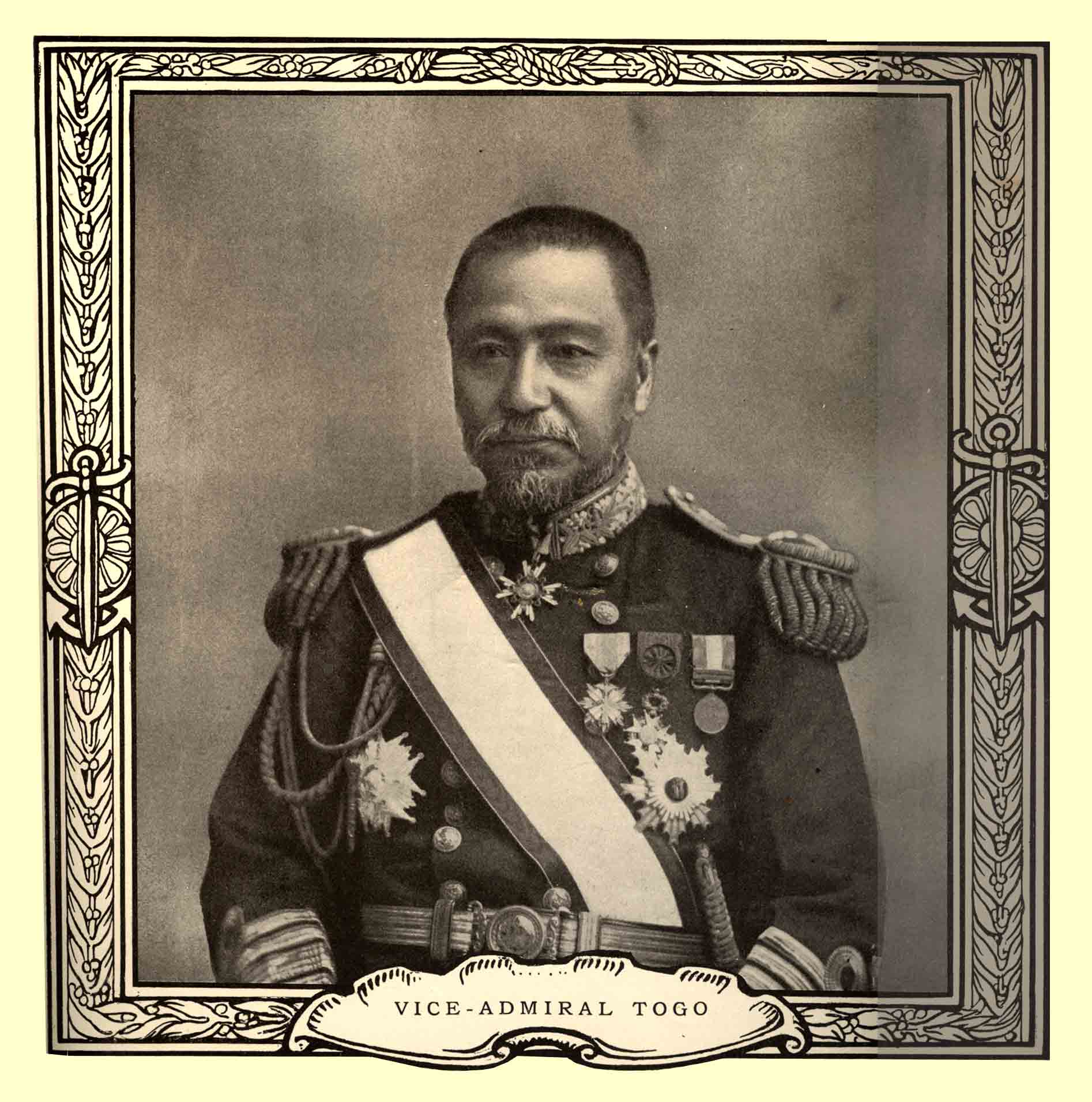
This silk pillow case, available during the fleet's visit shows and lists the ships of Commodore Perry's famous visit to the Bay of Yedo on the 8th of July, 1853.
At right is a detail from the pillowcase showing the ten warships of Commodore Perry's fleet.
The postcard at left was issued during the fleet's visit showing a sketch that was made of the "Treaty House Banquet" that was given in honor of Commodore Perry during his visit.
This image was part of the works by S. Nicolson of the U.S. Navy in "Commodore Perry's Voyage to the East."
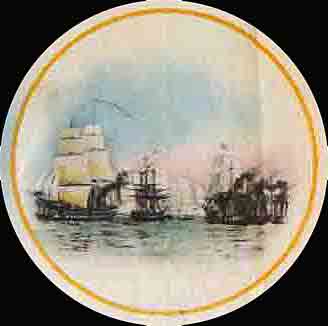
official program for the reception of the americal fleet at yokohama and tokyo
This is the official program that was published for the Fleet's visit. It has the entire program of events during there 8-day stay in both English and Japanese. (I have only included the English portion in my scan). All of the events, including dinners, receptions, garden parties, and luncheons are included. My favorite part is on the inside cover where the provide a tale of the "mates" of the ships as they were organized in the harbor and for events.
the imperial government railways free pass issued in honor of american fleet
In celebration of the American Fleet visit, the Imperial Government Railways issued passes for use by their guests. There were two types, one for the bluejackets and one for the officers and dignitaries. This one is for an officer or dignitary and includes a thick felted carrying pouch, wallet type fold-out with embroidered flowers and image of scenic garden. The pass allows the holder to ride in "First Class Carriages" for any number of times. This set came with an unusual card for "Rear Admiral C. P. Snyder," with a Japanese flag. The letter are typed on the card and it appears to be the intended precipitant of the rail pass. Charles Philip Snyder, graduated 4th in his class from the Naval Academy in 1905 and was a Lieutenant on the USS Vermont during the cruise around the world. He was promoted to Rear Admiral in 1933. In 1940 he became a four-star admiral being replaced by Kimmel 11 months before Pearl Harbor.
I believe that this card was in his personal effects and when someone was putting things together saw the Japanese flag on the card and felt it belonged with the booklet. However since he was only a Lieutenant at the time this is not the case.
The card is probably from during the period of 1932 to 1934 when he was Chief of Staff, Commander Battleships, Battle Force, U.S. Fleet, or Commander in Chief, U.S. Fleet.
From 1942 to 1946 he served as the first Naval Inspector General. He investigated the sinking of the Indianapolis. He is buried in Arlington National Cemetery.
The below series of card was issued for both Japanese and American collectors showing the battleship and the Captain or Squadron Commander. I have only found 16 to date, but every now-and-then a new one turns up.
american friends association
On Thursday, October 22, 1908 Prince Tadashige Shimadzu hosted a lunch which included live music by the Naval Band. Tadashige was a naval officer that rose to the rank of Rear Admiral.
On Friday, October 23, 1908 Viscount Kaneko, President of the American Friends Associated hosted a dinner at Koyokan Tokyo. Kaneko was born into a samurai family attended Harvard University and lectured at Tokyo University. He was a special envoy to the United States during the Russo-Japanese War. He was instrumental in arranging President Roosevelt to assist in the treaty between Japan and Russia.
the yokohama boyeki shimpo
At right is a insert to the local Yokohama newspaper, the Yokohama Boyeki Shimpo from October 17, 1908 which summarizes a list of comments make by various prefectures regarding the visit of the American Fleet. The appear to be quotes from other papers from around the country, "TOKYO, Welcome, right welcome the American Battleship Fleet! The Yomiuri greets you with the highest enthusiasm and most cordial appreciation of your visit." To see the entire front page click on the image at left.
scenes from yokohama
cards of the decorations for the fleet
the hibiya park cultural exchange
On Thursday, October 22nd, the Mayor of Tokyo entertained the fleet in Hibiya Park, the central park next to the emperor's palace. The event was planned for the officers and men to be able to walk around and enjoy entertainment and food from buffets that were set up as station around the park. In the main area of the park, striped tents were set up that had different demonstrations of the art and culture of Japan. Sailors were treated to 25 platforms that provided entertainment of every sort. Sword dances, martial arts, jugglery, clowns, athletic feats, and dancing by the geisha girls. And sailors got all the food and drink he could hold under the large tent. Below is the original map of the event, and to the left, the invitation and program.
the tokyo railway company
The first streetcars of Tokyo were designed to hold upt to 40 people. They were built of wood and ten windows on both sides and poles for standing passengers. Originally pulled by horses, by 1904 they were electrified and extended throughout the City of Tokyo. Three companies provided services, Tokyo densha tetsudo, Tokyo shigai tetsudo, and Tokyo denki tetsudo. Each company painted there streetcars of different colors. In 1906 they were all consolidated under the Tokyo Railway Company and nationalized. There were 110 miles of streetcar lines in 1906 and planned to grow to 27 miles by 1910.
This was the primary means for Fleet sailors to travel any distance while on liberty. Railway passes were given out to all members of the American Fleet upon arrival. Railcars were decorated for the occasion and were popular photography subjects.
Government commomerative cancellations for the fleet visit
The primary cancellation used for the fleet visit was the "18-24 October 1908 Commemoration of Visit of American Fleet." There were four stations that used this cancel for the fleet's visit Tokyo (Tokio), Yokohama, Kamakura, and Kurihama. The last two being more difficult to find.
cards and photographs from Hybiya park
This event took place in the main park in downtown Tokyo, still there today. Sailors were brought there by the rail and treated to different shows all day. Food and Beer was provided. In the main area of the park, striped tents were set up that had different demonstrations of the art and culture of Japan. Sailors were treated to 25 platforms that provided entertainment of every sort. Sword dances, martial arts, jugglery, clowns, athletic feats, and dancing by the geisha girls. And sailors got all the food and drink he could hold under the large tent. Below are photographs and postcards from the event.
The transportation of royality
The Admirals of the Fleet were treated like royalty in Tokyo and driven in carriages with their Japanese counterparts. Sailor we directed to proceed in formation to and from events so as not to look disorganized and to keep control of them
Admiral Sperry riding in official porty provided by the Japanese government. The first card shows him passing by the Welcome arch in Tokyo, the second on the grounds of the Imperial Palace.
cards of the fleet
Karl Lewis (1865-1942) was an American who sailed the seas and ended up in Yokohama running a Meiji-era photography studio. He studio produced photographs and postcards for sail to the fleet. As with the two cards at right, he combined the traditional tinted card with a bit of Yankee humor. He married a young Japanese girl and later is famous for hand-painted covers from throughout the Pacific. In WWII he was in his 70s and tossed in jail as a spy for all of his mailing around the world. He was release and later that year died. His work was from all sides of the spectrum of photography, but he is most remembered for his "The Laughing Geisha."
Below are original photographs from his studio of the American Fleet in the Harbor.
American pacific squadron postcards
This series of real photo postcards show the American Fleet at anchor in Tokyo Bay. Each card has the American flag in the upper left or right corner with the ships name below.
An additional agreement that had been worked out was that American would send the entire fleet to Japan and only half the fleet to China as a show of recognition to Japanese strength in the region. Japan had insisted that the whole fleet be received in Yokohama or nothing at all and felt sending the whole fleet to China would signal she was of equal importance.
Additionally, the Japanese viewed the Cruiser Fleet at Samoa, while the Battleship Fleet was in Yokohama a gesture of hostility. Roosevelt ordered the cruisers home before the fleet arrived in Yokohama, aware that he was maybe outnumbered and potentially out-classed by the Japanese Navy and chose to make concessions verses create conflict.
Postcards with cachets were popular. There were more publishing companies putting out cards for the fleet's visit then anyone could keep track of or collect.
Many of the cards were for the captains and the admirals. as below, where two cards include Admiral Goro Ijuin, who was famous for his leadership during the Russo-Japanese War.
Admiral Sperry was paired with Roosevelt and Ijuin, although not always with the best likeness as in the pale blue card.
On Tuesday, October 20th one of the big dinner events was planned at the Navy Club in Tokyo. The food was French and the tables were long. The above seating chart measures 20" x 30" to show for 86 people at each table, a planned dinner for over 250 business and military guests. It was a mixture of American and Japanese and included American Army Officers in the crowd. Guests included the Governor of Tokyo, Admiral Sperry and all of the Ship Captains, Admiral Togo, The Admiral of the Fleet Count Ito, and an array of other senior dignitaries. Baron Makoto Saito was the guest speaker for the evening. Above is his speech.
Saito graduated from the Imperial Japanese Naval Academy and in 1884 went to the United States to study as a military attache. In 1893 he served as executive officer on the cruiser Izumi and then on the battleship Fuji. Saito was Vice Navy Minister at the start of the Russo-Japanese War and was promoted to Vice Admiral. In 1906 he was awarded the Order of the Rising Sun (1st class). At the time of this speech he was serving as Navy Minister and later promoted to full Admiral.
His speech was on-point, "Five and Fifty years have passed since Commodore Perry came with four warships and knocked at our doors." "Our minds strengthened by this guarantee of peace, are enabled quietly to pursue our calling."
commemorative cards
Welcome Decorations for the American Fleet
This is a series or real photo postcards showing the elaborate decorations for the arrival of the American Fleet. The cards do not indicate a publisher, but all of them have a little "dragon fly" in the lower right hand corner, all are labeled "Welcome Decorations for American Fleet", and all have their information about the location of the photograph in Japanese. It would be nice to get some help from a Japanese collector to translate these 🙂
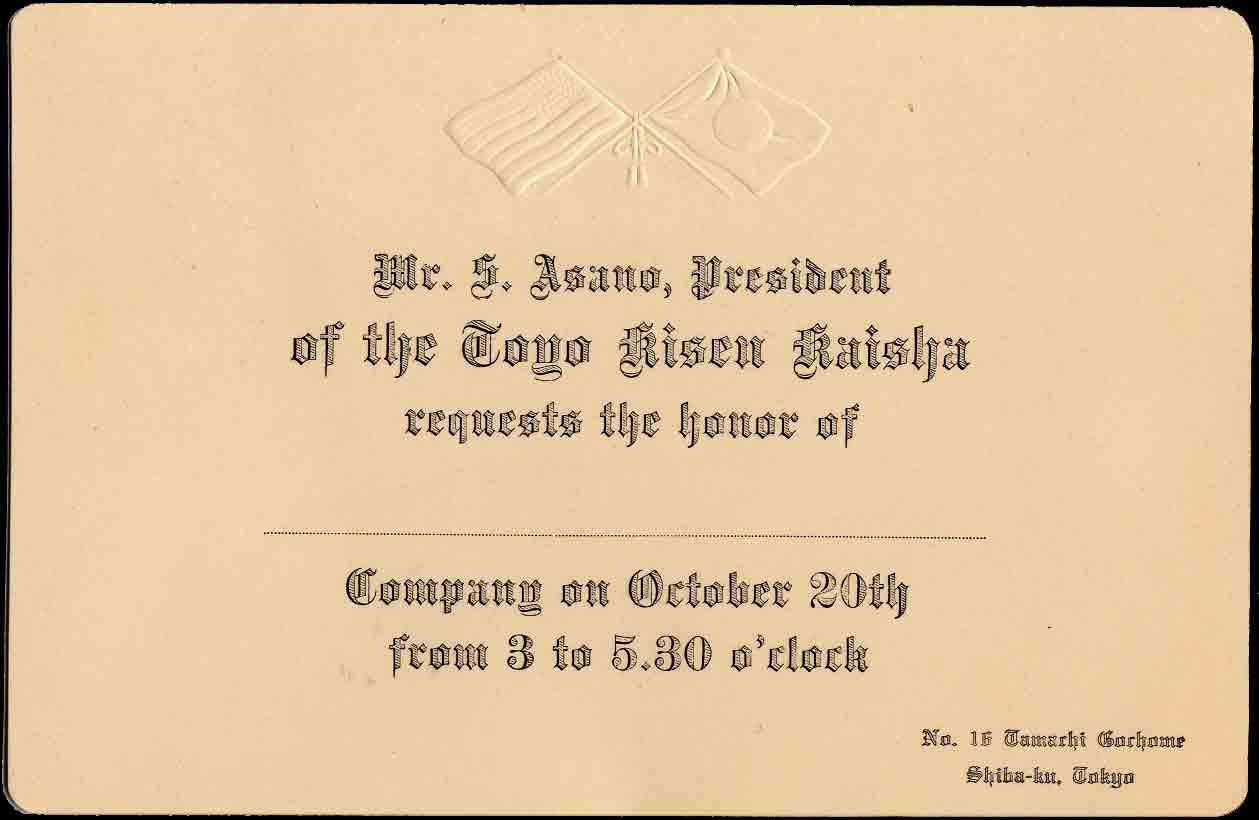
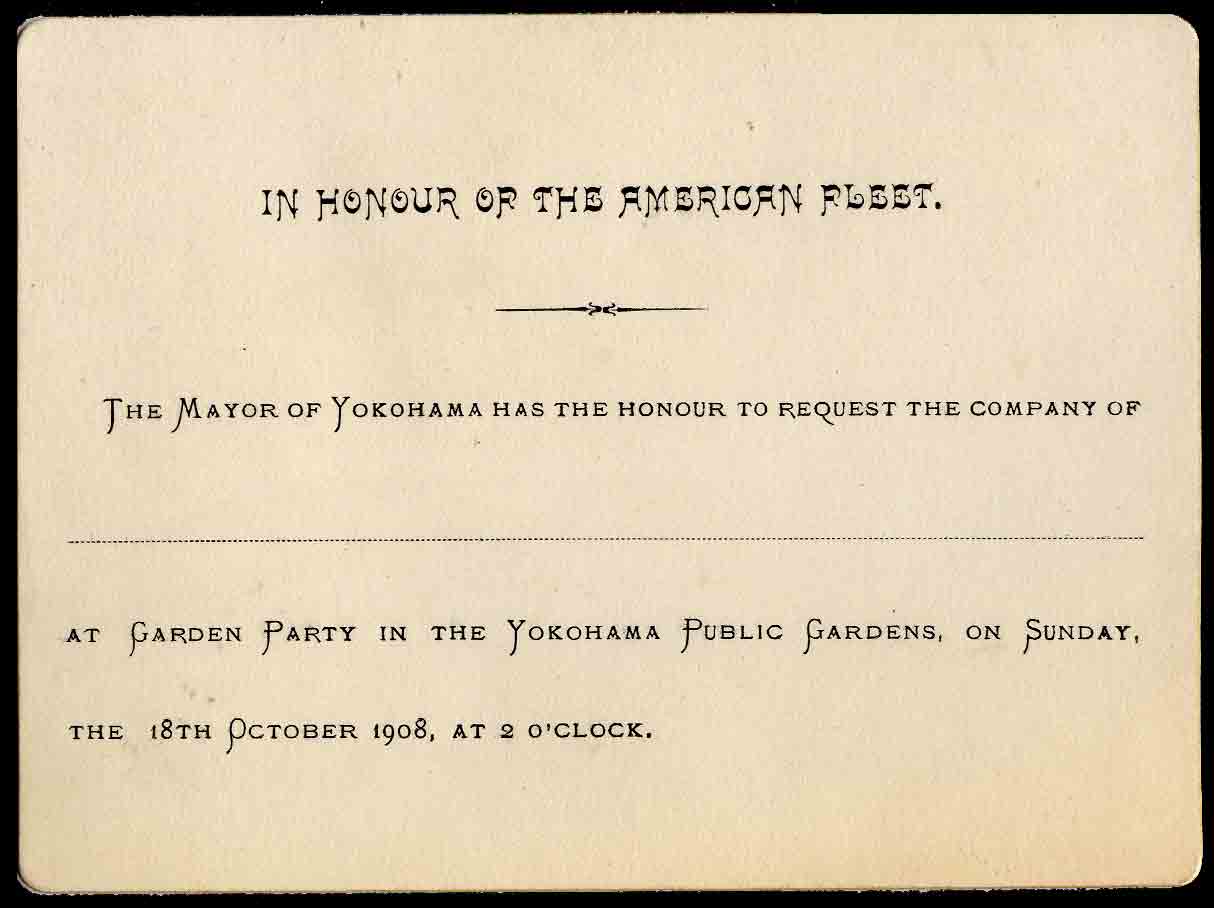
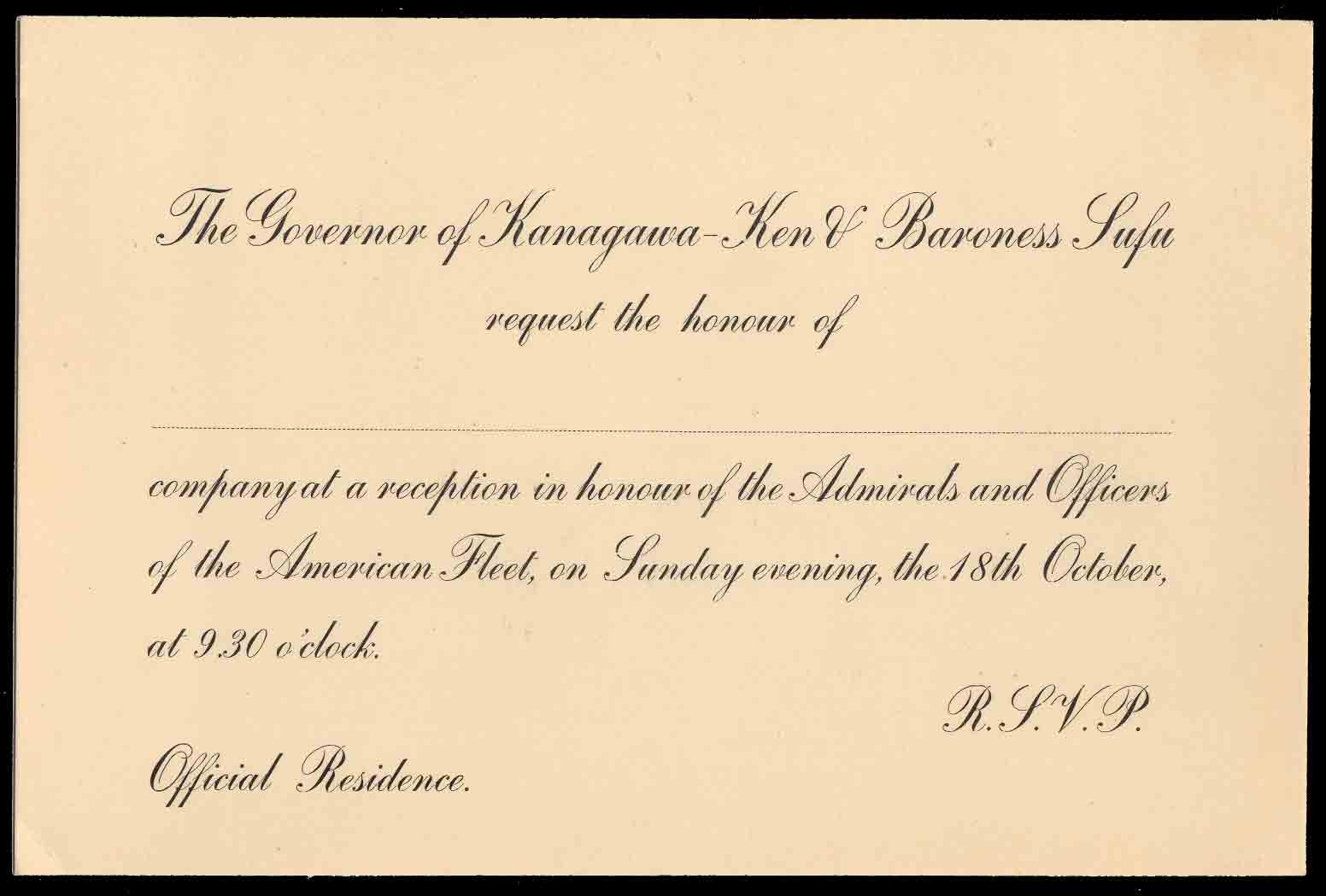
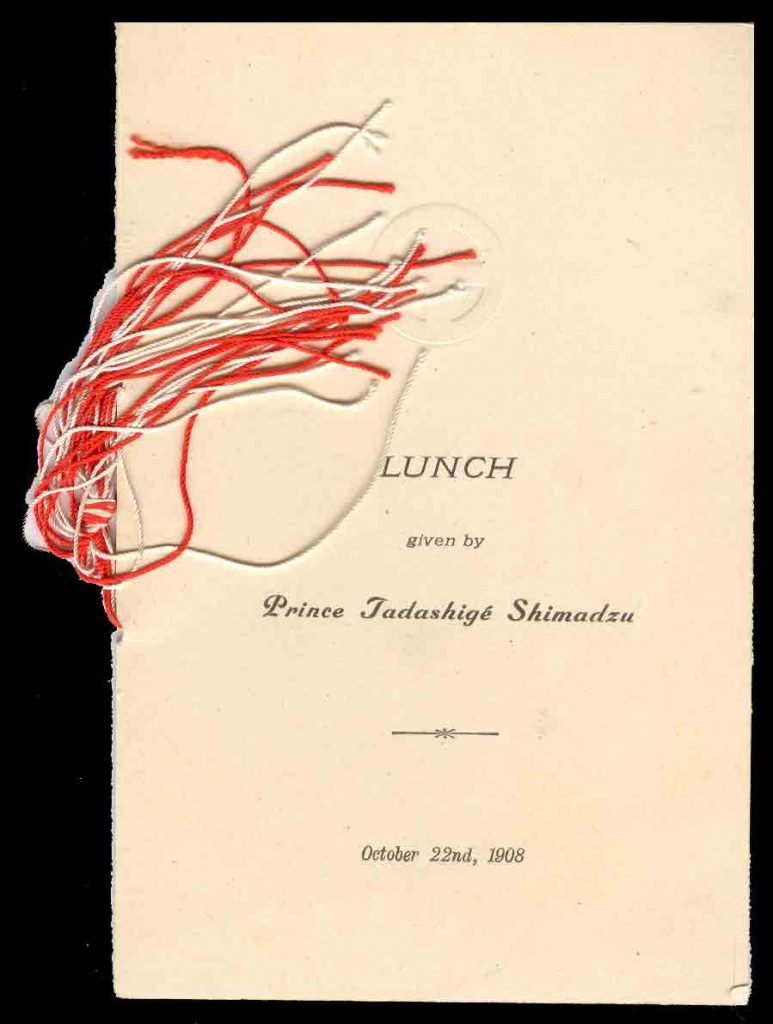
For the officers of the fleet there seemed to be no end to the luncheons, garden parties, and dinners. Laundry services were hurried to turn around dress uniforms in hours to provide for clean, pressed uniforms.
Above, The Governor of Kanagawa reception invitation, the Mayor of Yokohama garden party, and the President of the Toyo Kisen Kaisha afternoon party. At left, lunch with Prince Tadashige Shimadzu and at right Dinner with Viscount Kaneko, President of American's Friends Association. RSVP please!
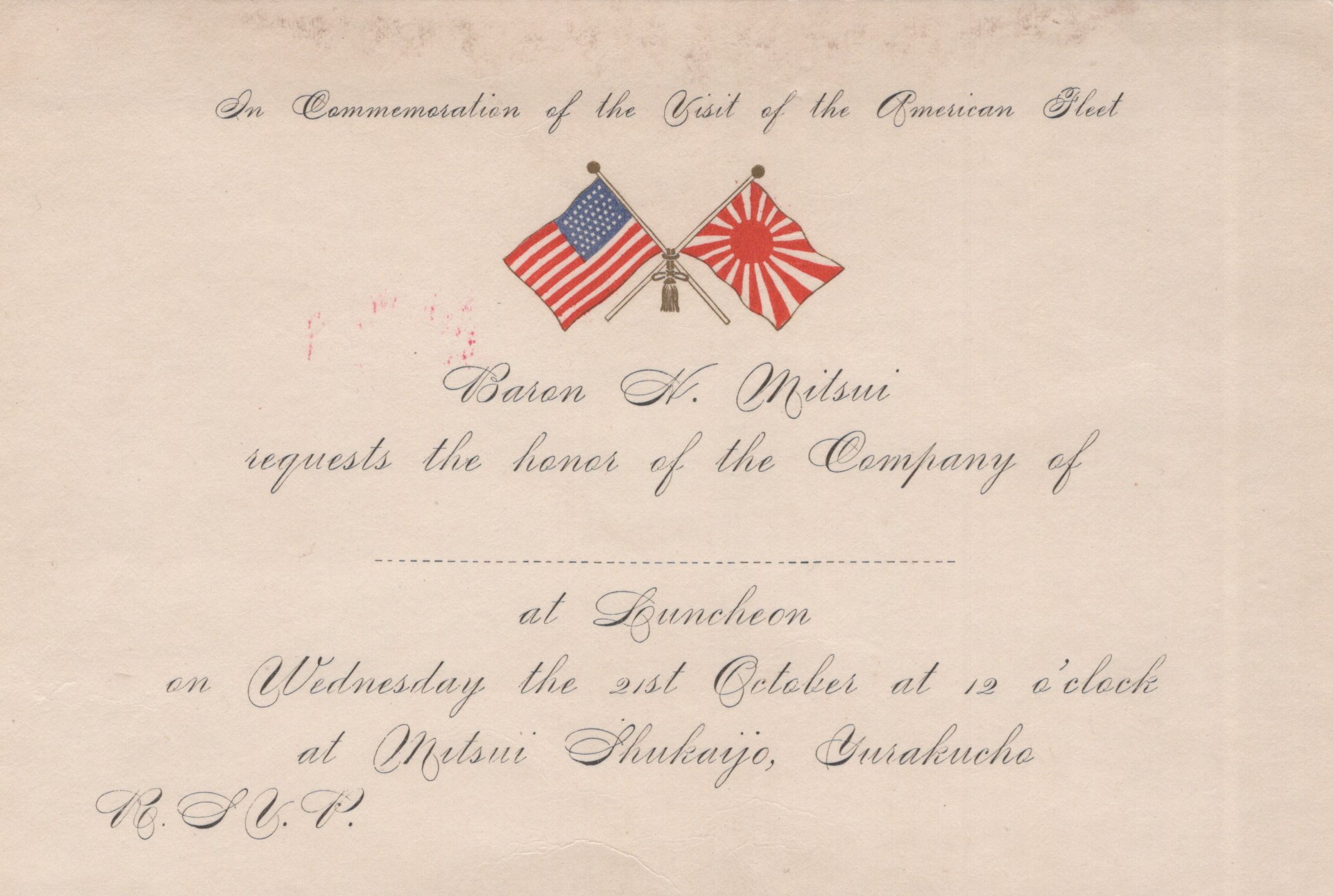
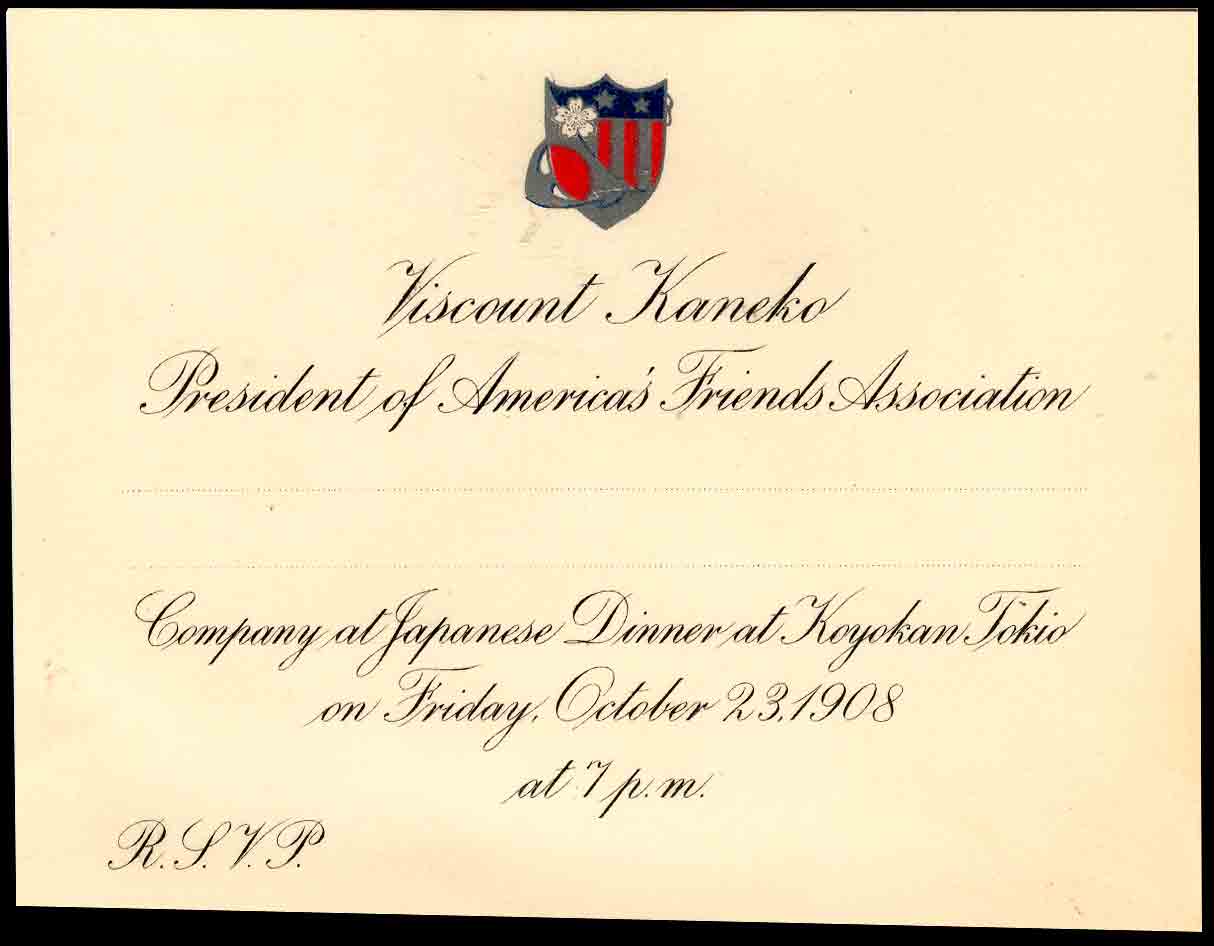
For an officer of the fleet it was difficult to discern which event to attend, or to attend any? The invitation were enough to consume their entire time ashore without having a chance to see the sites.
To the left is an invitation received by Midshipman Lofquist from Baron H. Mitsui inviting him to a Luncheon on Wednesday the 21st at 12 o'clock at Mitsui Shukaijo, Yurakucho. RSVP
admiral togo garden party
On October 21st at 3 pm in the Shinjuki Imperial Gardens, Admiral Heihachiro Togo had a garden party which was the social event of the cruise. The party was planned for the Imperial Gardens at the Palace in Tokyo. The Naval hero of the Russo Japanese War was recognized world-wide as one of the greatest naval tacticians in history and to be invited to his luncheon was a great honor.
At left is a rare Japanese pin with flags given to his honored guests at the event. This one was given to 1st Lt William Hopkins. Hopkins had taken part in the relief of Peking during the Boxer Rebellion of 1900, fighting alongside Japanese Marines in that action, as part of the 1st Battalion, 1st Regiment, Company H, one of 18 officers and 300 men who were victorious that day.
It is in the original camphor wood box (lid not shown) with makers mark and inscription on back in pencil "Admiral Togo's Reception". The small ribbon pins alongside were for a woman if accompanying the man, one is a combination of the British and American Flags (British Officers were present)
the japanese tea hall at the yokohama railway depot
This card extended an invitation from the Japan Central Tea Traders Association to visit the Japanese Tea Hall where they would be served tea free of charge.
"Trusting that you will favor us with a visit whenever convenient, we have the honor to be your obedient servants."
This is an original piece from a collection of items brought back by Midshipman Lofquist, USS Connecticut. The Tea Hall was located on the grounds fronting the Yokohama Railway Depot arranged for the American Fleet providing a place to stop and relax with a cup of team when they were at the station waiting for a train.
The envelope and cards below were compliments of the Imperial Government Railway providing round-trip tickets to Tokyo on the train to sailors of the American Fleet during their visit.
the welcome arches of tokyo and yokohama
The image above shows the official pier where launches from the fleet would disembark passengers. The pier has been decorated for the fleet's visit and shows an official party of officers and men going ashore. Below is Rear Admiral Wainwright and Rear Admiral Emory, 2nd and 3rd Division Commanders walking in the park in Tokyo. The card misidentifies them as "Commandant" Sperry.

